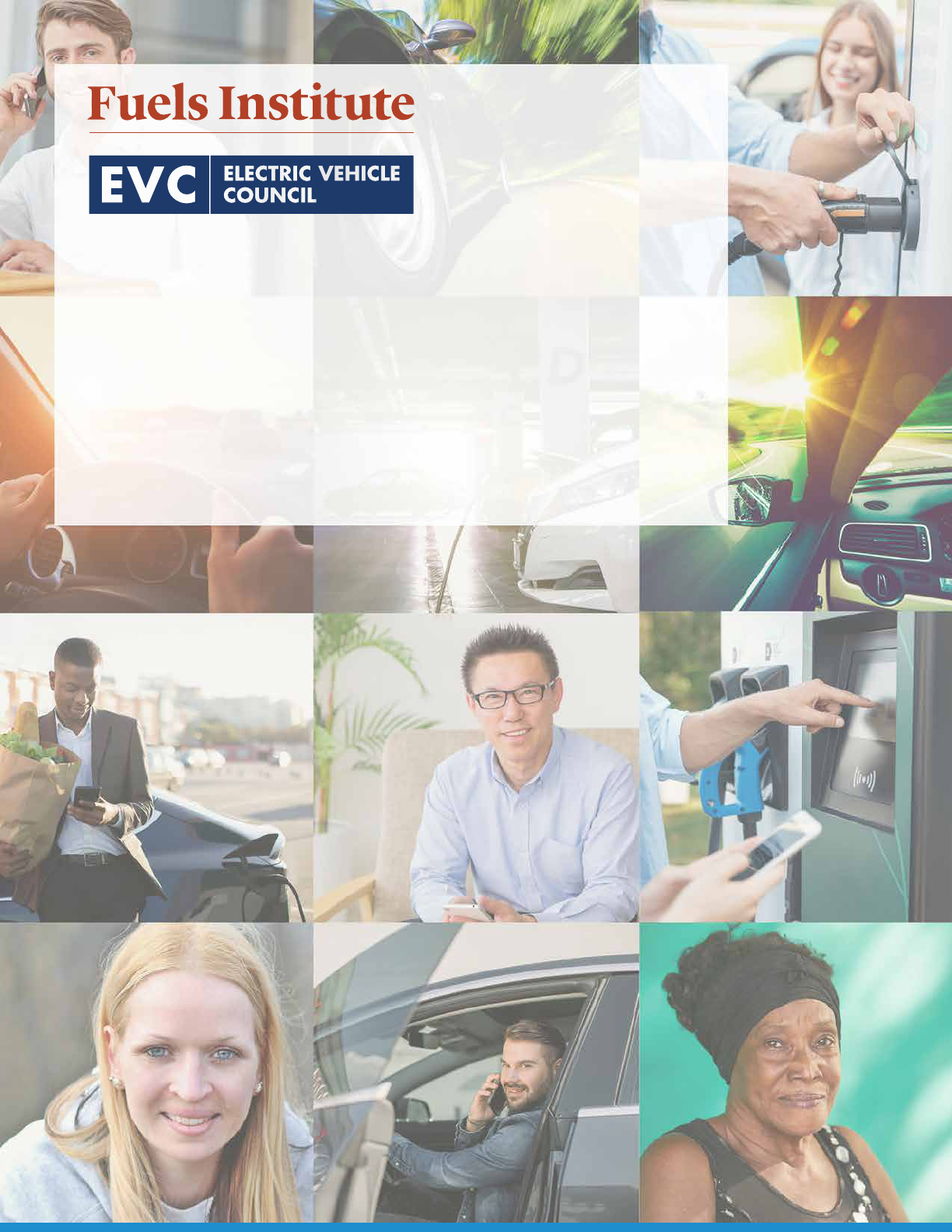
EV Consumer
Behavior
JUNE 2021

Ricardo Inc.
Detroit Technical Center
Van Buren Twp., MI
48111 USA
©2021 Fuels Institute
Disclaimer: The opinions and views expressed herein do not necessarily state or reflect those of the individuals on
the Fuels Institute Board of Directors and the Fuels Institute Board of Advisors or any contributing organization to
the Fuels Institute. The Fuels Institute makes no warranty, express or implied, nor does it assume any legal liability
or responsibility for the use of the report or any product or process described in these materials.

1
Ricardo Strategic Consulting
(“Ricardo”) conducted a literature
review to better understand how and
where consumers drive and recharge
their electric vehicles (EVs) and what
they would like to experience while
recharging in terms of site design,
amenities, capabilities, and services.
Ricardo has also analyzed existing literature to
both understand current consumer behavior and
anticipate how it could evolve over the next 10 years
as more consumers purchase EVs. This exercise has
been focused on answering five questions:
1. Who is the customer?
2. When and where does the customer recharge?
3. Why does a customer choose a particular
recharging facility?
4. How do customers interact with
charging equipment?
5. What do customers do at facilities
while charging?
This literature review included various publicly
available sources such as existing Ricardo research
on consumer preferences; published surveys;
federal, state, and local government publications;
cross-functional organization publications; scholarly
articles; university/institute publications; national
lab publications; public policies; and press reports.
This was supplemented with persona interviews to
exemplify findings.
Key findings that emerged from the literature review
are below:
Who is the customer?
• The top demographic of 2019 EV owners are
middle-aged white men earning more than $100,000
annually with a college degree or higher and at least
one other vehicle in their household.
• 37% of Democrats and 34% of Republicans
appear to view EVs positively, and a guaranteed
$7,500 tax rebate could make 78% of Democrats
and 71% of Republicans more likely to consider
an EV during their next purchase or lease (2019).
FUELS INSTITUTE
EXECUTIVE SUMMARY
Electric Vehicle Consumer Behavior

2
FUELS INSTITUTE | EVC | EV CONSUMER BEHAVIOR
• EV sales have grown exponentially over the past
10 years; however, the ownership demographic
has remained relatively the same. The average EV
owner continues to be male, aged 40-55 years old,
with an annual household income of more than
$100,000 (2019). Mileage driven, however, has
increased from 100 miles to 250 miles a week over
the years.
• In the next 10 years, EV sales are expected to
constitute between 12% and 40% of all light-duty
vehicle sales, implying that:
• EV buyer age could normalize with the broader
new vehicle buying trend
• EVs could become more aordable
• Number of EV buyers with no provision to
charge at home could increase
• Driving pattern is expected to be similar to the
way internal combustion engine (ICE) vehicles
are driven
• Gender distribution could become more
balanced
• EV fleet sales are expected to grow in the
upcoming years, driven by state mandates.
• Household income, family size, age, driving
distance, geographical location, and type of
residence tend to influence EV ownership.
• Total cost of ownership (TCO) and payback
period are the key drivers in a business’ decision
involving adoption of EVs in their commercial fleet.
• Aordability, availability, and familiarity appear
to be amongst the key factors influencing
likelihood of EV purchases.
• EV trips are mostly planned with charging
locations in mind, unlike conventional vehicles;
however, more daily miles are driven on average
in an EV (2020) than in an ICE-powered vehicle.
When and where does the customer recharge?
• EV drivers tend to recharge daily or once every
two days, typically overnight at home, and
overall, about 70-80% of charging occurs at home
or at a workplace parking lot.
• Most EV fleet customers today (2020) operate in a
hub-and-spoke network and exclusively recharge
their vehicles overnight at their home base.
• The most used public chargers are those where
vehicles are typically parked for long periods
(e.g., airport parking lots, grocery store, etc.)
(2012-2014).
• Most customers drive within their battery range
only, using a public charger when making trips
longer than their range would permit.
• Drivers of ICE vehicles fill up based on the cost,
necessity, and time of the day; 32% only fill
up when they see the fuel warning light in the
dashboard (2019).
• Nonavailability of chargers at home and making
trips longer than the battery range are two of
the various reasons why drivers use public
charging stations.
• EV charging stations spaced 70 miles from each
other on average could provide convenient access
to battery electric vehicle (BEV) drivers across the
interstate system (2017).

3
FUELS INSTITUTE | EVC | EV CONSUMER BEHAVIOR
Why does the customer choose a particular public
recharging facility?
• EV drivers tend to base their choice of public
chargers on various factors, including: speed of
charging, need for charging, brand of the charger,
compatibility with the electric vehicle supply
equipment (EVSE), dependability, availability,
identity of charging host/facilities available
(e.g., grocery store, gym, etc.), payment options
available, and app/in-car interface suggestions.
• Dependability, convenience, cost of use, and
the need to travel beyond the EV’s battery range
appear to have the greatest influence in the
choice of charging location (2011-2019).
• Approximately 75% of today’s non-Tesla drivers
feel the current charging network is “somewhat”
or “very adequate” (2017).
• Approximately 46% of BEV drivers (2016) feel
availability of direct current fast charging (DCFC)
as a feature is not a very big influencer in their EV
buying decision.
• More than 80% of EV drivers use three charging
locations or fewer away from their home, where
they do most of their charging (2011-2014).
• The drivers’ decision in picking a brand of charger is
influenced by factors such as favoring the provider
of the default EV charge card (e.g., Hyundai Ioniq
has a ChargePoint card in the glovebox). Other
factors include being of the same brand as their
home charger, dependability of the network, avail-
ability in their primary area of operation of the
vehicle, and availability at the places they visit oen.
• Fewer than 5% of EV owners rely on smartphone
applications (“apps”) to find charging stations for
daily use, although many EV owners likely have a
charging app on their smartphone. Tesla models
have point-to-point trip planning with charging
integrated in the vehicle, and it is likely other
original equipment manufacturers (OEM) will
follow (2020).
• Today’s EV owners are not deterred by the
deficits of the current EV infrastructure and have
found ways around the limitations, but for mass
adoption, it is critical to understand views of
buyers who are not considering buying an EV
today (2020).
• How do customers interact with charging
equipment?
• Approximately 57% of surveyed EV drivers are
willing to pay a premium over at-home charging
rates to use a public Level 2 charger, and more
than half of EV drivers are willing to pay more
for DCFC compared to Level 2 charging when
convenient (2020).
• EV drivers preferred optimized charging and to be
billed by the kilowatt-hour (kWh) to attain a good
balance of cost and time (2016).
• Approximately 77% of people used mobile
payments last year, including 80% of 35- to
50-year-old U.S. residents; all top charging
network appear to support mobile
payments (2019).
What do customers do at facilities while charging?
• Plug-in electric vehicle (PEV) consumers expect
to spend 30 minutes to one hour at the charger
(2019-2020). Some other studies/surveys suggest
that this consumer would prefer an event (15
minutes or less) to minimize downtime in their
daily routine. Grocery store visits, dining, and
shopping are the most preferred activities while
waiting for their EVs to be charged.
• Broadly, free charging while shopping tends
to increase dwell time. Kohls found that when
provided with free charging, EV owners spend
about $1 per minute within an hour window (2015).
• PEV drivers appear to prefer to run errands or to
be entertained while charging their vehicle at a
public charger (2019).

4
FUELS INSTITUTE | EVC | EV CONSUMER BEHAVIOR
EXECUTIVE SUMMARY ....................................................................................................................................................01
INTRODUCTION
....................................................................................................................................................................... 06
Literature Study Context
...............................................................................................................................................................................06
Objective of the Study
................................................................................................................................................................................... 07
Personas
...................................................................................................................................................................................................................08
METHODOLOGY
......................................................................................................................................................................09
PROJECT REPORT
..................................................................................................................................................................10
Who Is the Customer?
...................................................................................................................................................................................10
Demographics
........................................................................................................................................................................................10
Evolution of EV Buyer Demographics and Behavior Over the Past 10 Years
.........................................16
Anticipated Evolution of EV Buyer Demographics and Behavior Over the Next 10 Years
..........18
Demographic Characteristics and Their Relationship With EV Ownership and Behavior
............20
Difference in Trips Taken in EVs Versus Liquid-fuel Vehicles
.................................................................................21
When and Where Does the Customer Recharge?
...................................................................................................................22
EV Drivers’ Charging Frequency
.............................................................................................................................................. 22
EV Drivers’ Preferred Recharge Location
...........................................................................................................................24
Factors That Influence a Recharge Occasion
.................................................................................................................. 26
Charging Infrastructure Requirement
.....................................................................................................................................27
Why Does the Customer Choose a Particular Public Recharging Facility?
............................................................28
Level 2 Charging Availability’s Influence on Consumer Perception of Availability,
Capacity, and Convenience Compared to DCFC Equipment
............................................................................. 28
Influence of Charging Equipment Brand
............................................................................................................................30
How Do Customers Interact With Charging Equipment?
....................................................................................................32
EV Consumers’ Willingness to Pay for Charging Services and the Influence of Price
in This Perception
................................................................................................................................................................................32
EV Consumers’ Perception of Various Billing Methods
............................................................................................34
EV Consumers’ Comfort With the Various Payment Options
..............................................................................36
What Do Customers Do at Facilities While Charging?
........................................................................................................38
Dwell Time at Public Chargers and the Features That Could Influence That Dwell Time
................38
Features and Amenities That Are Most Desired by EV Drivers, Used During a Charging
Session, and That Could Influence Drivers to Use Charging Stations Frequently
................................41
Features and Amenities That Yield the Greatest Influence Over an EV Driver’s
Decision Regarding Where to Charge
................................................................................................................................42
Contents

FUELS INSTITUTE | EVC | EV CONSUMER BEHAVIOR
5
PERSONA FINDINGS ......................................................................................................................................................... 45
Michael: Affluent Middle-aged White Male With BEV As Secondary Vehicle Living in the
California Bay Area With Access to At-home Charging
.....................................................................................................44
Shou: Affluent, Middle-aged Asian American Male With BEV As Secondary Vehicle Living
With At-home Charger Who Frequents a Metropolitan City
............................................................................................ 46
Raj: Middle-class Young Male of Indian Heritage With BEV As Primary Vehicle for a 20-mile
Commute Who Lives in an Apartment Building With Shared Chargers
..................................................................48
Millicent: Elderly Environmentally Conscious Female on a Fixed Income With a BEV As a
Primary Vehicle With an At-home Charger
...................................................................................................................................50
Amy: Businesswoman Who Drives a Work Truck and Could Potentially Buy an Electric Truck
........... 52
CONCLUSIONS
.........................................................................................................................................................................54
APPENDIX
......................................................................................................................................................................................55
Acronyms and Abbreviations
................................................................................................................................................................... 56
Bibliography
.........................................................................................................................................................................................................57

FUELS INSTITUTE | EVC | EV CONSUMER BEHAVIOR
6
INTRODUCTION
The Fuels Institute commissioned Ricardo Strategic
Consulting (“Ricardo”) to review existing literature
to better understand how consumers drive, where
they recharge their EVs, and what they would like
to experience during a recharging occasion in terms
of site design, amenities, capabilities, and services.
In addition to this, the study seeks to understand
consumer behavior today and anticipate how
it might evolve over the next 10 years as more
consumers purchase EVs.
Fuels Institute is a not-for-profit organization
led by a collaborative group of fuel retailers, fuel
producers and refiners, alternative and renewable
fuels producers, automobile manufacturers, and
others with expertise in the fuels and automotive
industries. The Institute delivers comprehensive
and balanced research and analysis concerning
fuels, vehicles, and related policy issues. The Electric
Vehicle Council is a project of the Fuels Institute
comprised of organizations seeking to eliminate
confusion and provide guidance for success
relative to the installation and operation of retail EV
charging stations through stakeholder collaboration,
objective research, and market education. Ricardo
has aligned its research and opinions in this report
to a similar unbiased philosophy.
LITERATURE STUDY CONTEXT
The market for EVs is expanding, and there is
significant need for charging infrastructure. To
ensure that the infrastructure satisfies the needs
and interests of EV drivers and site hosts alike, it is
important to understand what those drivers want
and how they would use the infrastructure. This
information would be particularly useful to charger
operators to help design appropriate facilities.
Furthermore, as the EV market grows, the
demographic profile of the EV driver is likely to
change and become more diverse. The diversity
of future EV drivers could require dierent designs
and amenities to support the various demands of
the consumers. Given that charging systems will
be long-lived assets that could be in use 10 years or
longer following installation, it is essential to better
anticipate how drivers will use these systems to
ensure the designs remain relevant to driver needs
throughout their expected useful life. This literature
review is intended to identify trends in EV consumer
behavior today, how it has evolved over the past 10
years, and how it could evolve in the next few years
to align with the goal of anticipating how drivers will
use these systems over the life of the systems.
Ricardo has found that most of the existing research
on EV charging preferences is conducted with
current EV owners and potential buyers. These
owners are likely to use, or work around, the existing
infrastructure even with sub-optimal charging
speed, density, or site design. Identifying charging
preferences of the buyer who is not yet considering
EV purchase will be equally important to future
infrastructure. This report cites existing literature.

FUELS INSTITUTE | EVC | EV CONSUMER BEHAVIOR
7
OBJECTIVE OF THE STUDY
In order to understand consumer behavior today, in
the past 10 years, and expected trends over the
next
10 years, this report has been structured to answer
the
following broad questions and their sub-questions:
Who is the customer?
• What is the demographic profile of today’s EV
drivers? How does this compare to the population
at large, how has it evolved over the past 10 years,
and how might it evolve over the next 10 years?
• Which demographic characteristics most
influence EV ownership and behavior?
• How do trips taken in an EV dier, if at all, from
those taken in a liquid-fueled vehicle?
When and where does the customer recharge?
• With what frequency do EV drivers recharge their
vehicles? Where do consumers recharge their
vehicles? What are the factors that influence
drivers to initiate a recharging occasion? How
does this behavior compare with drivers of
liquid-fueled vehicles?
• How oen do EV drivers charge at public stations?
Why do they choose to charge at a public station
versus at home, work, or other locations? What
would encourage them to use public charging
stations more frequently?
• How much charging infrastructure will be
required to service demand compared to the
amount of charging infrastructure required
to provide consumers with suicient comfort
regarding convenient accessibility of chargers?
Why does the customer choose a particular public
recharging facility?
• To what extent does the availability of Level 2
charging influence consumer perception about
charging availability, capacity, and convenience
compared with DCFC equipment? How would the
price of the service influence this perception?
• Is there a dierence in consumer perception
relative to the identity type of the charging
station host, e.g., a restaurant, convenience store,
shopping center, grocery store, parking garage,
public verses private entity?
• To what extent does the brand of the charger
equipment influence selection?
• How oen do consumers use apps to find
appropriate public charging, and will the use of
these apps grow or diminish as EVSE becomes
more available?
How do customers interact with charging
equipment?
• How willing are consumers to pay for
charging services?
• How do they perceive various billing methods?
• How comfortable are they with various
payment options?
• Do their perceptions change depending on
the identity of the company initiating the
transaction?
What do customers do at facilities while charging?
• How much time do drivers expect to spend at a
charging station, and what facility features would
influence that expected dwell time?
• Which facility features and amenities are most
desired by EV drivers and used during a charging
occasion? How does this change with variations
in dwell time? Which features or amenities yield
the greatest influence over an EV driver’s decision
regarding where to charge?
• Do EV drivers use facility amenities more or less
frequently than other customers at the facility?
• How much money do EV drivers spend at these
facilities compared with other drivers?

FUELS INSTITUTE | EVC | EV CONSUMER BEHAVIOR
8
PERSONAS
Personas are created to exemplify predicted individual preferences by conducting internal interviews.
Five personas and their daily habits are outlined below. These have been picked to represent various
demographics, their use cases, and perceptions of EV ownership and charging. Ricardo formed teams of
4-5 individuals to discuss each persona. This structure helps describe individual character choices with
regards to their daily habits and preferences. A short outline of these personas is mentioned below.
Details will be found towards the end of the report.
Michael represents the top demographic of today’s EV buyer: an
aluent, white, 37-year-old man living in the California Bay Area
with the EV as a second vehicle. Michael’s character is chosen to
demonstrate the behavior of a large section of today’s EV owners.
Shou is a 49-year-old Asian American man who also owns an
EV as a secondary vehicle. His travel needs are limited, and he
prefers public transport to driving. Shou’s character serves to help
understand the benefit of owning an EV when car travel is limited.
Raj is a 28-year-old electrical engineer of Indian origin who lives
in an apartment with a common, shared EV charging station. Raj
is much younger than the average age of EV owners, and the EV is
his only car.
Millicent is a 68-year-old African American woman who lives on
a fixed income and owns an EV as her primary vehicle. Millicent’s
character brings to light the reasoning to own an EV as a means to
show her devotion to the eco-conscious ideology. She is one of the
rare examples who does not use fast chargers and charges at home
on a Level 1 charger.
Amy is a 43-year-old white woman who owns her
electrician business and is a prospective buyer of an electric
pickup truck. The total cost of operation of an electric truck
is attractive given her high daily mileage. Her character helps
understand the requirements that need to be met in order to
cater to the prospective buyer that finds the current EV
infrastructure unsatisfactory.

FUELS INSTITUTE | EVC | EV CONSUMER BEHAVIOR
9
METHODOLOGY
In compiling this report, Ricardo has researched
the following:
1. Public domain resources, including
published surveys; federal, state, and local
government publications; cross-functional
organization publication; scholarly articles;
university/institute publications; national lab
publications; public policies; and
press reports
2. Existing Ricardo studies on user preferences
for future mobility (e.g., Ricardo’s ongoing
engagement with the California Air
Resources Board)
1
3. Supplemental persona creation to exemplify
individual preferences
Throughout the report, the terms PEV, BEV, and EV
are used frequently. A PEV within this report refers
to a combination of both plug-in hybrid electric
vehicles (PHEVs) and BEVs. The term PEV is primarily
used when the study particularly involves both
PHEVs and BEVs. The terms BEV and EV are used
interchangeably when referring to BEVs.
The term PHEV, in this report, refers to vehicles that
use batteries to power an electric motor and use
another fuel, such as gasoline, to power an ICE. BEVs
or EVs are defined, within this report, as vehicles that
have an electric motor instead of an ICE.
1 Ricardo, “Ricardo awarded key heavy-duty zero-emissions vehicle project by CARB,” news release, October 24, 2021, https://ricardo.com/news-and-media/news-and-
press/ricardo-awarded-key-heavy-duty-zero-emissions-vehi.
2 “AVTA: The EV Project,” Oice of Energy Eiciency and Renewable Energy, U.S. Department of Energy, https://www.energy.gov/eere/vehicles/avta-ev-project.
The EV Project mentioned in this report refers to the
study conducted by the Idaho National Laboratory
(INL) in partnership with Electric Transportation
Engineering Corporation, Nissan, General Motors,
and more than 10,000 other city, regional, and state
governments, electric utilities, other organizations,
and members of the public.
2
They deployed over
12,000 AC Level 2 (208-240V) charging units and
over 100 dual-port DCFC in 20 metropolitan areas.
Approximately 8,300 Nissan Leafs, Chevrolet Volts,
and smart EQ fortwo vehicles were driven over 125
million miles, and charging-related data for over
4 million charging events was captured between
January 1, 2011, and December 31, 2013. This was
the largest deployment and evaluation project of EVs
and charging infrastructure.
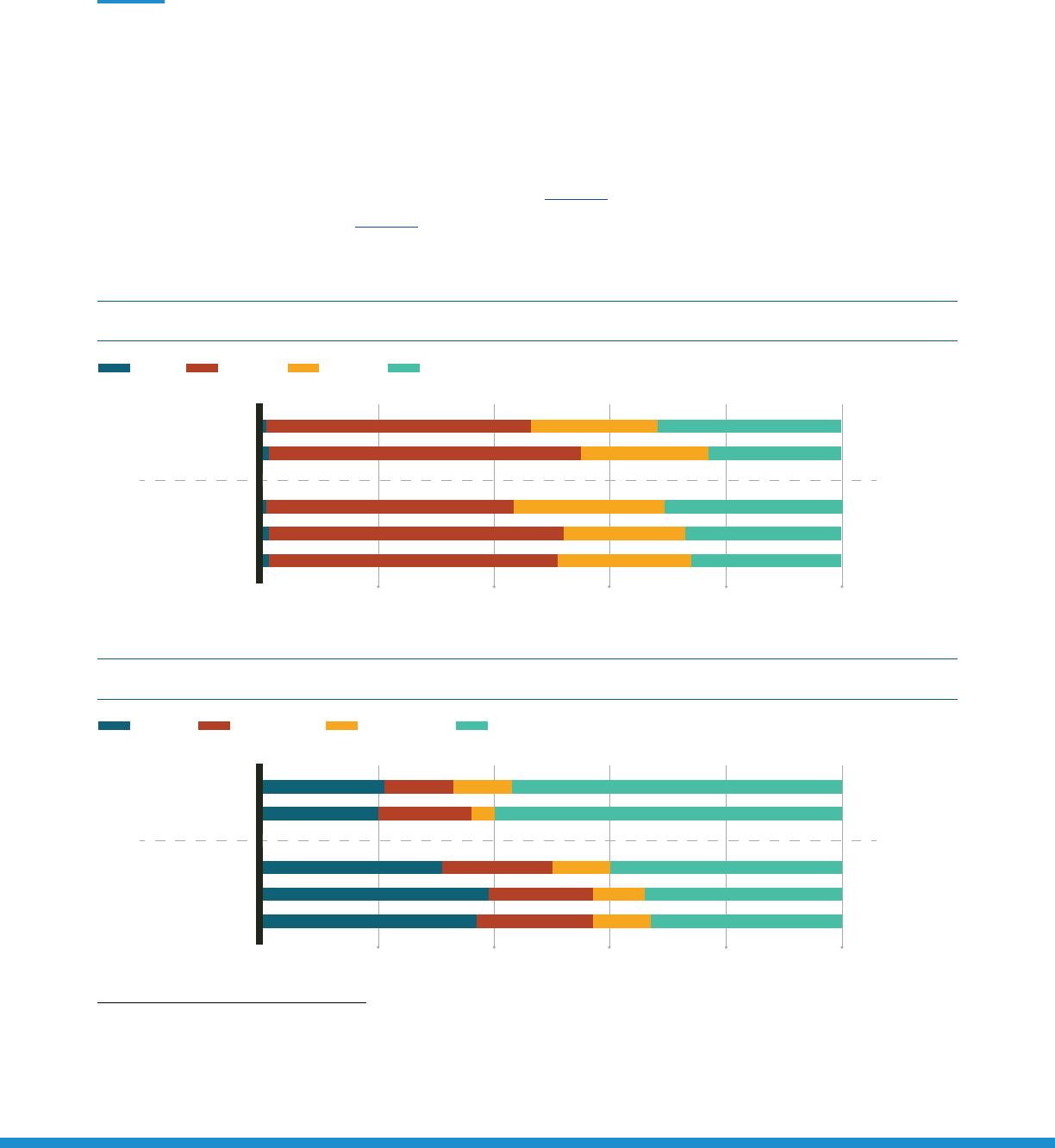
FUELS INSTITUTE | EVC | EV CONSUMER BEHAVIOR
10
PROJECT REPORT
WHO IS THE CUSTOMER?
DEMOGRAPHICS
PEV buyers tend to follow the general trend of new
car buyers. The dominant age group for PEV buyers
across the board is 25-54 years old, according to
Hedges Company’s 2019 survey (Figure 1).
3
3 “New Car Buyer Demographics 2020 (Updated),” Hedges & Company, accessed October 5, 2020, https://hedgescompany.com/blog/2019/01/new-car-buyer-
demographics-2019/.
4 “New Car Buyer Demographics 2020 (Updated)”
5 Christopher Butler, “Electric Vehicle Prices Finally in Reach of Millennial, Gen Z Car Buyers,” CNBC, October 20, 2019, updated: October 21,2019, https://www.cnbc.
com/2019/10/20/electric-car-prices-finally-in-reach-of-millennial-gen-z-buyers.html.
The most dominant annual household income
bracket amongst PEV buyers is “greater than
$100,000.” For conventional vehicles, buyers are
almost evenly split between “less than $50,000” and
“greater than $100,000” annual household income
(Figure 2).
4
The average household annual income
of most EV owners is found to be between $125,000
and $150,000, according to the same survey.
5
<24 25-54 55-64 >65
<$50k $50k-$75k $75k-$99k >$100k
United Sates
of America
SUV
PHEV
BEV
Sedan
Trucks
Conventional
Conventional
Electric
New Car Buyers
Country Population
United Sates of America 2,677
Brazil 5,461
Mexico 10,560
Argentina 11,242
4000
6000
1% 54% 22% 23%
1% 51% 21% 27%
1% 50% 23% 26%
0.60% 42.80% 25.80% 30.80%
0.60% 45.80% 21.80% 31.80%
0.6% 44.8% 21.8% 31.8%
0.6% 42.8% 25.8% 30.8%
2,677
5,461
10,560
11,242
7,731,952
29.2 32.8 35.8 39.4 41.4 39.9 41.2 41.3
2,677
United Sates
of America
SUV
PHEV
BEV
Sedan
Trucks
Conventional
Conventional
Electric
New Car Buyers
Country Population
United Sates of America 2,677
Brazil 5,461
Mexico 10,560
Argentina 11,242
4000
6000
21% 12% 10% 57%
20% 16% 4% 60%
31% 19% 10% 40%
39% 18% 9% 34%
37% 20% 10% 33%
2,677
5,461
10,560
11,242
7,731,952
29.2 32.8 35.8 39.4 41.4 39.9 41.2 41.3
2,677
FIGURE 1: SPLIT OF NEW CAR BUYERS BASED ON AGE GROUP (2019)
FIGURE 2: SPLIT OF NEW CAR BUYERS BASED ON ANNUAL HOUSEHOLD INCOME BRACKET (2019)
Source: “New Car Buyer Demographics 2020 (Updated),” Hedges & Company (rounded numbers used in some cases)
Source: “New Car Buyer Demographics 2020 (Updated),” Hedges & Company
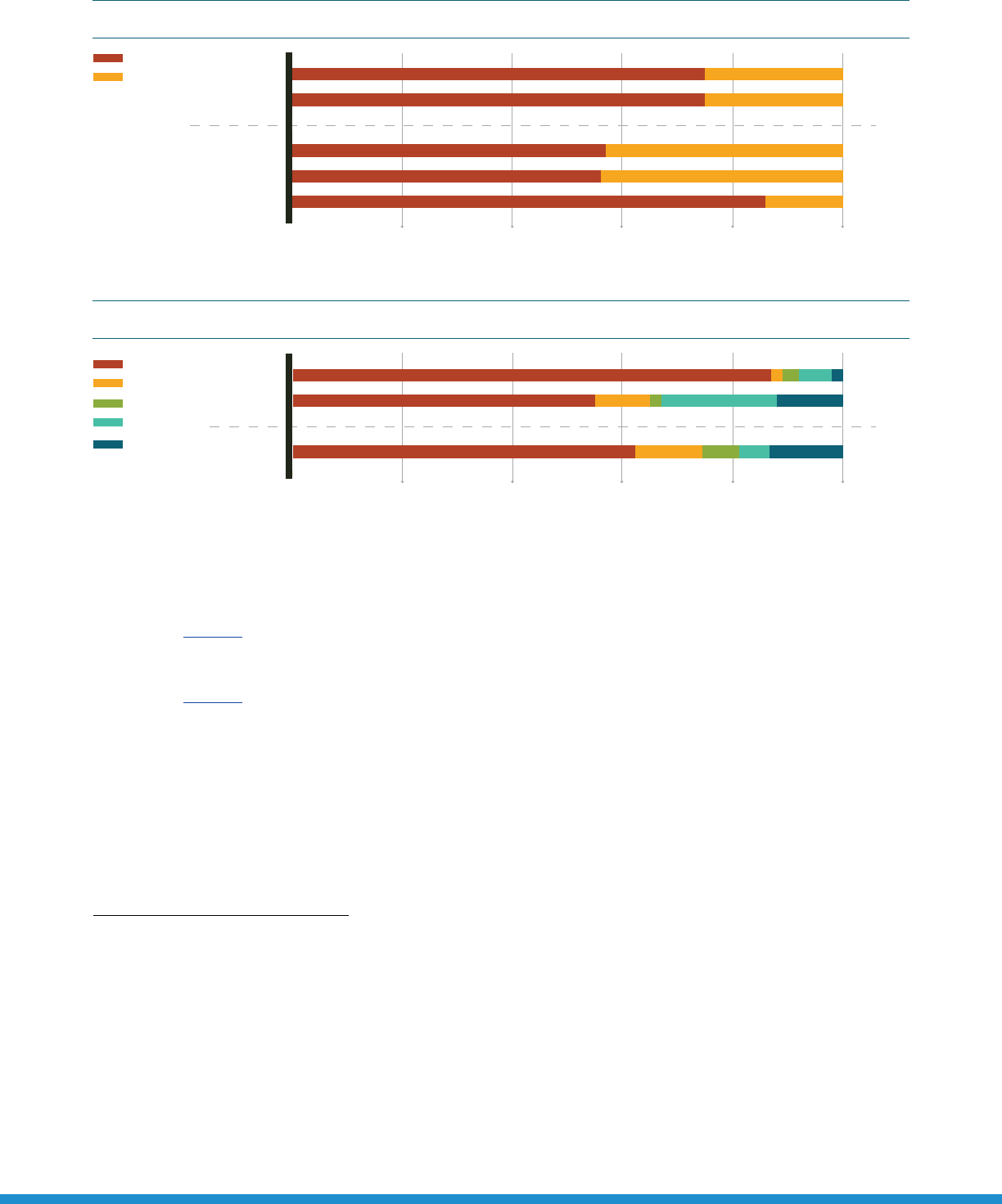
FUELS INSTITUTE | EVC | EV CONSUMER BEHAVIOR
11
United Sates
of America
Overall
CA
USA
Conventional
New Car Buyers
Country Population
United Sates of America 2,677
Brazil 5,461
Mexico 10,560
Argentina 11,242
4000
6000
87% 6%
2% 3%
2%
2%
21%10%55% 12%
62% 12% 7% 6% 13%
56% 44%
86% 14%
On-Road
Residential
O-Road
Commercial
Industrial
Farming
Petroleum
Elictric Utility
Railroad
Shipping
2,677
5,461
10,560
11,242
7,731,952
29.2 32.8 35.8 39.4 41.4 39.9 41.2 41.3
2,677
As shown in Figure 3,
6
PEV buyers, similar to conventional-fuel truck buyers, are mostly male.
7
Sport utility
vehicles (SUV) and sedans have a more balanced distribution amongst male and female buyers.
8
As shown in Figure 4,
9
PEV buyers nationally in the U.S. are mostly white (87%) according to a study conducted
by Morgan State University.
10
The distribution of the white population is slightly elevated in comparison to the
distribution of the U.S. population, with 75% white, 13% Black or African American, 6% Asian, and 6% others.
11
Black or African American ethnicity, however, appears to be underrepresented amongst EV buyers. However, in
California, according to a survey conducted by the University of California, Davis, and the National Center for
Sustainable Transportation, while the distribution of buyers also is mostly white, Asian American PEV buyers
appear to closely follow at 21%. This can also be attributed to the fact that California is one of the states with a
higher population density of Asian Americans.
12
6 “New Car Buyer Demographics 2020 (Updated)”; Z. Andrew Farkas, Hyeon-Shic Shin, Seyedehsan Dadvar, and Jessica Molina, Electric Vehicle Ownership Factors,
Preferred Safety Technologies, and Commuting Behavior in the United States (Charlottesville, VA: Mid-Atlantic Transportation Sustainability University Transportation
Center, University of Virginia, February 2017), available at http://www.matsutc.org/wp-content/uploads/2014/07/Environmental-and-Safety-Attributes-of-Electric-Vehicle-
Ownership-and-Commuting-Behavior-Public-Policy-and-Equity-Consideration.pdf.
7 “New Car Buyer Demographics 2020 (Updated)”
8
“New Car Buyer Demographics 2020 (Updated)”; Farkas et al., Electric Vehicle Ownership Factors, Preferred Safety Technologies, and Commuting Behavior in the United States
9 Farkas et al., Electric Vehicle Ownership Factors, Preferred Safety Technologies, and Commuting Behavior in the United States; Erich Muehlegger and David Rapson,
Impacts of Vehicle Policy: Who Buys New and Used Alternative Vehicles?, prepared by Morgan State University (National Center for Sustainable Transportation, University of
California Davis, February 2018), available at https://escholarship.org/uc/item/0tn4m2tx; Statista Research Department, Structure of New Vehicle Buyers in the United States,
Distributed by Ethnicity Between January and May of 2014 and 2015, May 2016, accessed October 20, 2020, https://www.statista.com/statistics/549852/structure-of-new-
vehicle-buyers-united-states-by-ethnicity/.
10 Farkas et al., Electric Vehicle Ownership Factors, Preferred Safety Technologies, and Commuting Behavior in the United States
11 “2019: ACS 1-Year Estimates Detailed Tables” (Table ID C02003, Universe: Total Population, Survey/Program: American Community Survey), United States Census Bureau,
accessed October 29, 2020, available at https://data.census.gov/cedsci/table?q=race&g=0100000US.04000.001&tid=ACSDT1Y2019.C02003&moe=false&tp=true&hidePreview=true.
12 “2019: ACS 1-Year Estimates Detailed Tables”
Male
Female
United Sates
of America
SUV
PHEV
BEV
Sedan
Trucks
Conventional
Conventional
Electric
New Car Buyers
Country Population
United Sates of America 2,677
Brazil 5,461
Mexico 10,560
Argentina 11,242
4000
6000
75% 25%
75% 25%
57% 43%
56% 44%
86% 14%
On-Road
Residential
O-Road
Commercial
Industrial
Farming
Petroleum
Elictric Utility
Railroad
Shipping
2,677
5,461
10,560
11,242
7,731,952
29.2 32.8 35.8 39.4 41.4 39.9 41.2 41.3
2,677
FIGURE 3: SPLIT OF NEW CAR BUYERS BASED ON GENDER (2019)
Sources: “New Car Buyer Demographics 2020 (Updated),” Hedges & Company; Farkas et al., Electric Vehicle Ownership Factors, Preferred Safety
Technologies, and Commuting Behavior in the United States
White
Hispanic
Black
Asian
FIGURE 4: SPLIT OF PEV BUYERS BASED ON ETHNICITY (USA 2014, CA 2018, OVERALL 2015)
Note: U.S. sample population is 379 EV owners
Sources: Farkas et al., Electric Vehicle Ownership Factors, Preferred Safety Technologies, and Commuting Behavior in the United States;
Erich Muehlegger and David Rapson, Impacts of Vehicle Policy: Who Buys New and Used Alternative Vehicles?; Statista Research Department,
Structure of New Vehicle Buyers in the United States, Distributed by Ethnicity Between January and May of 2014 and 2015
Other
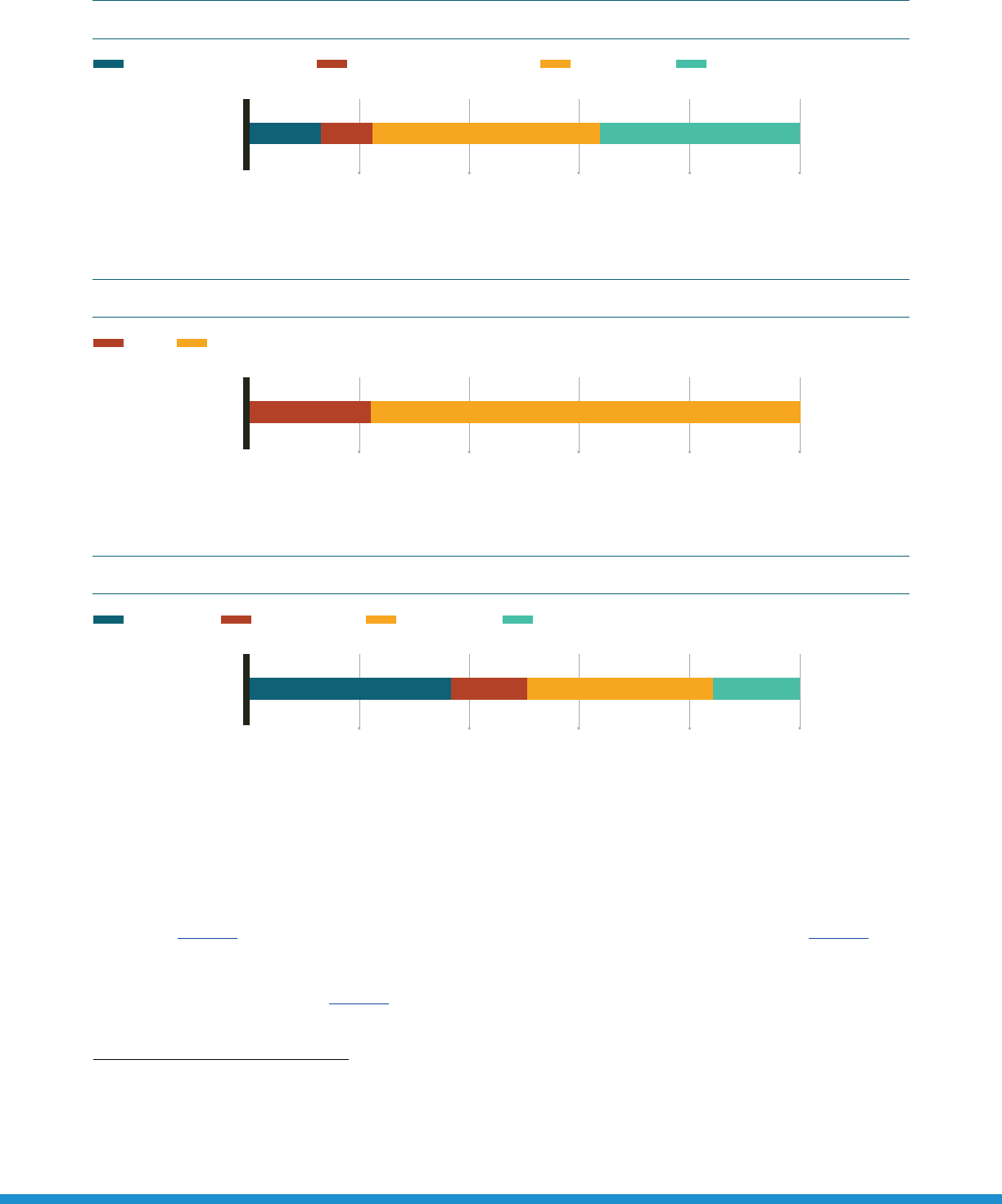
FUELS INSTITUTE | EVC | EV CONSUMER BEHAVIOR
12
Democrat
1
Most PEV owners have at least a four-year degree
according to the survey conducted by Morgan State
University (Figure 5).
13
AAA’s survey of EV owners revealed that 78% of them
also owned a gas-powered car (Figure 6).
14
13 Farkas et al., Electric Vehicle Ownership Factors, Preferred Safety Technologies, and Commuting Behavior in the United States
14 Ellen Edmonds, “AAA: Owning an Electric Vehicle is the Cure for Most Consumer Concerns,” AAA, January 22, 2020, https://newsroom.aaa.com/2020/01/aaa-owning-
anelectric-vehicle-is-the-cure-for-most-consumer-concerns/.
15 Farkas et al., Electric Vehicle Ownership Factors, Preferred Safety Technologies, and Commuting Behavior in the United States
In a survey conducted by Morgan State University in
2017, it was observed that slightly more Democrats
owned PEVs compared to Republicans (Figure 7).
15
Some college/2-year degree
Independent
More than or equal to 2
4-year degree
Republican
Graduate degree
Unailiated
United Sates
of America
PEV owners
SUV
PHEV
BEV
Sedan
Trucks
Conventional Electric
New Car Buyers
New Car Buyers
Country Population
United Sates of America 2,677
Brazil 5,461
Mexico 10,560
Argentina 11,242
4000
6000
21% 12% 10% 57%
20% 16% 4% 60%
31% 19% 10% 40%
39% 18% 9% 34%
37%
13% 10% 41% 36%
20% 10% 33%
2,677
5,461
10,560
11,242
2,677
5,461
10,560
11,242
7,731,952
29.2 32.8 35.8 39.4 41.4 39.9 41.2 41.3
2,677
United Sates
of America
PEV owners
SUV
PHEV
BEV
Sedan
Trucks
Conventional Electric
New Car Buyers
Country Population
United Sates of America 2,677
Brazil 5,461
Mexico 10,560
Argentina 11,242
4000
6000
21% 12% 10% 57%
20% 16% 4% 60%
31% 19% 10% 40%
39% 18% 9% 34%
37%
37% 14% 34% 16%
20% 10% 33%
2,677
5,461
10,560
11,242
2,677
5,461
10,560
11,242
7,731,952
29.2 32.8 35.8 39.4 41.4 39.9 41.2 41.3
2,677
United Sates
of America
PEV owners
SUV
PHEV
BEV
Sedan
Trucks
Conventional Electric
New Car Buyers
New Car Buyers
Country Population
United Sates of America 2,677
Brazil 5,461
Mexico 10,560
Argentina 11,242
4000
6000
21% 12% 10% 57%
20% 16% 4% 60%
31% 19% 10% 40%
39% 18% 9% 34%
37%
22% 78%
20% 10% 33%
2,677
5,461
10,560
11,242
2,677
5,461
10,560
11,242
7,731,952
29.2 32.8 35.8 39.4 41.4 39.9 41.2 41.3
2,677
FIGURE 5: SPLIT OF PEV OWNERS BASED ON EDUCATION LEVEL (2017)
FIGURE 7: POLITICAL AFFILIATION OF PEV OWNERS (2017)
FIGURE 6: SPLIT OF PEV OWNERS BASED ON NUMBER OF VEHICLES IN HOUSEHOLD (2020)
Some high school/diploma
Source: Farkas et al., Electric Vehicle Ownership Factors, Preferred Safety Technologies, and Commuting Behavior in the United States
Source: Ellen Edmonds, “AAA: Owning an Electric Vehicle is the Cure for Most Consumer Concerns”
Source: Farkas et al., Electric Vehicle Ownership Factors, Preferred Safety Technologies, and Commuting Behavior in the United States
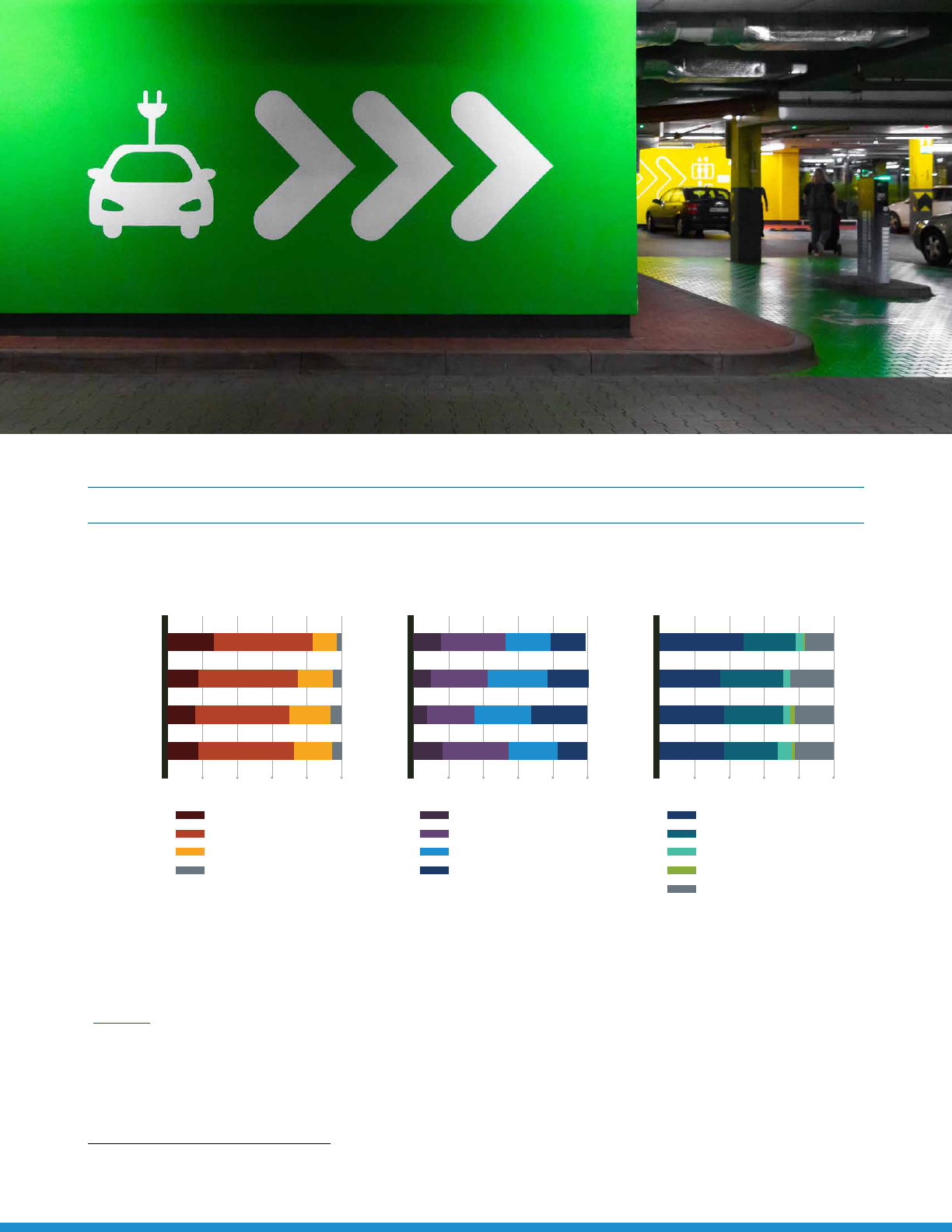
FUELS INSTITUTE | EVC | EV CONSUMER BEHAVIOR
13
In a study conducted by Climate Nexus, Democrats viewed EVs slightly more favorably than Republicans
(Figure 8).
16
When asked about the likeliness to consider purchasing or leasing an EV next time, approximately
53% Democrats and approximately 35% Republicans responded airmatively. When asked if they would
consider buying or leasing an EV if they were oered a guaranteed $7,500 tax rebate, their responses changed
dramatically: 78% Democrats and 71% Republicans said they are likely to consider one.
16 “National Poll Results,” Climate Nexus, 2015, https://climatenexus.org/wp-content/uploads/2015/09/EV-Poll-Results.pdf.
United Sates
of America
Conventional
SUV
PHEV
BEV
Sedan
Trucks
Conventional Electric
New Car Buyers
Positive/negative
opinion about EVs
Likeliness to consider an
EV next time they buy/lease
Likeliness to consider an
EV if given a guaranteed
$7,500 tax rebate
Democrats 26.75% 56.75% 13.75% 2.75%
Independent 18.00% 57.00% 20.00% 5.00%
Republican 16.00% 54.00% 24.00% 6.00%
Others 17.75% 54.75% 21.75% 5.75%
Democrats 16.25% 37.25% 26.25% 20.25%
Independent 9.75% 32.75% 33.75% 23.75%
Republican 8.00% 27.00% 33.00% 32.00%
Others 17.00% 38.00% 28.00% 17.00%
48.20% 30.20% 4.20% 1.20% 16.20%
35.00% 36.00% 4.00% 2.00% 23.00%
37.00% 34.00% 4.00% 3.00% 22.00%
37.00% 31.00% 8.00% 2.00% 22.00%
4000
26.75% 56.75% 13.75%
20%
21% 12% 10% 57%
20% 16% 4% 60%
31% 19% 10% 40%
39% 18% 9% 34%
37% 20% 10% 33%
Democrats
Independent
Republican
Others
2.75%
18% 57% 20%
5%
16% 54% 24%
6%
17.75% 54.75% 21.75%
5.75%
16.25%
26.25%
37.25%
20.25%
20%
10% 34% 24%
8% 33% 32%
17% 28%
33%
27%
38% 17%
48.2% 30.2% 16.2%
20%
1.2%
35% 36% 23%
2%
37% 34% 22%
3%
37% 37% 22%
2%
4.2%
4%
4%
8%
2,677
5,461
10,560
11,242
29.2 32.8 35.8 39.4 41.4 39.9 41.2 41.3
2,677
FIGURE 8: VIEWS ON EVS GROUPED BY POLITICAL AFFILIATION (2019)
Very positive
Somewhat negative
Somewhat positive
Very negative
Verylikely
Somewhat unlikely
Somewhat likely
Very unlikely
Much more likely
No dierence
Somewhat less likely
Somewhat more likely
Much less likely
FUELS INSTITUTE | EVC | EV CONSUMER BEHAVIOR
Source: “National Poll Results,” Climate Nexus (rounded numbers used in some cases)
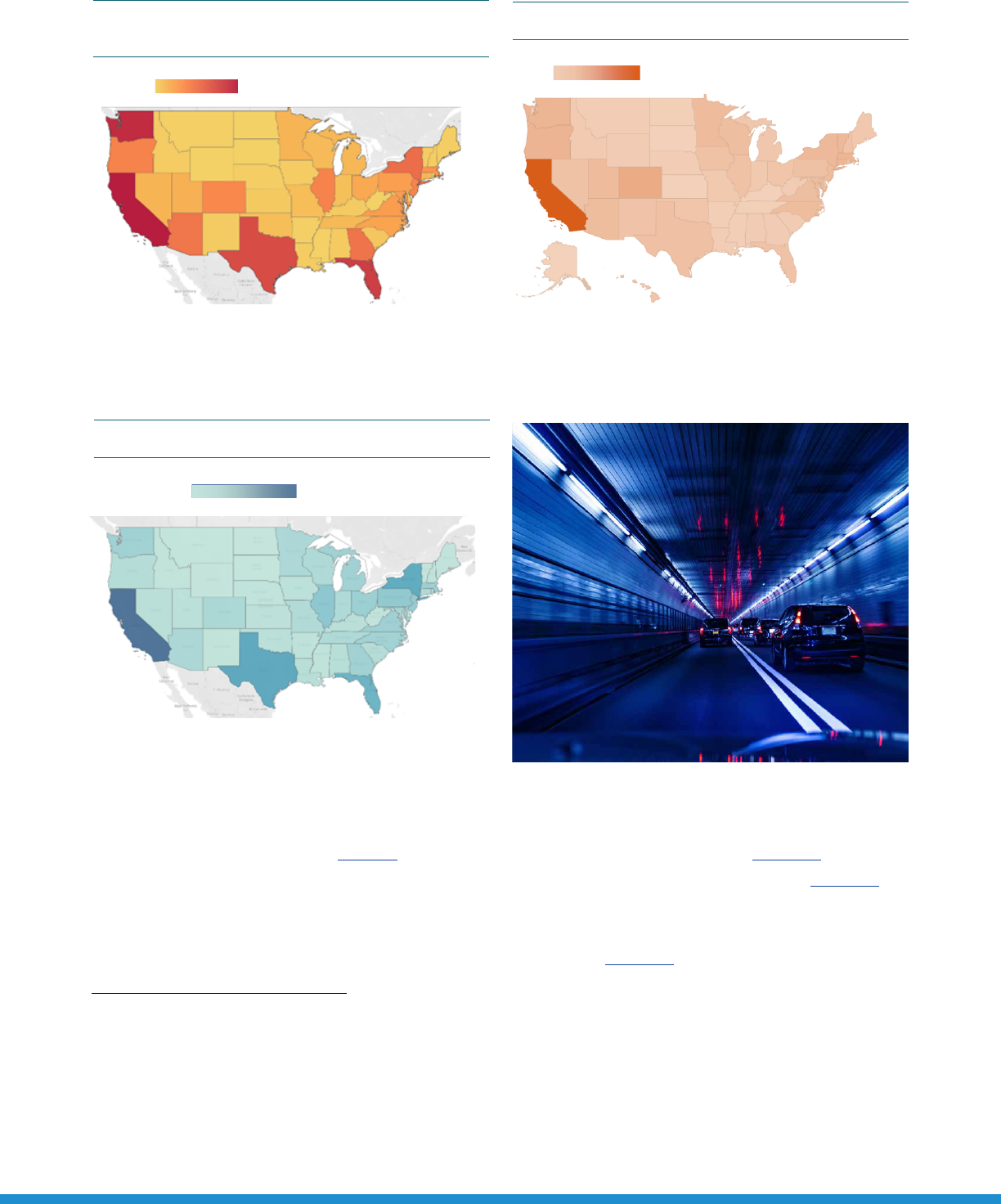
FUELS INSTITUTE | EVC | EV CONSUMER BEHAVIOR
14
DRAFT
20
Note: Total registrations in California is 256,000 but the legend ends at 30,000 to highlight the variation in other states.
Distribution of BEVs is concentrated along the ZEV (zero-emission vehicle) belt.
18
BEV
registrations in California in 2018 were approximately 256,000, which was roughly equal to the
BEV registrations in all other states combined (approximately 286,000).
19
This distribution appears
to correspond with individual income in each state (Figure 10) and the EV policies and incentives
in each state (Figure 11). When compared to the overall number of vehicles registered by state,
EVs constitute a very small percentage (Figure 12).
20
FIGURE 10: INDIVIDUAL INCOME BY STATE (2018)
21
18
“Electric Vehicle Registrations by State”
19
“Electric Vehicle Registrations by State”
20
“Electric Vehicle Registrations by State”; U.S. Automobile Registrations in 2018, by State”
21
“SOI Tax Stats — Individual Income Tax Statistics — 2018 ZIP Code Data (SOI),” Internal Revenue Service,
2018, accessed October 20, 2020, available at https://www.irs.gov/statistics/soi-tax-stats-individual-income-tax-
statistics-2018-zip-code-data-soi.
FIGURE 10: INDIVIDUAL INCOME BY STATE (2018)
DRAFT
21
Note: Darker color indicates a larger sum of individual income.
FIGURE 11: EV LAWS AND INCENTIVES (2020)
22
Note: Darker color indicates a greater number of laws and incentives; California leads at 104.
FIGURE 12: SPLIT OF VEHICLE REGISTRATIONS BY STATE (TOP 10) (2018)
23
22
“Electric Vehicle Laws and Incentives by State” (chart), “Maps and Data — Electric Vehicle Laws and Incentives
by State” (webpage), Alternative Fuels Data Center, Alternate Fuels Data Center, Office of Energy Efficiency &
Renewable Energy, U.S. Department of Energy, accessed October 22, 2020, available at
https://afdc.energy.gov/data/10373.
23
“U.S. Automobile Registrations in 2018, by State,” Statista, March 2021,
https://www.statista.com/statistics/196010/total-number-of-registered-automobiles-in-the-us-by-state/; “Electric
Vehicle Registrations by State”
FIGURE 11: EV LAWS AND INCENTIVES (2020)
DRAFT
21
Note: Darker color indicates a larger sum of individual income.
FIGURE 11: EV LAWS AND INCENTIVES (2020)
22
Note: Darker color indicates a greater number of laws and incentives; California leads at 104.
FIGURE 12: SPLIT OF VEHICLE REGISTRATIONS BY STATE (TOP 10) (2018)
23
22
“Electric Vehicle Laws and Incentives by State” (chart), “Maps and Data — Electric Vehicle Laws and Incentives
by State” (webpage), Alternative Fuels Data Center, Alternate Fuels Data Center, Office of Energy Efficiency &
Renewable Energy, U.S. Department of Energy, accessed October 22, 2020, available at
https://afdc.energy.gov/data/10373.
23
“U.S. Automobile Registrations in 2018, by State,” Statista, March 2021,
https://www.statista.com/statistics/196010/total-number-of-registered-automobiles-in-the-us-by-state/; “Electric
Vehicle Registrations by State”
DRAFT
21
Note: Darker color indicates a larger sum of individual income.
FIGURE 11: EV LAWS AND INCENTIVES (2020)
22
Note: Darker color indicates a greater number of laws and incentives; California leads at 104.
FIGURE 12: SPLIT OF VEHICLE REGISTRATIONS BY STATE (TOP 10) (2018)
23
22
“Electric Vehicle Laws and Incentives by State” (chart), “Maps and Data — Electric Vehicle Laws and Incentives
by State” (webpage), Alternative Fuels Data Center, Alternate Fuels Data Center, Office of Energy Efficiency &
Renewable Energy, U.S. Department of Energy, accessed October 22, 2020, available at
https://afdc.energy.gov/data/10373.
23
“U.S. Automobile Registrations in 2018, by State,” Statista, March 2021,
https://www.statista.com/statistics/196010/total-number-of-registered-automobiles-in-the-us-by-state/; “Electric
Vehicle Registrations by State”
Distribution of BEVs is concentrated along the
ZEV (zero-emission vehicle) belt (Figure 9).
17
BEV registrations in California in 2018 were
approximately 256,000, which was roughly equal to
the BEV registrations in all other states combined
(approximately 286,000).
18
17 “Electric Vehicle Registrations by State,” National Renewable Energy Laboratory, printed March 7, 2020, updated August 2020, accessed October 20, 2020, available at
https://afdc.energy.gov/data/10962.
18 “Electric Vehicle Registrations by State;” “U.S. Automobile Registrations in 2018, by State,” Statista, March 2021, https://www.statista.com/statistics/196010/total-
number-ofregistered-automobiles-in-the-us-by-state/.
19 “SOI Tax Stats — Individual Income Tax Statistics — 2018 ZIP Code Data (SOI),” Internal Revenue Service, 2018, accessed October 20, 2020, available at https://www.irs.
gov/statistics/soi-tax-stats-individual-income-tax-statistics-2018-zip-code-data-soi.
20 “Electric Vehicle Laws and Incentives by State” (chart), “Maps and Data — Electric Vehicle Laws and Incentives by State” (webpage), Alternative Fuels Data Center, Oice
of Energy Eiciency and Renewable Energy, U.S. Department of Energy, accessed October 22, 2020, available at https://afdc.energy.gov/data/10373.“““
21 “Electric Vehicle Registrations by State;” “U.S. Automobile Registrations in 2018, by State”
This distribution appears to correspond with
individual income in each state (Figure 10)
19
and the
EV policies and incentives in each state (Figure 11).
20
When compared to the overall number of vehicles
registered by state, EVs constitute a very small
percentage (Figure 12).
21
High Income
104
Low Income
0
DRAFT
20
Note: Total registrations in California is 256,000 but the legend ends at 30,000 to highlight the variation in other states.
Distribution of BEVs is concentrated along the ZEV (zero-emission vehicle) belt.
18
BEV
registrations in California in 2018 were approximately 256,000, which was roughly equal to the
BEV registrations in all other states combined (approximately 286,000).
19
This distribution appears
to correspond with individual income in each state (Figure 10) and the EV policies and incentives
in each state (Figure 11). When compared to the overall number of vehicles registered by state,
EVs constitute a very small percentage (Figure 12).
20
FIGURE 10: INDIVIDUAL INCOME BY STATE (2018)
21
18
“Electric Vehicle Registrations by State”
19
“Electric Vehicle Registrations by State”
20
“Electric Vehicle Registrations by State”; U.S. Automobile Registrations in 2018, by State”
21
“SOI Tax Stats — Individual Income Tax Statistics — 2018 ZIP Code Data (SOI),” Internal Revenue Service,
2018, accessed October 20, 2020, available at https://www.irs.gov/statistics/soi-tax-stats-individual-income-tax-
statistics-2018-zip-code-data-soi.
FIGURE 9: HEATMAP OF BEV POPULATION BASED
ON NUMBER OF REGISTRATIONS BY STATE (2018)
DRAFT
20
Note: Total registrations in California is 256,000 but the legend ends at 30,000 to highlight the variation in other states.
Distribution of BEVs is concentrated along the ZEV (zero-emission vehicle) belt.
18
BEV
registrations in California in 2018 were approximately 256,000, which was roughly equal to the
BEV registrations in all other states combined (approximately 286,000).
19
This distribution appears
to correspond with individual income in each state (Figure 10) and the EV policies and incentives
in each state (Figure 11). When compared to the overall number of vehicles registered by state,
EVs constitute a very small percentage (Figure 12).
20
FIGURE 10: INDIVIDUAL INCOME BY STATE (2018)
21
18
“Electric Vehicle Registrations by State”
19
“Electric Vehicle Registrations by State”
20
“Electric Vehicle Registrations by State”; U.S. Automobile Registrations in 2018, by State”
21
“SOI Tax Stats — Individual Income Tax Statistics — 2018 ZIP Code Data (SOI),” Internal Revenue Service,
2018, accessed October 20, 2020, available at https://www.irs.gov/statistics/soi-tax-stats-individual-income-tax-
statistics-2018-zip-code-data-soi.
30,000100
Note: Total registrations in California is 256,000 but the legend ends at
30,000 to highlight the variation in other states.
Source: “Electric Vehicle Registrations by State,” National Renewable
Energy Laboratory
Note: Darker color indicates a larger sum of individual income.
Source: “SOI Tax Stats — Individual Income Tax Statistics — 2018 ZIP Code
Data (SOI),” Internal Revenue Service
Note: Darker color indicates a greater number of laws and incentives;
California leads at 104.
Source: “Electric Vehicle Laws and Incentives by State” (chart), “Maps
and Data — Electric Vehicle Laws and Incentives by State” (webpage),
Alternative Fuels Data Center

FUELS INSTITUTE | EVC | EV CONSUMER BEHAVIOR
15
FUELS INSTITUTE | EVC | EV CONSUMER BEHAVIOR
15
Distribution of BEVs is
concentrated along the ZEV
(zero-emission vehicle) belt.
BEV registrations in California
in 2018 were approximately
256,000, which was roughly
equal to the BEV registrations
in all other states combined
(approximately 286,000).
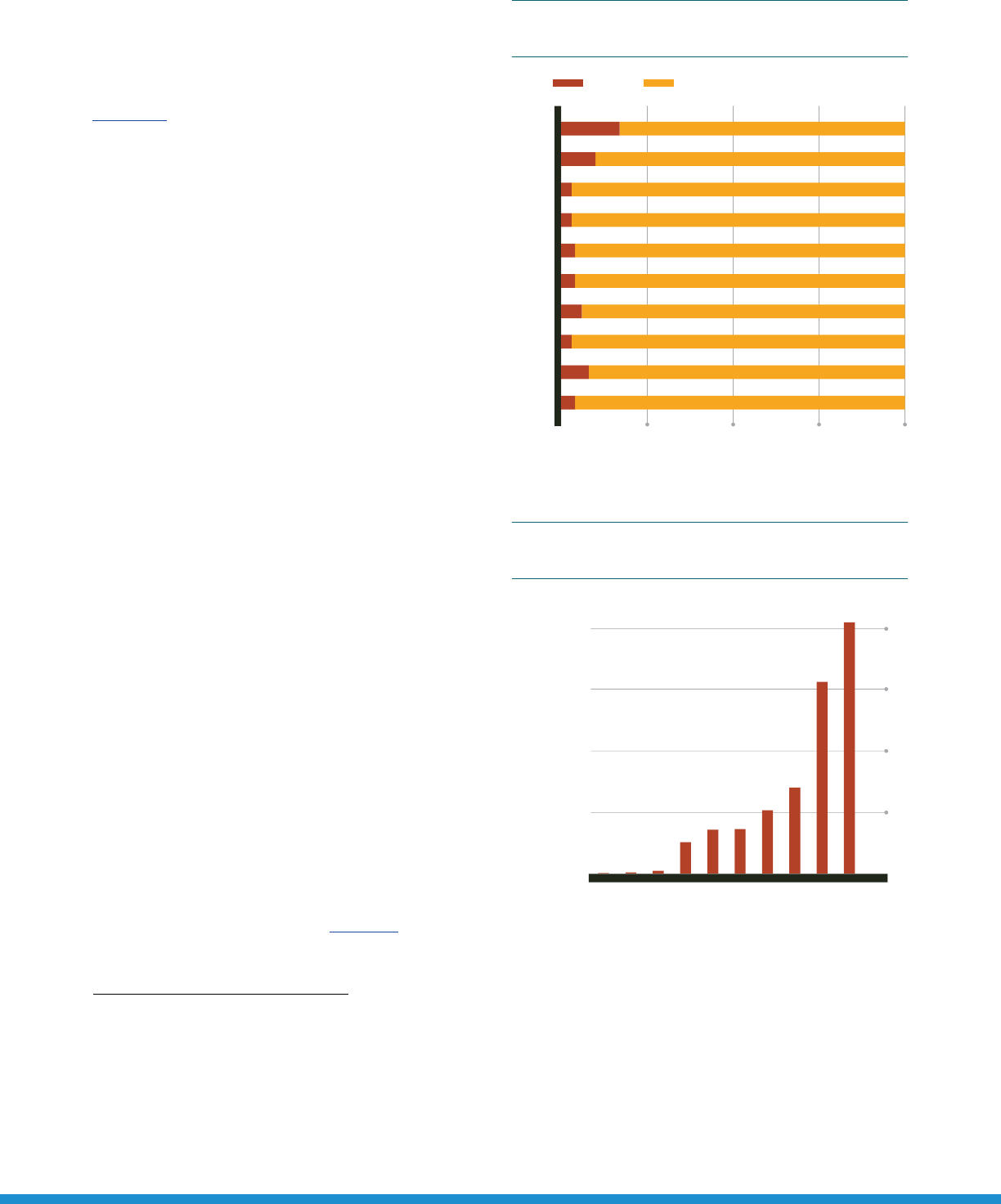
FUELS INSTITUTE | EVC | EV CONSUMER BEHAVIOR
16
Despite having the highest number of EV
registrations in the U.S., California’s BEV
population still comprises only approximately
1.7% of the state’s overall vehicle registrations
(Figure 12). In each of the 10 states with the most
EV registrations, those registrations constituted
less than 1% of all state vehicle registrations
in 2018.
Daily commute lengths of PEV drivers
According to the Federal Highway Administration,
in 2017, self-estimated annual mileage indicates
an average daily commute between 20 and 35
miles.
22
For EV drivers, however, the average
daily commute length is estimated to be
between 31 and 39 miles.
23
One reason for this
observed trend could be BEVs have a lower
cost of fuel and maintenance compared to an
ICE-powered vehicle — estimated by AAA as
57% lesser and 65% lesser, respectively. Most
EV owners also own a second vehicle in the
household, which could be a conventional
vehicle. Given the cheaper operating cost of a
BEV compared to a conventional vehicle, owners
might prefer to use the BEV for a higher number
of trips.
24
Another reason could be that the
constant increase of both average EV battery
range and charging infrastructure has reduced
range anxiety for drivers.
EVOLUTION OF EV BUYER DEMOGRAPHICS
AND BEHAVIOR OVER THE PAST 10 YEARS
BEV production in the U.S. has been
experiencing exponential growth aided by falling
battery prices.
25
The spike in 2018 coincides with
the Tesla Model 3 introduction (Figure 13).
26
22 N. McGuckin and A. Fucci, Summary of Travel Trends: 2017 National Household Travel Survey (Washington, DC: Federal Highway Administration, July 2018), available at
https://nhts.ornl.gov/assets/2017_nhts_summary_travel_trends.pdf.
23 Ellen Edmonds, “AAA: Owning an Electric Vehicle is the Cure for Most Consumer Concerns”; Daniel Boston and Alyssa Werthman, “Plug-in Vehicle Behaviors: An Analysis
of Charging and Driving Behavior of Ford Plug-In Electric Vehicles in the Real World,” World Electric Vehicle Journal 8 (2016): 926-935, https://doi.org/10.3390/wevj8040926.
24 Ellen Edmonds, “AAA: Owning an Electric Vehicle is the Cure for Most Consumer Concerns”
25 Colin McKerracher, Ali Izadi-Najafabadi, Aleksandra O’Donovan, Nick Albanese, Nikolas Soulopolous, David Doherty, Milo Boers, et al, Electric Vehicle Outlook 2020
(Bloomberg New Energy Finance, 2020), https://about.bnef.com/electric-vehicle-outlook/.
26 IHS Markit, subscription-only database and forecast utility, accessed October 1, 2020, https://ihsmarkit.com/
United Sates
of America
Conventional
SUV
PHEV
BEV
Sedan
Trucks
Conventional Electric
New Car Buyers
Positive/negative
opinion about
electric vehicles
100,000
200,000
300,000
400,000
500,000
4000
0.00M
0.00M
0.00M
21% 12% 10% 57%
20% 16% 4% 60%
31% 19% 10% 40%
39% 18% 9% 34%
37% 20% 10% 33%
2010
2011
2012
2013
2014
2015
2016
2017
2018
2019
0.05M
0.07M
0.07M
0.10M
0.14M
0.31M
0.41M
100,000
200,000
300,000
400,000
500,000
0.00M
0.00M
0.00M
2010
2011
2012
2013
2014
2015
2016
2017
2018
2019
0.05M
0.07M
0.07M
0.10M
0.14M
0.31M
0.41M
2,677
5,461
10,560
11,242
29.2 32.8 35.8 39.4 41.4 39.9 41.2 41.3
2,677
FIGURE 13: BEV PRODUCTION IN THE U.S.
(2010-2019)
United Sates
of America
Conventional
SUV
PHEV
BEV
Sedan
Trucks
Conventional Electric
New Car Buyers
Positive/negative
opinion about
electric vehicles
4000
98.3%
1.7%
99.0%
1.0%
99.7%
0.3%
99.7%
0.3%
99.6%
0.4%
99.6%
0.4%
99.4%
0.6%
99.7%
0.3%
99.2%
0.8%
99.6%
0.4%
21% 12% 10% 57%
20% 16% 4% 60%
31% 19% 10% 40%
39% 18% 9% 34%
37% 20% 10% 33%
CA
WA
FL
TX
NY
GA
AZ
IL
OR
NJ
2,677
5,461
10,560
11,242
29.2 32.8 35.8 39.4 41.4 39.9 41.2 41.3
2,677
FIGURE 12: SPLIT OF VEHICLE REGISTRATIONS
BY STATE (TOP 10) (2018)
BEV
Others
Source: “Electric Vehicle Registrations by State;” “U.S. Automobile
Registrations in 2018, by State”
Source: IHS Markit
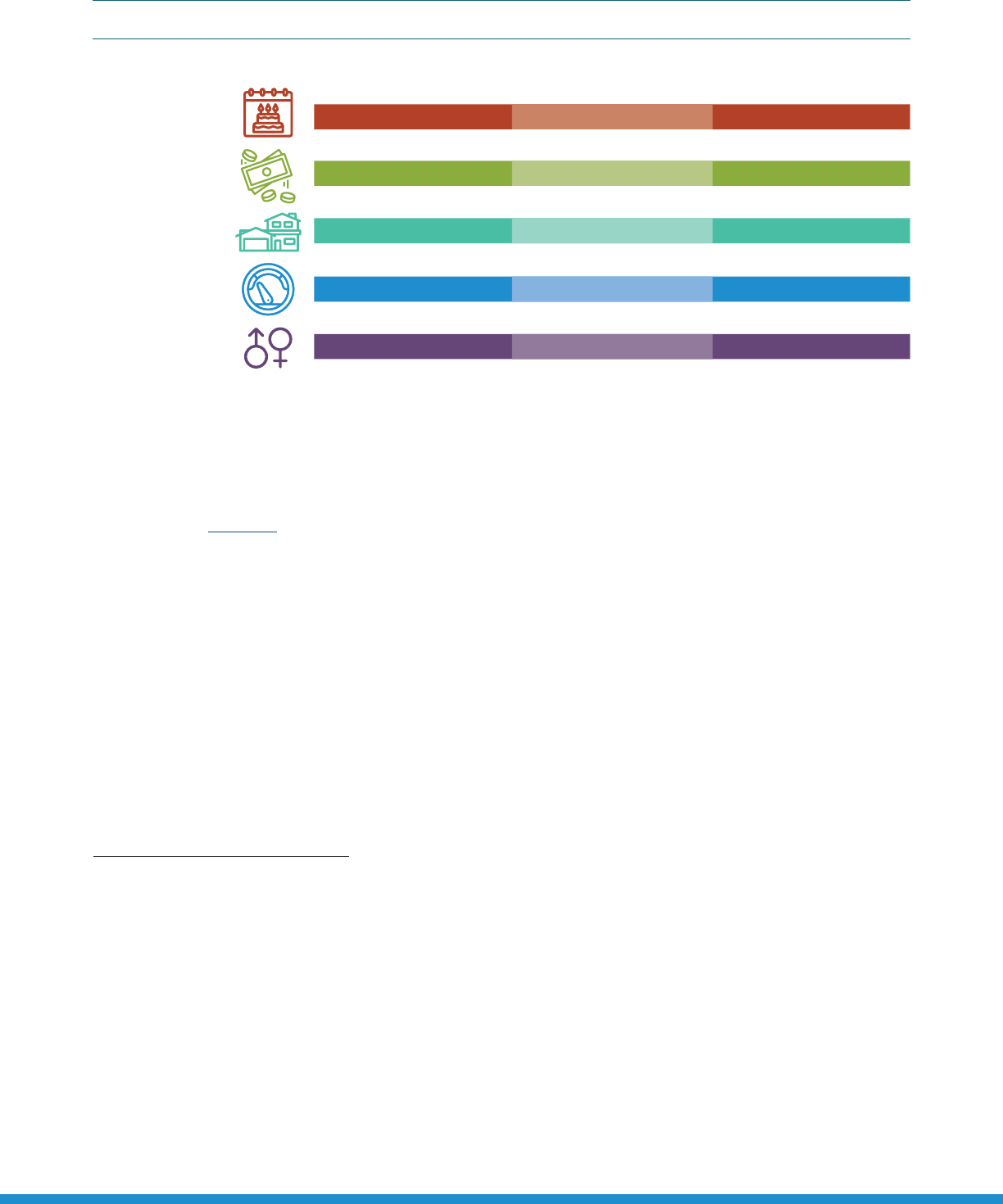
FUELS INSTITUTE | EVC | EV CONSUMER BEHAVIOR
17
BUSINESS AS USUAL
Utility/Contribution in Aid of Construction Host Site Investment
AGE 40–44
UTILITY INCENTIVE
2012
45–54
2015
40–55
AVERAGE INCOME $114k $114–150k $125–150k
RESIDENCE 90% vehicle garage 90% vehicle garage no public data
MILEAGE ~100 per week ~180 per week ~250 per week
GENDER 67% male 74% male 75% male
2019
Utility/Contribution in Aid of Construction Host Site Investment
MAKE-READY
Utility Investment Host Site Investment
OWNER-OPERATOR
Utility Investment
Utility Incentive Payments
Positive/negative
opinion about
electric vehicles
UTILITY
DISTRIBUTION
NETWORK
Service Connection Supply Infrastructure Charger Equipment
METER CONDUCTOR
(BORING/
TRENCHING)
EV CHARGER ELECTRIC
VEHICLE
PANELUTILITY
PAD-MOUNTED
TRANSFORMER
The PEV buyer’s age group has stayed the same
over the years (Figure 14).
27
The average household
annual income has been consistently over $100,000.
28
Most PEV owners have had a garage with an outlet to
charge their vehicle.
29
PEV buyers have mostly been
male.
30
Mileage traveled, however, has increased
from 100 miles a week to 250 miles a week over the
past 10 years.
31
This could be attributed to the fact
that both the average battery range on a typical EV
and the charging infrastructure have been growing
constantly, which helps ease range anxiety for
buyers. In addition to this, the cost of operating
an EV is less than that of a conventional vehicle,
27 Deloitte Consulting LLP, Gaining Traction: A Customer View of Electric Vehicle Mass Adoption in the U.S. Automotive Market, 2010, https://www.yumpu.com/en/document/
read/4198231/gaining-traction-a-customer-view-of-electric-vehicle-mass-adoption-in; Chris Woodyard, “Study: Electric Car Buyers Are Younger but Richer,” USA Today, May
4, 2015, updated May 7, 2015, https://www.usatoday.com/story/money/cars/2015/05/04/truecar-study-electric-cars-richer/26884511/; “EV Consumer Survey Dashboard,”
California Clean Vehicle Rebate Project, accessed October 5, 2020, available at https://cleanvehiclerebate.org/eng/survey-dashboard/ev; Daniel Boston and Alyssa
Werthman, “Plug-in Vehicle Behaviors”; “New Car Buyer Demographics 2020 (Updated)”
28 Electric Power Research Institute, Inc., Plug-In Electric Vehicle Multi-State Market and Charging Survey, February 26, 2016, available at https://www.epri.com/research/
products/000000003002007495; Deloitte Consulting LLP, Gaining Traction; Christopher Butler, “Electric Vehicle Prices Finally in Reach of Millennial, Gen Z Car Buyers”
29 Electric Power Research Institute, Inc., Plug-In Electric Vehicle Multi-State Market and Charging Survey, February 26, 2016, available at https://www.epri.com/research/
products/000000003002007495. Deloitte Consulting LLP, Gaining Traction
30 Deloitte Consulting LLP, Gaining Traction; Mark Kane, “Annual Electric Miles Traveled Varies Widely For 8 Plug-In Electric Cars,” InsideEVs, May 16, 2015, https://insideevs.
com/news/325893/annual-electric-miles-traveled-varies-widely-for-8-plug-in-electric-cars/.
31 Deloitte Consulting LLP, Gaining Traction; Mark Kane, “Annual Electric Miles Traveled Varies Widely For 8 Plug-In Electric Cars”; Ellen Edmonds, “AAA: Owning an Electric
Vehicle is the Cure for Most Consumer Concerns”
32 Ellen Edmonds, “AAA: Owning an Electric Vehicle is the Cure for Most Consumer Concerns”
33 Ricardo research
34 Annie Palmer, “Amazon Debuts Electric Delivery Vans Created with Rivian,” CNBC, October 8, 2020, updated October 8, 2020, https://www.cnbc.com/2020/10/08/
amazon-new-electric-delivery-vans-created-with-rivian-unveiled.html.
encouraging drivers to drive their EVs more than
their other conventional vehicle(s).
32
The EV fleet has grown over the past 10 years where
commercial fleet operators have gained more
experience in deploying EVs in the field. EV usage in
the commercial sector has evolved from limited-use
transit bus applications to medium- and heavy-duty
vehicles, delivery vans, and light-duty trucks.
33
A very
recent example to this is Amazon’s 2020 investment
in Rivian to provide vans for its fleet.
34
FIGURE 14: EVOLUTION OF KEY EV BUYER DEMOGRAPHICS (2012-2021)
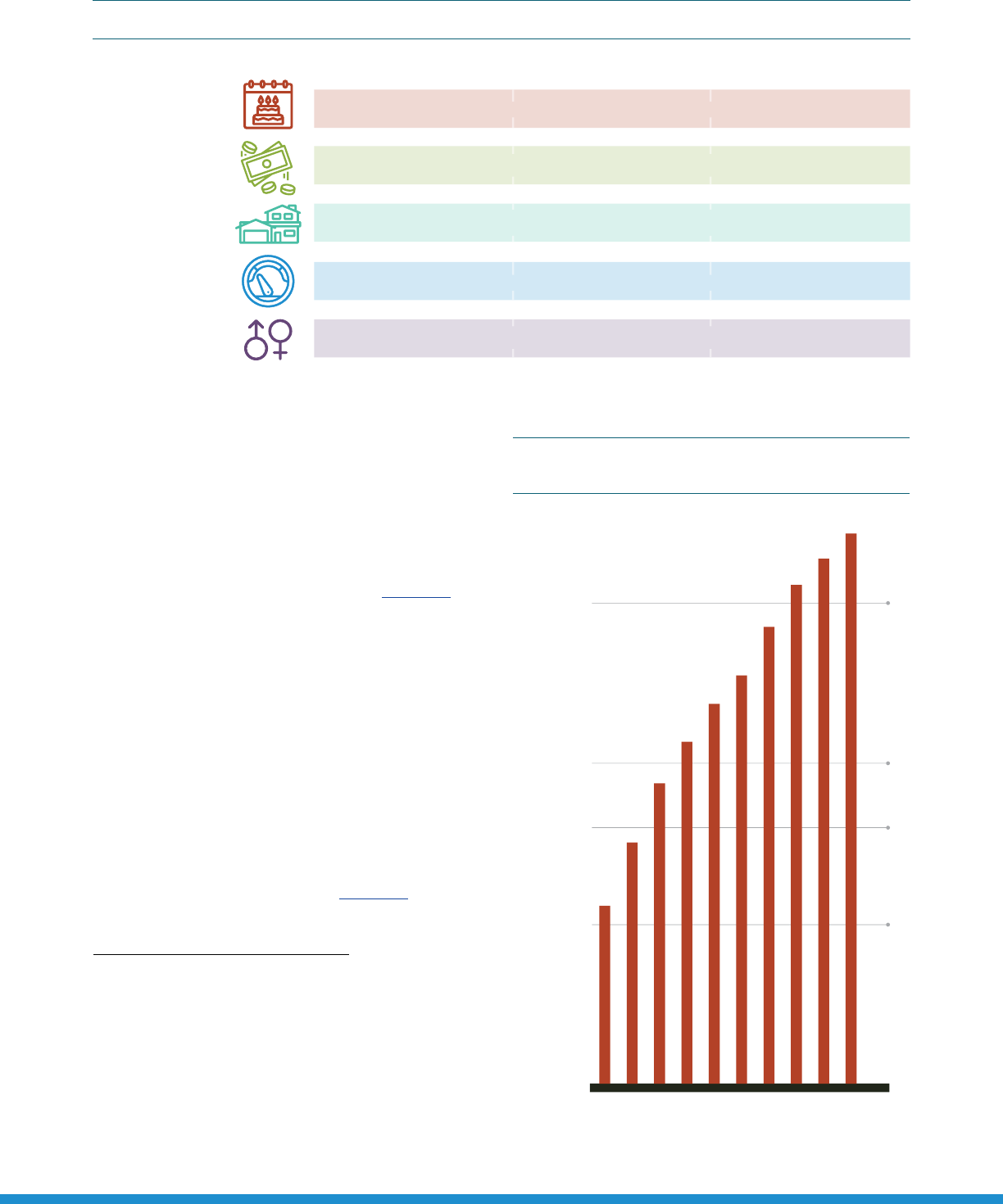
FUELS INSTITUTE | EVC | EV CONSUMER BEHAVIOR
18
United Sates
of America
Conventional
SUV
PHEV
BEV
Sedan
Trucks
Conventional Electric
New Car Buyers
Positive/negative
opinion about
electric vehicles
500,000
1,000,000
1,500,000
2,000,000
4000
0.55M
0.75M
0.94M
21% 12% 10% 57%
20% 16% 4% 60%
31% 19% 10% 40%
39% 18% 9% 34%
37% 20% 10% 33%
2021
2022
2023
2024
2025
2026
2027
2028
2029
2030
1.075M
1.18M
1.27M
1.42M
1.56M
1.64M
1.72M
2,677
5,461
10,560
11,242
29.2 32.8 35.8 39.4 41.4 39.9 41.2 41.3
2,677
ANTICIPATED EVOLUTION OF EV BUYER
DEMOGRAPHICS AND BEHAVIOR OVER
THE NEXT 10 YEARS
BEV production is expected to steadily grow within
the next decade. At some point, BEVs are expected
to reach price parity with ICE vehicles (Figure 15).
Companies such as Volkswagen and Volvo expect to
generate at least 40% of their sales from EVs by 2025;
most other auto OEMs are expected to follow this
trend.
35
By 2030, up to 40% of all new car sales
could be EVs.
36
Given that the number of available
EV segments is expected to broaden, the cost
of owning an EV is forecast to be on par with a
conventional vehicle, and charging infrastructure
is estimated to grow to meet the demand,
37
the EV
buyer demographic could normalize with the new
car buyer over the next 10 years (Figure 16).
35 Tim Levin, “All the Things Carmakers Say They’ll Accomplish with Their Future
Electric Vehicles Between Now and 2030,” Business Insider, January 28, 2020,
https://www.businessinsider.com/promises-carmakers-have-made-about-their-
future-electric-vehicles-2020-1.
36 McKerracher et al, Electric Vehicle Outlook 2020; U.S. Drive, Summary Report
on EVs at Scale and the U.S. Electric Power System, November 2019, https://www.
energy.gov/sites/prod/files/2019/12/f69/GITT%20ISATT%20EVs%20at%20Scale%20
Grid%20Summary%20Report%20FINAL%20Nov2019.pdf.
37 Hao Wu, Genevieve Alberts, James Hooper, and Bryn Walton, New Market. New
Entrants. New Challenges. Battery Electric Vehicles (London, UK: Deloitte LLP, 2019),
https://www2.deloitte.com/content/dam/Deloitte/uk/Documents/manufacturing/
deloitte-uk-battery-electric-vehicles.pdf.
BUSINESS AS USUAL
Utility/Contribution in Aid of Construction Host Site Investment
AGE
UTILITY INCENTIVE
2021 2025
AVERAGE INCOME
RESIDENCE
MILEAGE
GENDER
2030
Utility/Contribution in Aid of Construction Host Site Investment
MAKE-READY
Utility Investment Host Site Investment
OWNER-OPERATOR
Utility Investment
Utility Incentive Payments
Positive/negative
opinion about
electric vehicles
Average income bracket is expected to drop down from the current bracket
as EVs become more affordable.
Number of EV drivers with no provision to charge at home is expected to increase as
availability of public charging points increases along with the range of vehicles.
Driving pattern is expected to be similar to the way ICE vehicles are driven.
Gender distribution is expected to be more balanced with the launch of new vehicles
in various segments with better range estimators.
The average age is expected to normalize with the broader new-vehicle buyer trend.
UTILITY
DISTRIBUTION
NETWORK
Service Connection Supply Infrastructure Charger Equipment
METER CONDUCTOR
(BORING/
TRENCHING)
EV CHARGER ELECTRIC
VEHICLE
PANELUTILITY
PAD-MOUNTED
TRANSFORMER
FIGURE 16: EXPECTED EVOLUTION OF KEY EV BUYER DEMOGRAPHICS (2021-2030)
FIGURE 15: EXPECTED BEV PRODUCTION IN THE
U.S. (2021-2030)

FUELS INSTITUTE | EVC | EV CONSUMER BEHAVIOR
19
According to a survey conducted by Volvo, more than
half of respondents said they are likely to purchase
an EV if the price is the same as an ICE vehicle.
38
The
industry expectation that EV to ICE price parity may
be realized in the coming decade would mean that
EVs could be aordable to a broader consumer base.
This will increase the probability of buyers with an
annual household income of less than $100,000 to
consider an EV for their next vehicle, thus pushing
the average EV owner income bracket down from
where it currently sits.
Bloomberg New Energy Finance predicts the ratio
of EVs to public charging points is expected to reach
40-50 EVs per public charging point by 2040,
39
and as
hardware costs fall and technology is commoditized,
Wood Mackenzie predicts that there could be as many
as 1.2 million public charging points in North America
by 2030.
40
This increase in availability of public
chargers could help potential consumers without
access to a charger at home consider buying an EV.
38 Volvo Car USA, The State of Electric Vehicles in America, February 26, 2019, https://www.media.volvocars.com/us/en-us/media/documentfile/249123/volvo-reports-the-
state-of-electric-vehicles-in-america.
39 McKerracher et al., Electric Vehicle Outlook 2020
40 Jason Deign, “Up to 40 Million EV Charging Points Forecast Worldwide by 2030,” Green Tech Media, August 9, 2018, https://www.greentechmedia.com/articles/read/
electric-vehicle-charging-points-40-million-gtm.
41 Castrol, Accelerating the EVolution: The Tipping Points to Mainstream Electric Vehicle Adoption, 2020, https://www.castrol.com/content/dam/castrol/master-site/en/
global/home/technology-and-innovation/electric-vehicle-adoption/accelerating_the_evolution_study.pdf.
42 “Average Annual Miles per Driver by Age Group,” Federal Highway Administration, U.S. Department of Transportation, March 29, 2018, accessed October 15, 2020,
available at https://www.fhwa.dot.gov/ohim/onh00/bar8.htm.
43 Dave Vanderwerp, “EV Range: Everything You Need to Know,” Car and Driver, May 22, 2020, https://www.caranddriver.com/shopping-advice/a32603216/ev-range-
explained/.
44 “New Car Buyer Demographics 2020 (Updated)”
45 Nicolette Caperello, Jennifer TyreeHageman, and Ken Kurani, “Engendering the Future of Electric Vehicles: Conversations with Men and Women” (presentation,
Women’s Issues in Transportation 5th International Conference, Paris, France, April 14-16, 2014) available at https://phev.ucdavis.edu/wp-content/uploads/2017/08/2014-
UCD-ITS-RP-14-101.pdf.
46 Kristy Hartman and Emily Dowd, “State Eorts to Promote Hybrid and Electric Vehicles,” National Conference of State Legislatures, September 26, 2017, https://www.
ncsl.org/research/energy/state-electric-vehicle-incentives-state-chart.aspx.
47
David Shepardson and Nichola Groom, “California Passes Landmark Mandate for Zero Emission Trucks,” Reuters, June 25, 2020, https://ca.reuters.com/article/idUSKBN23W31N.
Potential owners are inclined to purchase a BEV
if it delivers a range of approximately 320 miles.
41
Given that Americans drive an average of 260 miles
a week,
42
potential BEV buyers expect to get at least
a week of driving range on a single charge. Many
vehicles today oer more than 200 miles of range,
43
and the trend has been constant growth in
BEV range. BEVs are expected to be driven
like liquid-fuel-powered vehicles today, so
the driving distance on a BEV is expected to
be on par with the overall trend.
There appears to be a balanced distribution
between the two genders in purchases of
SUVs and sedans, however, the average
EV customer is predominantly male.
44
According to a study by the University of
California, Davis, amongst other reasons,
female EV early adopters largely distrusted the range
estimator.
45
There could be more female EV drivers
when newer technology enables more accurate
range predictors and perhaps better range as well.
The EV fleet is expected to grow in the upcoming
years, primarily driven by state mandates.
California and 27 other states have hybrid or EV
fleet requirements, acquisition goals, or a stated
preference for purchasing hybrid or EVs to be used
in the state’s fleet.
46
For example, California’s 2020
mandate requiring 5-9% of 2024 model year trucks,
based on class, to be ZEVs is expected to expand to
have 30-50% of trucks to be ZEVs by 2030 and 100%
where feasible by 2045.
47
The EV fleet is expected to grow in the
upcoming years, primarily driven by state
mandates. California and 27 other states have
hybrid or EV fleet requirements, acquisition
goals, or a stated preference for purchasing
hybrid or EVs to be used in the state’s fleet.

FUELS INSTITUTE | EVC | EV CONSUMER BEHAVIOR
20
DEMOGRAPHIC CHARACTERISTICS AND
THEIR RELATIONSHIP WITH EV OWNERSHIP
AND BEHAVIOR
Currently, EVs are predominantly sedans or
hatchbacks, which may not cater to the requirement
of SUV, truck, and minivan drivers. In a 2019 study,
the Union of Concerned Scientists (UCS) and
Consumer Reports reported a strong consensus
(72%) that PEVs should be produced in other forms,
48
so they may address the requirements of drivers of
these vehicles.
In the same study, approximately half of all
prospective EV buyers reported a belief that the
federal government should invest money to help
consumers buy PEVs. In addition, this belief is more
prevalent in people of color (62% people of color
versus 53% of all new car buyers).
49
48 Union of Concerned Scientists and Consumer Reports, Electric Vehicle Survey Findings and Methodology, July 2019, https://advocacy.consumerreports.org/wp-content/
uploads/2019/07/ConsumerReports-UnionofConcernedScientists-2019-EV_Survey-7.17.19.pdf.
49 Union of Concerned Scientists and Consumer Reports, Electric Vehicle Survey Findings and Methodology
50 Christopher Butler, “Electric Vehicle Prices Finally in Reach of Millennial, Gen Z Car Buyers”
51 Union of Concerned Scientists and Consumer Reports, Electric Vehicle Survey Findings and Methodology; John Kiser and Mark Essery, Is There a Target Market for Electric
Vehicles?, Ipsos, March 27, 2017, https://www.ipsos.com/sites/default/files/2017-04/ipsos-marketing-target-market-electric-vehicles.PD__0.pdf.
52 Union of Concerned Scientists and Consumer Reports, Electric Vehicle Survey Findings and Methodology
Another key theme is that younger people between
the age of 25 and 34 may not be able to aord EVs
due to factors such as student debt, wage stagnation,
and lack of access to home charging or at-home
parking. Some report using public transportation to
be more practical than owning a car.
50
PEV buyers appear to value aordability by means
of a lower purchase price, lower operating costs,
and federal and/or state support, amongst others
(Figure 17).
51
They expect a PEV to be time-saving by
charging quickly and having a long range. Charger
availability at home and in public places appears
important to prospective PEV buyers. Some of those
surveyed
feel that familiarity with the technology
could encourage a purchase,
52
such as while renting
a PEV and riding in a PEV ride-share or taxi. Potential
buyers value choices in form and attractive vehicle
design, amongst other factors, that could help them
decide to purchase an EV.
AFFORDABILITY TIME SAVING
CHARGER
AVAILABILITY
FAMILIARITY OPTIONS
MAKE-READY
Utility Investment Host Site Investment
Utility Incentive Payments
Positive/negative
opinion about
electric vehicles
Lower purchase
price
Lower operating
costs
Federal/state
incentive
Free EVSE
installation at home
Special rates
from utility
Long range
between charges
Short charging
time
Ability to charge
at home
More public
charging stations
Ability to charge
at work
Renting a plug-in
vehicle
Friend/family
recommend
Riding in PEV as
taxi/rideshare
Plug-in crossovers/
SUV/pickup
Ability to charge
wirelessly
Used PEV
options
Attractive vehicle
design
UTILITY
DISTRIBUTION
NETWORK
Service Connection
FIGURE 17: FACTORS INFLUENCING LIKELINESS OF PEV PURCHASE (2017-2019)
Source: Union of Concerned Scientists and Consumer Reports, Electric
Vehicle Survey Findings and Methodology; John Kiser and Mark Essery,
Is There a Target Market for Electric Vehicles?

FUELS INSTITUTE | EVC | EV CONSUMER BEHAVIOR
21
Decision making for adoption of EVs in
commercial fleet applications is deeply rooted
in viable business case and the ability to meet
operational requirements. Hence, TCO and the
payback period are key metrics considered by
fleets, which are impacted by EV price, cost of
infrastructure, operational cost savings, and residual
value at the end of the vehicle’s primary usage.
Vehicle uptime, duty cycle, range, and payload
requirements are other major factors that fleets
take into consideration. EVs have penetrated several
commercial vehicle on-highway and o-highway
applications, such as transit buses, school buses,
medium-duty delivery vans, yard trucks, forklis,
and heavy-duty on-highway trucks. However,
currently commercial EVs are predominantly used
for local operations, oen involving stop-and-go
duty cycles, where the vehicles return to base and
rely on private charging infrastructure owned and
operated by the fleet.
53
DIFFERENCE IN TRIPS TAKEN IN
EVS VERSUS LIQUID-FUEL VEHICLES
Early adopters found that limited battery range and
lack of widespread availability of public chargers
made longer trips more diicult in EVs. According to
an AAA study, the average EV owner drives 39 miles a
day.
54
This is slightly more than the national average
of all vehicles, which is between 20-35 miles a day.
55
In general, more miles are driven today in an EV than
in a conventional liquid-fueled vehicle, and drivers
have started treating EVs like they would treat a
conventional liquid-fueled vehicle. This is dierent
from the situation a few years ago when the average
53 Ricardo research
54 Ellen Edmonds, “AAA: Owning an Electric Vehicle is the Cure for Most Consumer Concerns”
55 N. McGuckin and A. Fucci, Summary of Travel Trends: 2017 National Household Travel Survey; Daniel Boston and Alyssa Werthman, “Plug-in Vehicle Behaviors”
56 Deloitte Consulting LLP, Gaining Traction
57 “Gasoline and Diesel Fuel Update,” Petroleum & Other Liquids, U.S. Energy Information Administration, accessed October 23, 2020, available at https://www.eia.gov/
petroleum/gasdiesel/.
58 “Table 4-23: Average Fuel Eiciency of U.S. Light Duty Vehicles,” Bureau of Transportation Statistics, https://www.bts.gov/content/average-fuel-eiciency-us-light-duty-
vehicles.
59 “Average Retail Price of Electricity, United States, Annual,” Electricity Data Browser, U.S. Energy Information Administration, available at https://www.eia.gov/electricity/
data/browser/#/topic/7?agg=2,0,1&geo=g&freq=A&start=2001&end=2019&ctype=linechart<ype=pin&rtype=s&pin=&rse=0&maptype=0 (data accessed for year 2019).
60 “New All-Electric Vehicles,” Oice of Energy Eiciency and Renewable Energy, U.S. Department of Energy, accessed October 16, 2020, https://www.fueleconomy.
gov/feg/PowerSearch.do?action=noform&path=3&year1=2019&year2=2021&vtype=Electric&srchtyp=newAfv&tabView=0&pageno=1&sortBy=Comb&rowLimit=10 (fuel
eiciency of all current BEVs were averaged).
number of miles driven in an EV had been roughly 15
miles a day.
56
This has been largely attributed to the
increased range on EVs and availability of EV chargers,
instilling confidence in drivers to drive longer miles,
especially because operational expense for EVs is
lower than that for gasoline vehicles.
To compare this dierence in operational expense,
in
2019, the U.S. national average price of gas was
$2.5
per gallon.
57
The average fuel economy of a gas
vehicle (average of short wheelbase light vehicle
in
2019) is 24.1 mpg.
58
Based on the above, one
mile
costs 9.6 on gas. The average cost of retail
residential
electricity was 13.04 per kWh in 2019,
59
and the
average fuel eiciency of a BEV is 32.63
kWh per 100
miles,
60
or 0.3263 kWh per mile. This
implies one
mile on electricity costs 4.25, which is
roughly less
than half of the cost to travel in a gas-
powered
vehicle.
Many states allow PEVs to use high-occupancy
vehicle, or HOV, lanes, cutting drivers’ commute
times by a significant portion and helping them
make a statement about their “tech-savvy-ness”
or their environmental consciousness. This gives
drivers more reasons to drive a PEV, especially when
they have more than one vehicle in their household.
One major dierence in EV driving behavior is
that long trips are mostly planned with charging
locations in mind, as opposed to a conventional
vehicle’s ability to re-fuel at almost any gas station,
which far outnumber the number of available
charging stations.
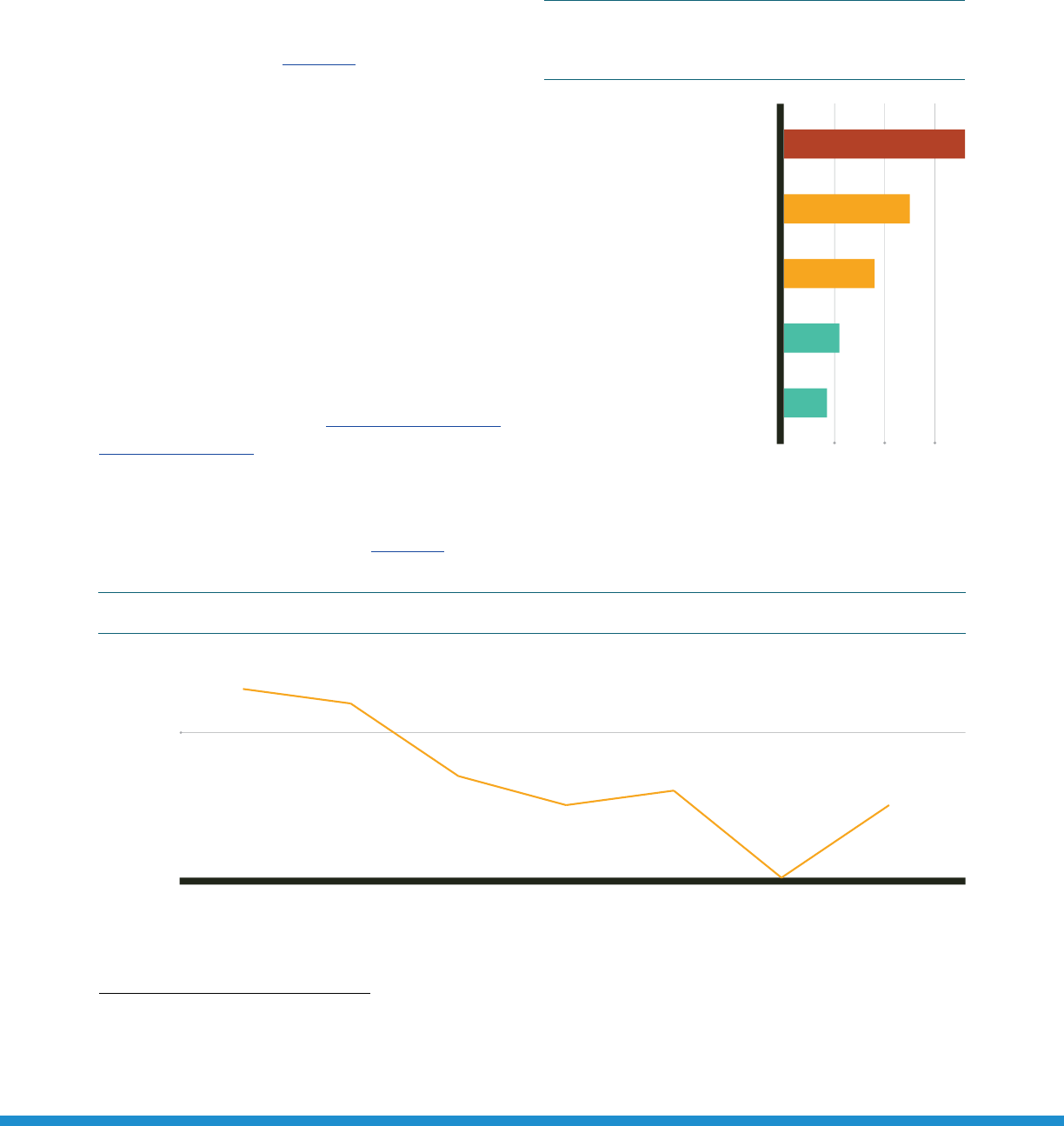
FUELS INSTITUTE | EVC | EV CONSUMER BEHAVIOR
22
WHEN AND WHERE DOES THE
CUSTOMER RECHARGE?
EV DRIVERS’ CHARGING FREQUENCY
As the battery range of vehicles increases with every
new model year, the confidence among EV owners
is increasing, which is noted in the downward trend
of charging frequency (Figure 18).
61
The average
EV owner driving a 2016 or 2017 model year vehicle
charged approximately once a day as opposed to
EV drivers with vehicles of a 2011 model year that
required to be recharged approximately twice a
day (43 times a month). 2021 model year vehicles
are predicted to not be very dierent from 2016
and 2017 model year vehicles and are expected
to being charged roughly once a day. This trend,
however, could see a slight rise as the number of
public chargers increases. People are likely to plug in
even when their EV has enough charge to complete
the trip because of factors such as availability,
convenience, and value (see “EV Drivers’ Preferred
Recharge Location”).
The UCS and Consumer Reports found that most
prospective PEV buyers would prefer to charge
twice a week, overnight, at home (Figure 19).
62
61 Eric Schmidt, “The Key to Increasing EV Adoption Is Hidden in EV Driving and Charging Data,” FleetCarma, January 24, 2018, available at https://www.fleetcarma.com/
key-increasing-ev-adoption-hidden-ev-driving-charging-data/.
62 Union of Concerned Scientists and Consumer Reports, Electric Vehicle Survey Findings and Methodology
63 Union of Concerned Scientists and Consumer Reports, Electric Vehicle Survey Findings and Methodology
They also found that prospective EV buyers who
are people of color are more likely to find charging
options outside the home to be more convenient,
compared to all prospective car buyers combined.
63
United Sates
of America
Conventional
SUV
PHEV
BEV
Sedan
Trucks
Conventional Electric
New Car Buyers
Positive/negative
opinion about
electric vehicles
10 20 30 40 50 60 70 80
4000
72
50
36
22
17
1.7%
99.0%
1.0%
99.7%
0.3%
99.7%
0.3%
99.6%
0.4%
99.6%
0.4%
99.4%
0.6%
99.7%
0.3%
99.2%
0.8%
99.6%
0.4%
21% 12% 10% 57%
20% 16% 4% 60%
31% 19% 10% 40%
39% 18% 9% 34%
37% 20% 10% 33%
Home
Overnight
Twice a week
Nearby fast charger
10 minutes
Twice a week
Nearby fast charger
30 minutes
Once a week
Shopping center/restaurant
4 hours
Once a week
Shopping center/restaurant
2 hours
Twice a week
2,677
5,461
10,560
11,242
29.2 32.8 35.8 39.4 41.4 39.9 41.2 41.3
2,677
2011 20132012 2014 201720162015
Charge events per month
30
40
50
43%
42%
37%
35%
36%
30%
35%
29.2 32.8 35.8 39.4 41.4 39.9 41.2 41.3
VariationLow Medium High
FIGURE 18: AVERAGE RECHARGE EVENTS PER MONTH BY MODEL YEAR
Note: Data includes U.S. and Canada
FIGURE 19: CHARGING OPTIONS PERCEIVED
TO BE MOST CONVENIENT BY PROSPECTIVE
PEV BUYERS (2017)
Note: Percentage represents proportion of respondents rating option as
“completely convenient” or “very convenient”
Source: Union of Concerned Scientists and Consumer Reports, Electric
Vehicle Survey Findings and Methodology
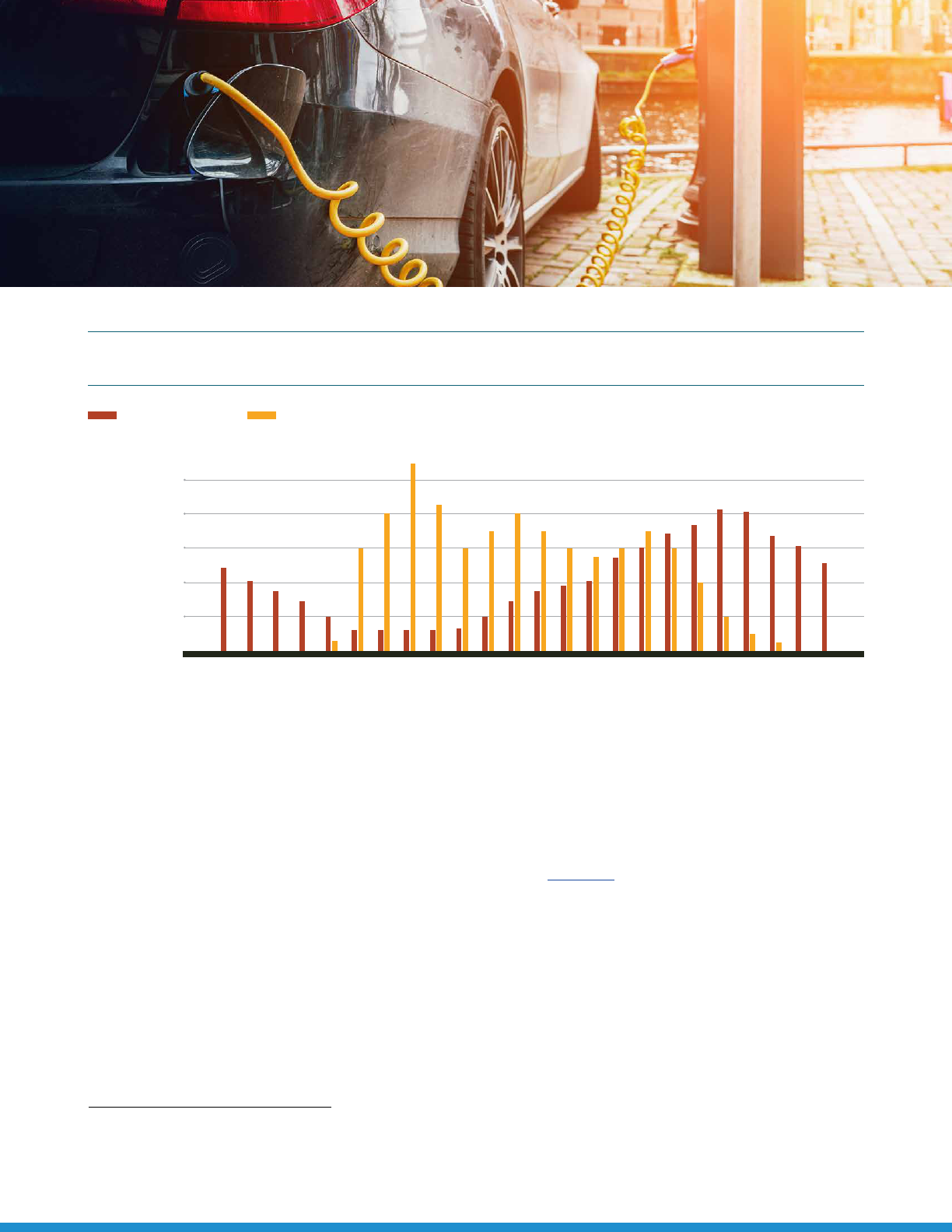
FUELS INSTITUTE | EVC | EV CONSUMER BEHAVIOR
23
FIGURE 20: ESTIMATE: PERCENTAGE TIME SPENT CHARGING AT A GIVEN POINT IN TIME
DURING THE DAY (2017)
The American Public Power Association in their 2017 study predicted that uncontrolled, aggregate EV
charging could have a vehicle recharging profile as depicted in Figure 20.
64
They suggest that to avoid
rising EV charging rates, utilities may need to incentivize consumers to charge in non-peak periods.
65
EV commercial fleet customers operate in a hub-and-spoke network and tend to exclusively recharge their
vehicles at their base. Their charging schedule largely depends on their operation shis. Vehicles operating
day shi, such as transit buses, school buses, and delivery trucks, are typically plugged in at the end of the
shi for overnight charging. However, opportunity charging has also been observed in certain applications
such as yard facilities and transit bus routes, particularly where the vehicle operation tends to be very busy
and the window for charging is narrow.
66
64 American Public Power Association, A Public Power Guide to Understanding the U.S. Plug-in Electric Vehicle Market, 2017, available at https://www.amea.com/wp-
content/uploads/2018/08/understanding_the_us_plug-in_electric_vehicle_market_2017_digital_final.pdf.
65 American Public Power Association, A Public Power Guide to Understanding the U.S. Plug-in Electric Vehicle Market
66 Ricardo research
2007 20092008 2010 20142013 201520122011 2016 2017 2018
Percent of time spent charging
2%
4%
6%
8%
10%
12%
26.6
7,731,952
29.2 32.8 35.8 39.4 41.4 39.9 41.2 41.3
Light Vehicles Passenger Trucks Lorries and Cargo Trucks Motorcycles
12:00 AM
1:00 AM
2:00 AM
3:00 AM
4:00 AM
5:00 AM
6:00 AM
7:00 AM
8:00 AM
9:00 AM
10:00 AM
11:00 AM
12:00 PM
1:00 PM
2:00 PM
3:00 PM
4:00 PM
5:00 PM
6:00 PM
7:00 PM
8:00 PM
9:00 PM
10:00 PM
11:00 PM
1981
1982
1983
1984
1985
1986
1987
1988
1989
1990
1991
1992
1993
1994
1995
1996
1997
1998
1999
2000
2001
2002
2003
2004
2005
2006
2007
2008
2009
2010
2011
2012
2013
2014
2015
2016
2017
Charging at home Charging away from home
FUELS INSTITUTE | EVC | EV CONSUMER BEHAVIOR
Note: Away includes charging at work and at public charging stations
Source: American Public Power Association, A Public Power Guide to Understanding the U.S. Plug-in Electric Vehicle Market
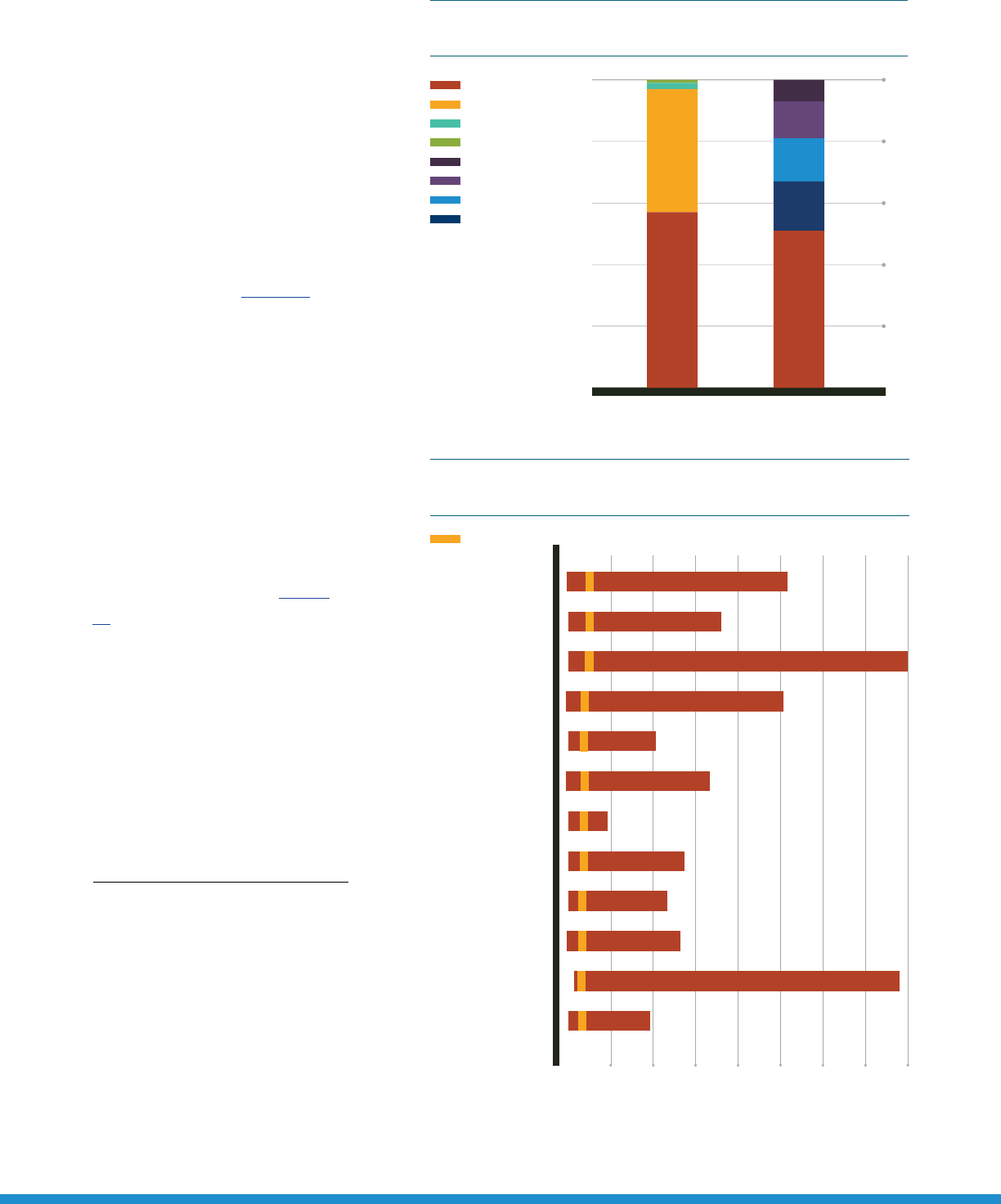
FUELS INSTITUTE | EVC | EV CONSUMER BEHAVIOR
24
United Sates
of America
Conventional
SUV
PHEV
BEV
Sedan
Trucks
Conventional Electric
New Car Buyers
Positive/negative
opinion about
electric vehicles
4000
21% 12% 10% 57%
20% 16% 4% 60%
31% 19% 10% 40%
39% 18% 9% 34%
37% 20% 10% 33%
2021
2022
2023
2024
2025
2026
2027
2028
2029
2030
1%
2%
1.72M
2015 2018
1%
2%
2015 2018
2,677
5,461
10,560
11,242
29.2 32.8 35.8 39.4 41.4 39.9 41.2 41.3
2,677
57%
16%
14%
12%
7%
51%
40%
57%
16%
14%
12%
7%
51%
40%
Home
Overnight
Twice a week
Nearby fast charger
10 minute
Twice a week
Nearby fast charger
30 minute
Once a week
Shopping ctr/Restaurant
4 hours
Once a week
Shopping ctr/Restaurant
2 hours
Twice a week
EV DRIVERS’ PREFERRED
RECHARGE LOCATION
A few years ago, EV charging
occurred 80% of the time at
home, according to the U.S.
Department of Energy’s (DOE)
Oice of Energy Eiciency and
Renewable Energy (Figure 21).
67
Among survey participants, 57%
exclusively charged at home
and 40% claimed to recharge
at home and away in 2015.
68
In
2018, 67% of those surveyed
charged either at home or at work
and the remaining third of the
participants charged elsewhere.
69
The DOE, INL, and others
conducted an EV Project study
between 2011 and 2013 (Figure
22).
70
Charging events by site
per week exhibit a large range;
however, the median was around
nine events per week. The most
used parking lot charges were
those located in downtown areas.
Workplace charging and chargers
located in multi-family complexes
were also amongst the most used.
67 “Charging at Home,” Oice of Energy Eiciency
and Renewable Energy, U.S. Department of Energy,
accessed on October 20, 2020, available at https://
www.energy.gov/eere/electricvehicles/charging-
home.
68 Electric Power Research Institute, Inc., Plug-In
Electric Vehicle Multi-State Market and Charging
Survey
69 Volvo Car USA, The State of Electric Vehicles in
America
70 John Smart, “EV Charging Infrastructure Usage in
Large-scale Charging Infrastructure Demonstrations:
Public Charging Station Case Studies for ARB,”
(presentation, Plug-in Electric Vehicle Infrastructure
Information Gathering Meeting, July 15, 2014),
available at https://avt.inl.gov/sites/default/files/pdf/
EVProj/EVInfrastructureUsageARBJul2014.pdf.
FIGURE 21: AVERAGE PEV CHARGING FREQUENCY
BY LOCATION
Home
Median
Away
Home and away
Not in last 30 days
Other
On-the-go
Destination
Work
United Sates
of America
Conventional
SUV
PHEV
BEV
Sedan
Trucks
Conventional Electric
New Car Buyers
30 60 90 120
4000
21% 12% 10% 57%
20% 16% 4% 60%
31% 19% 10% 40%
39% 18% 9% 34%
37% 20% 10% 33%
Parking lots/garages
Transportation hub
Workplace
Public municipal
Leisure destination
Retail
Fleet
Non-profit
Hotels
Medical
Multi-family
Education
9.3
9.25
8.5
7.6
7.2
7.2
7.2
6.9
6.6
6.5
6.3
6.2
2.5–78
3–54
3–120
2–77
3–31
2–51
3–144
3–41
3–35
2.5–40
5–115
3–29
2,677
5,461
10,560
11,242
29.2 32.8 35.8 39.4 41.4 39.9 41.2 41.3
2,677
FIGURE 22: AVERAGE NUMBER OF CHARGING EVENTS
PER SITE PER WEEK FOR LEVEL 2 EVSE (2012-2014)
Source: John Smart, “EV Charging Infrastructure Usage in Large-scale Charging
Infrastructure Demonstrations: Public Charging Station Case Studies for ARB”

FUELS INSTITUTE | EVC | EV CONSUMER BEHAVIOR
25
Many DCFC that were open to the public
experienced heavy usage by both inter-city
and in-town traic, even though most
recharging was done at home and/or at work.
In compairison, a relatively smaller number of
Level 2 chargers saw constant high usage.
71
Although, the majority of recharging was done at
home and/or at work, INL found that many DCFC
that were open to the public experienced heavy
usage by both inter-city and in-town traic, and
a relatively smaller number of Level 2 chargers
saw constant high usage.
71
Public Level 2 chargers
in locations where vehicles are parked for longer
periods of time, such as shopping malls, airports,
commuter lots, and downtown parking lots with easy
access to a variety of venues, were amongst the ones
that were most used during the period of study.
72
Since this study was conducted between 2011 and
2013, a similar study could be commissioned to
understand current preferences.
EVs operated by commercial fleets are charged
exclusively at their bases using private charging
stations owned and operated by the fleets. However,
availability of public charging stations in the
future can help alleviate the financial burden and
responsibilities of installing charging infrastructure
to some extent; some fleets may rely completely
on public charging stations while others may
71 John Galloway Smart and Shawn Douglas Salisbury, Plugged In: How Americans Charge Their Electric Vehicles (Idaho Falls, ID: Idaho National Laboratory on behalf of the
U.S. Department of Energy Oice of Scientific and Technical Information, January 7, 2015), https://doi.org/10.2172/1369632.
72 John Galloway Smart and Shawn Douglas Salisbury, Plugged In: How Americans Charge Their Electric Vehicles
73 Ricardo research
74 Mary Meisenzahl, “Amazon Just Revealed Its First Electric Delivery Van of a Planned 100,000-Strong EV Fleet — See How It Was Designed,” Business Insider, February 3,
2021, https://www.businessinsider.com/amazon-creating-fleet-of-electric-delivery-vehicles-rivian-2020-2.
75 Ricardo research
consider those as an option for extending the range
if the battery state-of-charge is low during regular
operations. However, this is going to require the
industry to use standard charging protocol and the
network of public charging stations to be reliable
and available. Private charging stations are still
expected to be predominant charging locations
amongst commercial fleets, particularly the early
adopter large fleets. But adoption of EVs in mass
market and smaller commercial fleets may spur the
growth of public charging station networks.
73
Amazon plans to have 10,000 electric delivery
vehicles by 2022 and 100,000 by 2030 to help meet
its goal of achieving carbon neutrality by 2045 as
part of its Climate Pledge.
74
In order to meet this
goal, Amazon would need to switch their middle-
mile transport fleet to EVs as well. Amazon and their
delivery partners currently install charging stations
at home base for their last-mile delivery fleet, but
to meet the extended range requirements for
middle-mile delivery, they may need to use public
infrastructure on highways.
75
25

FUELS INSTITUTE | EVC | EV CONSUMER BEHAVIOR
26
EV drivers tend to mostly recharge at home and/
or work. A few factors that prompt using public
chargers include the following (Figure 23):
1) Nonavailability: Drivers who do not have access
to a charger at home or at work must recharge at
public charging stations.
76
2) Running out of range: Drivers who exceed the
range of the vehicle battery on any given day
may need to visit a public fast charging station.
77
3) Accessibility: Charging stations’ availability at
places where drivers would park anyway, such
as shopping malls, restaurants, grocery stores,
etc., where it takes only a few seconds to plug in,
encourages drivers to use a public charger.
78
4) Value: A driver may choose the value of using a
public charger that is free of cost.
79
5) Convenience: EV chargers are usually nearer to
the entrance of public amenities, thus drivers
receive preferential treatment.
80
6) Forgetting to charge at home: Drivers who
forget to charge their car at home might have
to rely on a public charging station to maintain
daily travel plans.
81
76 Hauke Engel, Russell Hensley, Stefan Knupfer, and Shivika Sahdev, “Charging Ahead: Electric-Vehicle Infrastructure Demand,” McKinsey and Company, August 8, 2018,
https://www.mckinsey.com/industries/automotive-and-assembly/our-insights/charging-ahead-electric-vehicle-infrastructure-demand.
77 Engel et al., “Charging Ahead: Electric-Vehicle Infrastructure Demand”
78 Mal Skowron, “Smart EV Charging Habits,” The Energy Consumer Bulletin, Green Energy Consumers Alliance, May 8, 2020, https://blog.greenenergyconsumers.org/blog/
smart-ev-charging-habits.
79 Electric Power Research Institute, Inc., Plug-In Electric Vehicle Multi-State Market and Charging Survey
80 New York State Energy Research and Development Authority and Transportation and Climate Initiative, Siting and Design Guidelines for Electric Vehicle Supply Equipment,
November 2012, https://www.transportationandclimate.org/sites/default/files/EV_Siting_and_Design_Guidelines.pdf.
81 Hauke Engel et al., “Charging Ahead: Electric-Vehicle Infrastructure Demand”
FACTORS THAT INFLUENCE A
RECHARGE OCCASION
Charging occurs predominantly either at home or
at work and typically overnight, similar to when
users recharge their cellphones when there is a
guaranteed downtime. Some drivers plug in at
workplaces when chargers are available and free of
cost. Drivers may plug in to public chargers when
the charger is available for free to get more value by
virtue of free electricity, to access priority parking
in an otherwise crowded parking lot, and when the
charger is available at locations where they would
have parked anyway. Since most BEV drivers drive
well within the battery range for most of their travel
requirements, a public charger is only unavoidable
while making trips longer than the battery range
would permit.
Conventional vehicle drivers, on the other hand tend
to base their refueling preference on time, necessity,
and cost, amongst other factors. According to the
National Motorist Association, citing an Esurance
survey, 32% of drivers wait until their gas light turns
on to fill up their tank, although drivers over age
55 tend to fill up while their tank is still half full.
Participants claim to put o getting gas because they
NON-
AVAILABILITY
OF AT-HOME
CHARGER
RUNNING
OUT OF
BATTERY
RANGE
ACCESSIBILITY VALUE CONVENIENCE FORGETTING
TO RECHARGE
AT HOME
TIME SAVING
CHARGER
AVAILABILITY
FAMILIARITY OPTIONS
MAKE-READY
Utility Investment Host Site Investment
Utility Incentive Payments
Positive/negative
opinion about
electric vehicles
Lower purchase
price
Lower operating
costs
Federal/state
incentive
Free EVSE
installation at home
Special rates
from utility
Long range
between charges
Short charging
time
Ability to charge
at home
More public
charging stations
Ability to charge
at work
Renting a plug-in
vehicle
Friend/family
recommend
Riding in PEV as
taxi/rideshare
Plug-in crossovers/
SUV/pickup
Ability to charge
wirelessly
Used PEV
options
Attractive vehicle
design
UTILITY
DISTRIBUTION
NETWORK
Service Connection
FIGURE 23: FACTORS INFLUENCING EV DRIVERS’ DECISION TO RECHARGE AT PUBLIC CHARGER
VERSES HOME OR WORK
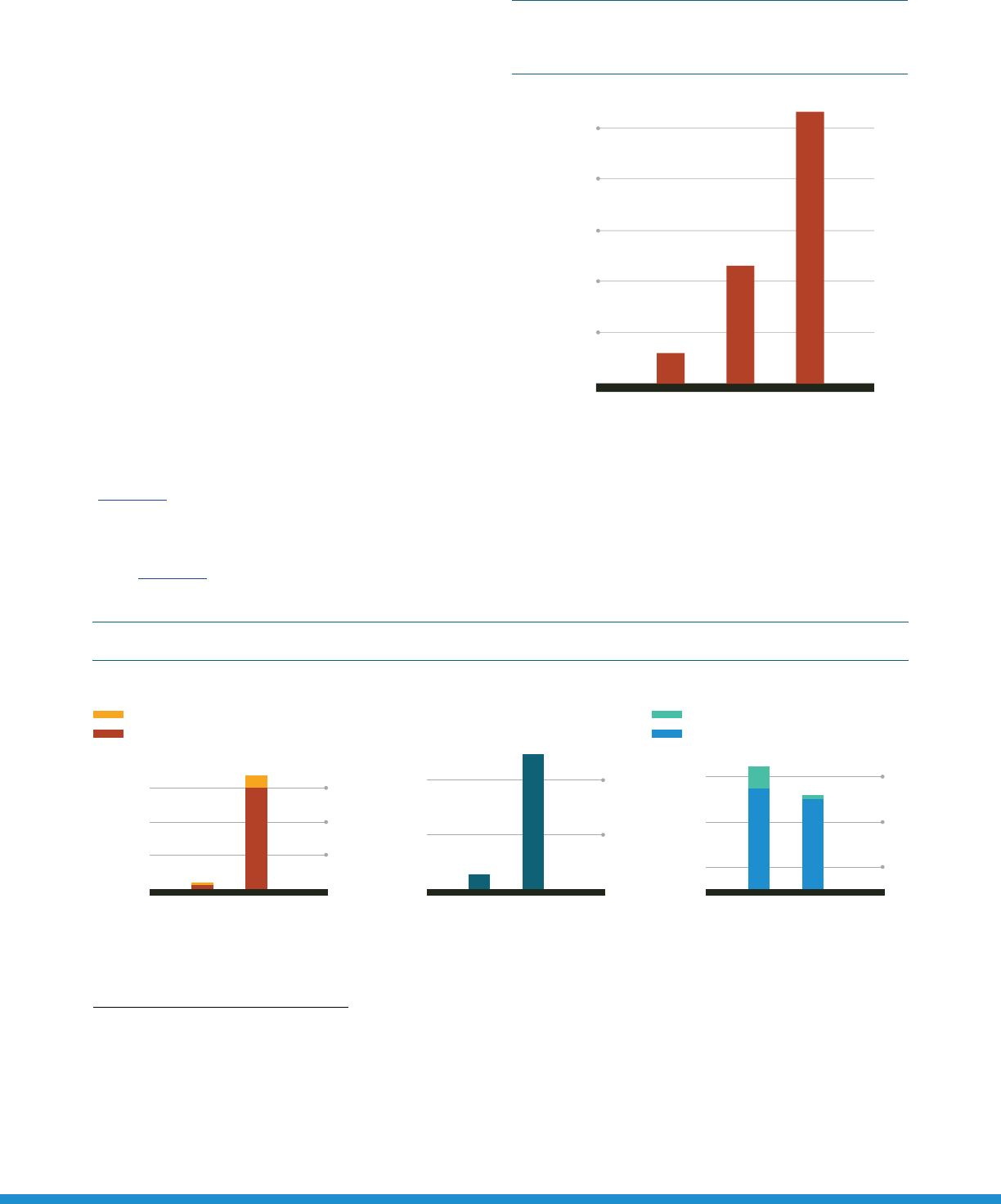
FUELS INSTITUTE | EVC | EV CONSUMER BEHAVIOR
27
do not have enough funds for a full tank (30%) or
they are too busy to fill up and perceive getting gas
as inconvenient (26%).
82
NACS: The Association for Convenience & Fuel
Retailing found that nearly 40 million Americans fill
up every day, and 59% of respondents said that price
dominates where they purchase fuel, but quality
of fuel, food, and employees aid their decision.
83
They also found that 33% of consumers prefer to
purchase fuel during the evening rush as opposed
to the morning rush, when 22% of the respondents
fueled up. Many drivers age 65 or more tend to fill up
midday while most drivers who purchase gas in the
morning are between the ages of 35 and 49.
CHARGING INFRASTRUCTURE REQUIREMENT
McKinsey predicts that the PEV-related energy
demand would go up almost tenfold by 2030
(Figure 24).
84
This falls in line with the prediction that
there could be between 12 and 15 million PEVs by
2030 — up by nearly 10 times of today’s 1.6 million
PEVs (Figure 25).
85
82
Karlie Kramer, “When Do You Fill Up Your Gas Tank?,” National Motorists Association, October 22, 2019, https://www.motorists.org/blog/when-do-you-fill-up-your-gas-tank/.
83 NACS, Consumer Behavior at the Pump, Consumer Insights series, March 2019, https://www.convenience.org/Topics/Fuels/Documents/How-Consumers-React-to-Gas-
Prices.pdf.
84 Engel et al., “Charging Ahead: Electric-Vehicle Infrastructure Demand”
85 Eric Wood, Clément Rames, Matteo Muratori, Sesha Raghavan, and Marc Melaina, National Plug-In Electric Vehicle Infrastructure Analysis (U.S. Department of Energy
Oice of Energy Eiciency and Renewable Energy, September 2017) https://www.nrel.gov/docs/fy17osti/69031.pdf; “FOTW #1153, September 28, 2020: Cumulative Plug-In
Vehicle Sales in the United States Reach 1.6 Million Units,” U.S. Department of Energy Oice of Energy Eiciency and Renewable Energy, September 28, 2020, https://www.
energy.gov/eere/vehicles/articles/fotw-1153-september-28-2020-cumulative-plug-vehicle-sales-united-states-reach; Thibaut Abergel, Till Bunsen, Marine Gorner, Pierre
Leduc, Sarbojit Pal, Leonardo Paoli, Seshadri Raghavan, et al. Global EV Outlook 2020: Entering the Decade of Electric Drive? (International Energy Agency, June 2020) https://
webstore.iea.org/download/direct/3007.
United Sates
of America
Billion kilowatt hours
SUV
PHEV
BEV
Sedan
Trucks
Conventional Electric
New Car Buyers
Positive/negative
opinion about
electric vehicles
2020 2025 2030
10
20
30
40
50
60
4000
21% 12% 10% 57%
20% 16% 4% 60%
31% 19% 10% 40%
39% 18% 9% 34%
37% 20% 10% 33%
2021
2022
2023
2024
2025
2026
2027
2028
2029
2030
1.72M
2020 2025 2030
1%
2%
2015 2018
2,677
5,461
10,560
11,242
29.2 32.8 35.8 39.4 41.4 39.9 41.2 41.3
2,677
6
53
23
57%
16%
14%
12%
7%
51%
40%
Home
Overnight
Twice a week
Nearby fast charger
10 minute
Twice a week
Nearby fast charger
30 minute
Once a week
Shopping ctr/Restaurant
4 hours
Once a week
Shopping ctr/Restaurant
2 hours
Twice a week
FIGURE 24: CHARGING ENERGY DEMAND
PREDICTION FOR PERSONAL EVS IN BILLION
KILOWATT-HOURS
Note: Annual mileage is estimated at 18,095 km and battery eiciency
estimated at approximately 20 kWh per 100 km.
Note: 2020 PEV numbers are estimated based on the assumption that all PEVs sold since 2010 are still in operation; 2020 data is accurate as of August
2020 and does not estimate PEV sales through the end of the year nor infrastructure developed through the end of the year.
United Sates
of America
Conventional
SUV
PHEV
BEV
Sedan
Trucks
Conventional Electric
New Car Buyers
Number of charging plugs
626k
626k
Number of PEVs Charging plugs per 1,000 PEVs
Positive/negative
opinion about
electric vehicles
Likeliness to consider
an electric vehicle next
time they buy/lease
Likeliness to consider an
EV is given a guaranteed
$7500 tax rebate
2020 2030
200,000
400,000
600,000
42
54
2020 2030
10
30
50
15.0M
1.6M
2020 2030
6,000,000
12,000,000
4000
21% 12% 10% 57%
20% 16% 4% 60%
31% 19% 10% 40%
39% 18% 9% 34%
37% 20% 10% 33%
601k
25k
72k
16k
40
2
45
10
27% 57% 14%
20%
Democrats
Independent
Republican
Others
3%
18% 57% 20%
5%
16% 54% 24%
6%
18% 55% 22%
6%
16% 26%37% 20%
20%
10% 34% 24%
8% 33% 32%
17% 28%
33%
27%
38% 17%
48% 30% 16%
20%
1%
35% 36% 23%
2%
37% 34% 22%
3%
37% 37% 22%
2%
4%
4%
4%
8%
2,677
5,461
10,560
11,242
29.2 32.8 35.8 39.4 41.4 39.9 41.2 41.3
2,677
FIGURE 25: CURRENT INFRASTRUCTURE AVAILABILITY AND 2030 FORECAST OF PUBLIC CHARGERS
DCFC charger
Level 2 charger Level 2 per 1,000 PEVs
DCFC per 1,000 PEVs
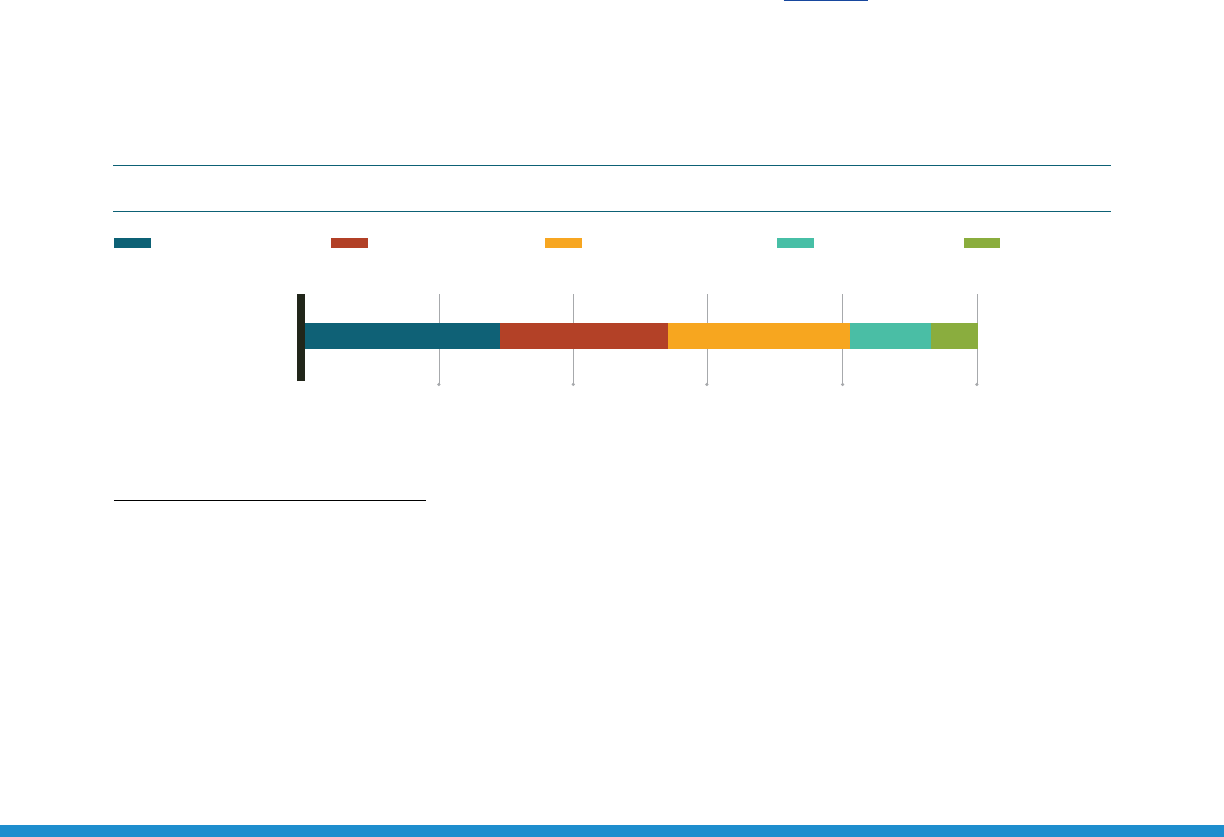
FUELS INSTITUTE | EVC | EV CONSUMER BEHAVIOR
28
Although approximately 70%-80% of charging takes place at home or at work,
86
EVs are expected to be driven
like present-day ICE vehicles.
87
A study by Navigant Research estimates that 95 DCFC stations along major
highway corridors would enable travel across the U.S. and that 408 DCFC stations would suice to meet
long-distance travel needs of EVs in the 100 largest metropolitan areas of the U.S.
88
Analysis by the National
Renewable Energy Laboratory (NREL) in 2017 found that DCFC stations would be required to be spaced 70
miles apart on average to provide BEV drivers access across the U.S. interstate system. Their analysis further
revealed that to dispel range anxiety concerns, BEV drivers in cities and towns must never be more than three
miles from a DCFC, requiring 8,200 charging stations (25,000 plugs) across the U.S. for a 15 million
PEV projection.
89
This number appears to be the bare minimum since automotive OEMs are already partnering with charging
providers to install DCFC stations. As an example, General Motors alone in partnership with EVgo will add
2,700 DCFC stations by 2025.
90
WHY DOES THE CUSTOMER CHOOSE A PARTICULAR PUBLIC
RECHARGING FACILITY?
LEVEL 2 CHARGING AVAILABILITY’S INFLUENCE ON CONSUMER PERCEPTION OF
AVAILABILITY, CAPACITY, AND CONVENIENCE COMPARED TO DCFC EQUIPMENT
In CleanTechnica’s survey of current and potential EV drivers, 46% of respondents feel that DCFC is not
“very important” and 54% felt it was “very important” or a “requirement”(Figure 26).
91
In a dierent study,
CleanTechnica found that approximately 70% of BEV drivers used DCFC only a few times a year (Figure 27).
92
In the same study, approximately 42% of non-Tesla BEV drivers think the current EV charging network is “very
adequate,” and approximately 33% think it is “somewhat adequate.”
86 “Charging at Home,” Oice of Energy Eiciency and Renewable Energy; Volvo Car USA, The State of Electric Vehicles in America
87 Eric Wood et al., National Plug-In Electric Vehicle Infrastructure Analysis
88 Navigant Research, “408 High-Power DC Charging Stations Would Meet Long-Distance Travel Needs for Battery Electric Vehicles in the Top 100 U.S. Metropolitan Areas,”
Guidehouse Insights, June 21, 2016, https://guidehouseinsights.com/news-and-views/408-highpower-dc-charging-stations-would-meet-longdistance-travel-needs-for-
battery-electric-vehicle.
89 Eric Wood et al., National Plug-In Electric Vehicle Infrastructure Analysis
90 John Voelcker, “GM to Fund Expansion of EVgo Fast-Charging Network For Electric Cars,” Charged Electric Vehicles Magazine, July 31, 2020, https://chargedevs.com/
newswire/gm-to-fund-expansion-of-evgo-fast-charging-network-for-electric-cars/.
91 CleanTechnica, Electric Cars: What Early Adopters and First Followers Want, 2015, available at https://future.cleantechnica.com/reports/electric-cars-what-early-
adopters-and-first-followers-want.
92 CleanTechnica, Electric Car Drivers: Desires, Demands, and Who They Are, 2016, available at https://cleantechnica.com/files/2017/05/Electric-Car-Drivers-Report-Surveys-
CleanTechnica-Free-Report.pdf.
Quite unimportant Somewhat important Very important Requirement
United Sates
of America
BEV buyers
SUV
PHEV
BEV
Sedan
Trucks
Conventional Electric
New Car Buyers
New Car Buyers
Country Population
United Sates of America 2,677
Brazil 5,461
Mexico 10,560
Argentina 11,242
4000
6000
21% 12% 10% 57%
20% 16% 4% 60%
31% 19% 10% 40%
39% 18% 9% 34%
37%
29% 25% 27% 7%12%
20% 10% 33%
2,677
5,461
10,560
11,242
2,677
5,461
10,560
11,242
7,731,952
29.2 32.8 35.8 39.4 41.4 39.9 41.2 41.3
2,677
FIGURE 26: IMPORTANCE OF DCFC WHEN BUYING A BEV (2016)
Not at all important
Note: Surveyed participants from the U.S. (approximately 75%), Canada (approximately 8%), and the U.K. and Australia (<10% combined)
Source: CleanTechnica, Electric Car Drivers: Desires, Demands, and Who They Are
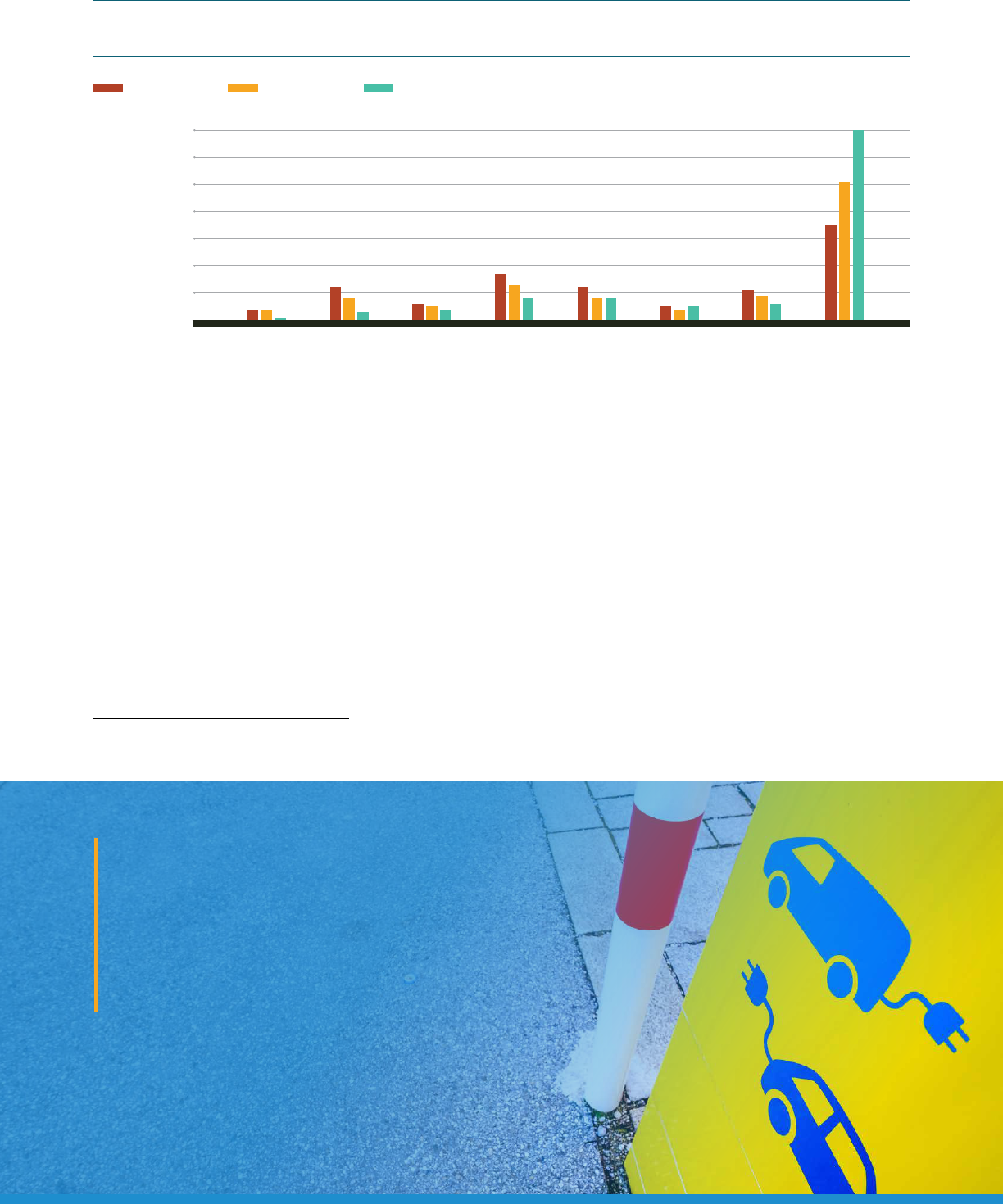
FUELS INSTITUTE | EVC | EV CONSUMER BEHAVIOR
29
Tesla, as of August 2020, owned 8,509 Superchargers (equivalent to DCFCs) and 11,685 Destination Charging
locations (equivalent to Level 2 chargers), which makes the Tesla network approximately 54% of all DCFCs
in the U.S. and approximately 16% of all Level 2 chargers. Non-Tesla EV drivers currently have access to
approximately 7,000 DCFCs and approximately 60,000 Level 2 chargers.
93
These data points suggest that current EV owners are not deterred by today’s EV infrastructure; rather, they
have found ways to use EVs around potential infrastructure limitations. For mass adoption, it is important to
understand the views of buyers who do not consider EVs today. This can be pursued with a targeted survey
toward those individuals.
93 “FOTW #1153, September 28, 2020: Cumulative Plug-In Vehicle Sales in the United States Reach 1.6 Million Units”
FIGURE 27: FREQUENCY OF PUBLIC CHARGER USAGE BY PERCENTAGE
(NORTH AMERICAN NON-TESLA DRIVERS) (2017)
2007
Few
times a
week
Once a
week
Few
times a
month
Once a
month
Every
other
month
Once
every few
months
Few times
a year
or less
Everyday
20092008 2010 20142013 201520122011 2016 2017 2018
Percent of time charging
10%
20%
30%
40%
60%
60%
70%
0.8
26.6
7,731,952
29.2 32.8 35.8 39.4 41.4 39.9 41.2 41.3
Light Vehicles Passenger Trucks Lorries and Cargo Trucks Motorcycles
1981
1982
1983
1984
1985
1986
1987
1988
1989
1990
1991
1992
1993
1994
1995
1996
1997
1998
1999
2000
2001
2002
2003
2004
2005
2006
2007
2008
2009
2010
2011
2012
2013
2014
2015
2016
2017
Level 2 BEV DCFC PHEV DCFC BEV
Current EV owners are
not deterred by today’s
EV infrastructure; finding
ways to use their EVs around
potential infrastructure
limitations.
29
Source: CleanTechnica, Electric Car Drivers: Desires, Demands, and Who They Are

FUELS INSTITUTE | EVC | EV CONSUMER BEHAVIOR
30
INFLUENCE OF CHARGING
EQUIPMENT BRAND
94
EV drivers’ selection of a particular brand of charger
can be influenced by the following factors:
1) Built-in equipment: Vehicles like the Hyundai
Ioniq and Chevrolet Bolt EV usually either have
a ChargePoint or similar charge card in the
glovebox of the vehicle when bought new.
95
Many drivers, since the charge card is already
available, tend to use the corresponding brand
of charging network. Tesla, with the charging
application integrated into the infotainment
system, allows for seamless operation within its
network. Nissan Leafs ship with an EZ Card that
allows the driver to use chargers operated by
ChargePoint, Blink, Network from Car Charging
Group, AeroVironment, and NRG EVgo.
96
2) Familiarity: Charging network providers
like ChargePoint and Blink also make home
chargers.
97
When a consumer has one of them
installed at home, familiarity with the home
charger could bias their choice of a public
charger used especially when they are new to
owning EVs.
3) Dependability: Consumer Reports notes that
some networks are more dependable than
others and that chargers at newer stations can
be out of service.
98
4) Availability: ChargePoint has more than 35,000
Level 2 chargers in the U.S., which is just shy of
the combined total of all other networks’ Level 2
chargers combined.
99
However, networks are
94 The topic discussed in this section of the report has limited public domain data, so inference is based on relevant knowledge and experience.
95 Jeannie Lam, “Everything You Need to Know About the Hyundai Ioniq Electric,” ChargePoint, February 20, 2017, https://www.chargepoint.com/blog/everything-you-
need-know-about-hyundai-ioniq-electric/.
96 Nissan North America, “Nissan Launches Programs to Make Leaf Charging Free and “EZ,” news release, ChargePoint, April 2014, https://www.chargepoint.com/about/
news/nissan-launches-programs-make-leaf-charging-free-and-ez/.
97 Gabe Shenhar and Je S. Bartlett, “How to Choose the Best Home Wall Charger for Your Electric Vehicle,” Consumer Reports, September 30, 2020, https://www.
consumerreports.org/hybrids-evs/how-to-choose-the-best-home-wall-charger-for-your-electric-vehicle/.
98 Je Plungis, “How the Electric Car Charging Network Is Expanding,” Consumer Reports, November 12, 2019, https://www.consumerreports.org/hybrids-evs/electric-car-
charging-network-is-expanding/.
99 “Alternative Fueling Station Locator,” Alternate Fuels Data Center, Oice of Energy Eiciency and Renewable Energy, U.S. Department of Energy, accessed October 29,
2020, https://afdc.energy.gov/stations/#/analyze.
100 “Alternative Fueling Station Locator,” Alternate Fuels Data Center
not uniformly distributed throughout the
country. Hence, a customer’s choice could
sometimes be based on availability, rather than
by choice. For example, in Alaska, out of the 39
available Level 2 plugs, only eight are operated
by ChargePoint and 24 are non-networked.
100
So, an EV owner in Alaska might prefer signing
up with ChargePoint to have access to eight
chargers, which is more convenient than
signing up individually with various standalone
providers that operate each of the other chargers.
5) Charging host: A customer may prefer to use a
particular charger network based on their needs
and habits. For example, a customer who shops
at a particular grocery store, where a charger of a
certain network is installed, might choose to use
that particular network for their charging needs
because they go there anyway and plugging in
would be an added convenience.
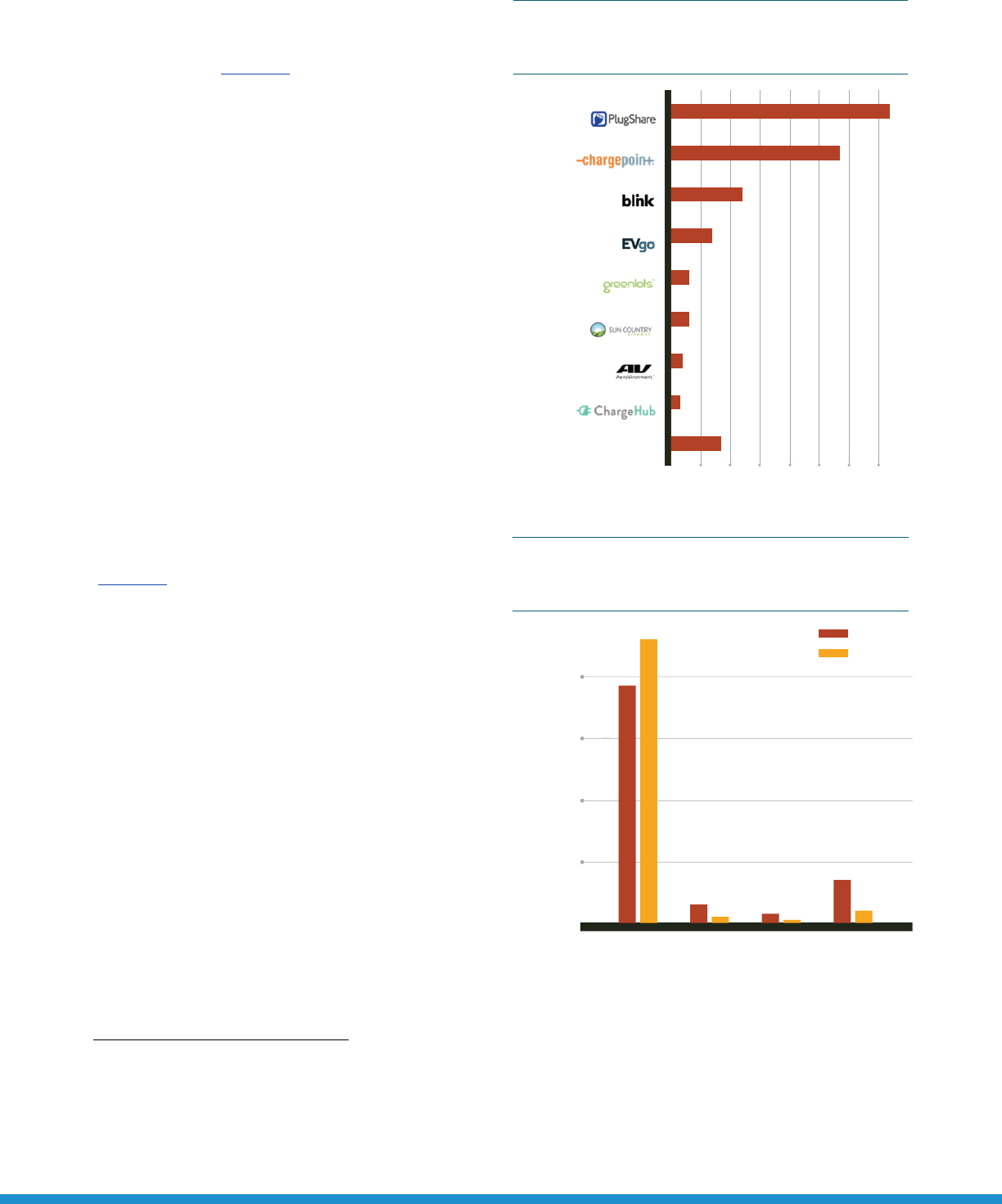
FUELS INSTITUTE | EVC | EV CONSUMER BEHAVIOR
31
CleanTechnica found that PlugShare was the
most popular app — it had been used by 74% of
the participants (Figure 28).
101
Various sources point to the fact that on average
PEV drivers rely on public charging stations for
only 20%-33% of their charging needs, and the
remaining 67%-80% of charging happens at
home or at work.
102
More than 80% of drivers
use only three public locations or fewer for their
charging needs away from home and work.
Cumulatively, approximately 38% of all PEVs sold
were Tesla vehicles before 2019,
103
and in 2019,
58% of all PEVs sold were Tesla vehicles. Tesla
has their Superchargers network integrated onto
the infotainment system, negating the need for
an app. Based on this, it would be safe to assume
that fewer than 5% of EV drivers use apps on
a daily or frequent basis to locate charging
stations. It is likely that EV owners download at
least one of these apps, and app usage is likely
to be more frequent when in a new location
(Figure 29).
104
Going forward, OEMs are likely to provide
similar attributes to Tesla’s in-vehicle point-to-
point trip-planning feature. As more owners
use their EVs for long-distance travel, the need
for trip planning and finding public charging
will increase. However, use of such in-vehicle
features as opposed to smartphone apps
would depend on which method provides
seamless ease of use. OEMs could also plan to
integrate smart routing into their interface; with
availability of data such as power output and
vehicle state-of-charge, the in-car navigation
system could optimize the route by planning a
stop at a faster charging station to reduce overall
trip time.
101 CleanTechnica, Electric Cars: What Early Adopters and First Followers Want
102 Volvo Car USA, The State of Electric Vehicles in America; “Charging at Home,” Oice of Energy Eiciency and Renewable Energy
103 “U.S. Plug-in Electric Vehicle Sales by Model” (chart), “Maps and Data — U.S. Plug-in Electric Vehicle Sales by Model” (webpage), Alternate Fuels Data Center, Oice of
Energy Eiciency and Renewable Energy, U.S. Department of Energy, accessed October 10, 2020, https://afdc.energy.gov/data/10567.
104 John Galloway Smart and Shawn Douglas Salisbury, Plugged In: How Americans Charge Their Electric Vehicles
United Sates
of America
Conventional
SUV
PHEV
BEV
Sedan
Trucks
Conventional Electric
New Car Buyers
0.0
0.1 0.2 0.3 0.4 0.5 0.6 0.7 0.8
4000
21% 12% 10% 57%
20%
74%
57%
24%
14%
6%
6%
4%
3%
16% 4% 60%
31% 19% 10% 40%
39% 18% 9% 34%
37% 20% 10% 33%
PlugShare
ChargePoint
Blink
EVgo
Greenlots
Sun Country Highway
Aerovironment
EV ChargeHub
None
17%
2,677
5,461
10,560
11,242
29.2 32.8 35.8 39.4 41.4 39.9 41.2 41.3
2,677
FIGURE 28: WEBSITES/APPS FOR NORTH
AMERICAN EV OWNERS TO LOCATE EV
CHARGING STATIONS (2017)
United Sates
of America
Percentage of charging locations
SUV
PHEV
BEV
Sedan
Trucks
Conventional Electric
New Car Buyers
Positive/negative
opinion about
electric vehicles
2020 2025 2030
4000
21% 12% 10% 57%
20% 16% 4% 60%
31% 19% 10% 40%
39% 18% 9% 34%
37% 20% 10% 33%
2021
2022
2023
2024
2025
2026
2027
2028
2029
2030
77%
92%
6%
2%
3%
1%
14%
4%
1.72M
3 or
Fewer
More
than 5
4 5
3 or Fewer 4 5 More
than 5
2,677
5,461
10,560
11,242
29.2 32.8 35.8 39.4 41.4 39.9 41.2 41.3
2,677
Home
Overnight
Twice a week
Nearby fast charger
10 minute
Twice a week
Nearby fast charger
30 minute
Once a week
Shopping ctr/Restaurant
4 hours
Once a week
Shopping ctr/Restaurant
2 hours
Twice a week
FIGURE 29: NUMBER OF AWAY-FROM-HOME
LOCATIONS WHERE DRIVERS DO MOST CHARGING
(2011-2014)
Volt
Leaf
Source: CleanTechnica, Electric Cars: What Early Adopters and First
Followers Want
Note: Data collected between 2011 and 2014
Source: John Galloway Smart and Shawn Douglas Salisbury, Plugged In:
How Americans Charge Their Electric Vehicles
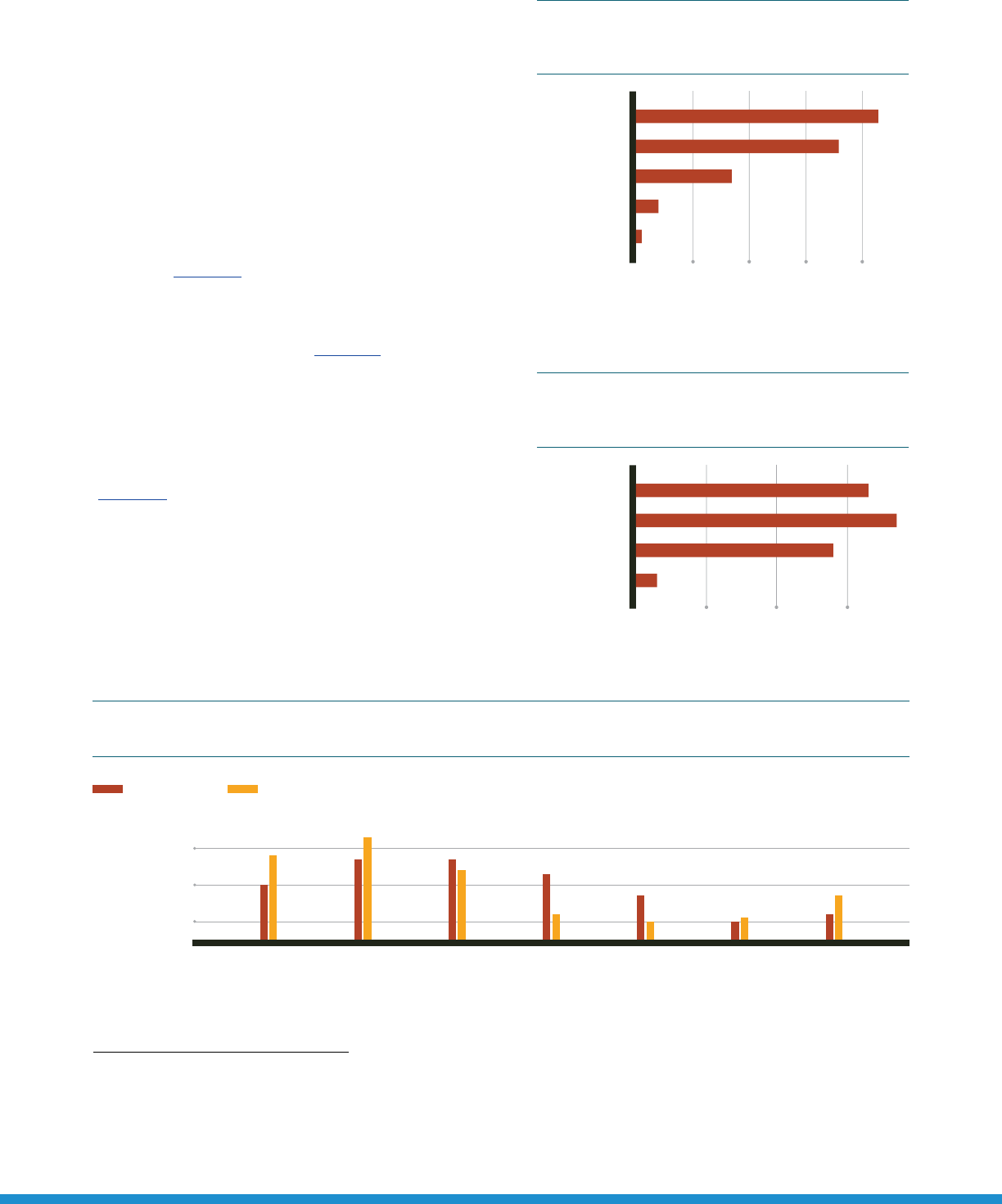
FUELS INSTITUTE | EVC | EV CONSUMER BEHAVIOR
32
2007
$1
per hour
$2
per hour
$3
per hour
$4
per hour
No limit Won’t use$0.75
per hour
20092008 2010 20142013 201520122011 2016 2017 2018
Percent of respondents
15%
23%
22%
28%
22%
19%
18%
7%
12%
5%
5%
6%
7%
12%
0.00
5%
10%
15%
20%
25%
30%
26.6
7,731,952
29.2 32.8 35.8 39.4 41.4 39.9 41.2 41.3
Light Vehicles Passenger Trucks Lorries and Cargo Trucks Motorcycles
1981
1982
1983
1984
1985
1986
1987
1988
1989
1990
1991
1992
1993
1994
1995
1996
1997
1998
1999
2000
2001
2002
2003
2004
2005
2006
2007
2008
2009
2010
2011
2012
2013
2014
2015
2016
2017
HOW DO CUSTOMERS INTERACT WITH
CHARGING EQUIPMENT?
EV CONSUMERS’ WILLINGNESS TO PAY FOR
CHARGING SERVICES AND THE INFLUENCE
OF PRICE IN THIS PERCEPTION
ESource, in their survey of current and potential PEV
owners, found that 57% of respondents are willing to
pay a premium to use a DCFC, and 22% of respondents
are willing to pay a premium of 50% or more for access
to a DCFC (Figure 30).
105
When asked to compare
EV charging to paying for gas, 70% of respondents
perceived that they pay the same or less to charge an
EV as compared to buying gas (Figure 31).
106
In this same study, ESource further found that 44%
of PEV owners are willing to pay between $1-$2 per
hour to use a public charger with an assumption
that at-home charging is valued at $0.75 per hour
(Figure 32).
107
The willingness is observed to steadily
decline at rates greater than $2 per hour. Potential
PEV owners, on the other hand, appear to be more
price sensitive — their willingness to pay for public
charging peaks at $1 per hour and declines at higher
prices, and 12% of respondents claim that they
would not use a public Level 2 charger.
108
105 Bill LeBlanc, “EV Charging and Pricing: What Are Consumers Willing To Pay?,” ESource, September 1, 2020, https://www.esource.com/429201ebtf/ev-charging-and-
pricing-what-are-consumers-willing-pay.
106 Bill LeBlanc, “EV Charging and Pricing: What Are Consumers Willing To Pay?”
107 Bill LeBlanc, “EV Charging and Pricing: What Are Consumers Willing To Pay?”
108 Bill LeBlanc, “EV Charging and Pricing: What Are Consumers Willing To Pay?”
United Sates
of America
Conventional
SUV
PHEV
BEV
Sedan
Trucks
Conventional Electric
New Car Buyers
Positive/negative
opinion about
electric vehicles
4000
43%
36%
17%
4%
1%
1.7%
99.0%
1.0%
99.7%
0.3%
99.7%
0.3%
99.6%
0.4%
99.6%
0.4%
99.4%
0.6%
99.7%
0.3%
99.2%
0.8%
99.6%
0.4%
21% 12% 10% 57%
20% 16% 4% 60%
31% 19% 10% 40%
39% 18% 9% 34%
37% 20% 10% 33%
Same price
25% more
50% more
Twice more
Four times more
2,677
5,461
10,560
11,242
29.2 32.8 35.8 39.4 41.4 39.9 41.2 41.3
2,677
United Sates
of America
Conventional
SUV
PHEV
BEV
Sedan
Trucks
Conventional Electric
New Car Buyers
Positive/negative
opinion about
electric vehicles
4000
33%
37%
28%
3%
1.7%
99.0%
1.0%
99.7%
0.3%
99.7%
0.3%
99.6%
0.4%
99.6%
0.4%
99.4%
0.6%
99.7%
0.3%
99.2%
0.8%
99.6%
0.4%
21% 12% 10% 57%
20% 16% 4% 60%
31% 19% 10% 40%
39% 18% 9% 34%
37% 20% 10% 33%
Less
Same
More
Don’t know
2,677
5,461
10,560
11,242
29.2 32.8 35.8 39.4 41.4 39.9 41.2 41.3
2,677
FIGURE 30: AMOUNT RESPONDENTS WOULD
PAY FOR A DCFC COMPARED TO A LEVEL 2
CHARGER (2020)
FIGURE 31: AMOUNT RESPONDENTS PERCEIVE
THEY PAY TO CHARGE A PEV COMPARED TO
BUYING GAS (2020)
FIGURE 32: AMOUNT RESPONDENTS ARE WILLING TO PAY FOR PUBLIC LEVEL 2 CHARGING ASSUMING
COST TO CHARGE AT HOME IS $0.75 PER HOUR (2020)
PEV owner Potential PEV buyer
Note: Data includes U.S. and Canada respondents who own or are
considering owning a PEV
Source: Bill LeBlanc, “EV Charging and Pricing: What Are Consumers
Willing To Pay?”
Note: Data includes U.S. and Canada respondents who own a PEV
Source: Bill LeBlanc, “EV Charging and Pricing: What Are Consumers
Willing To Pay?”
Note: Data includes U.S. and Canada respondents
Source: Bill LeBlanc, “EV Charging and Pricing: What Are Consumers Willing To Pay?”
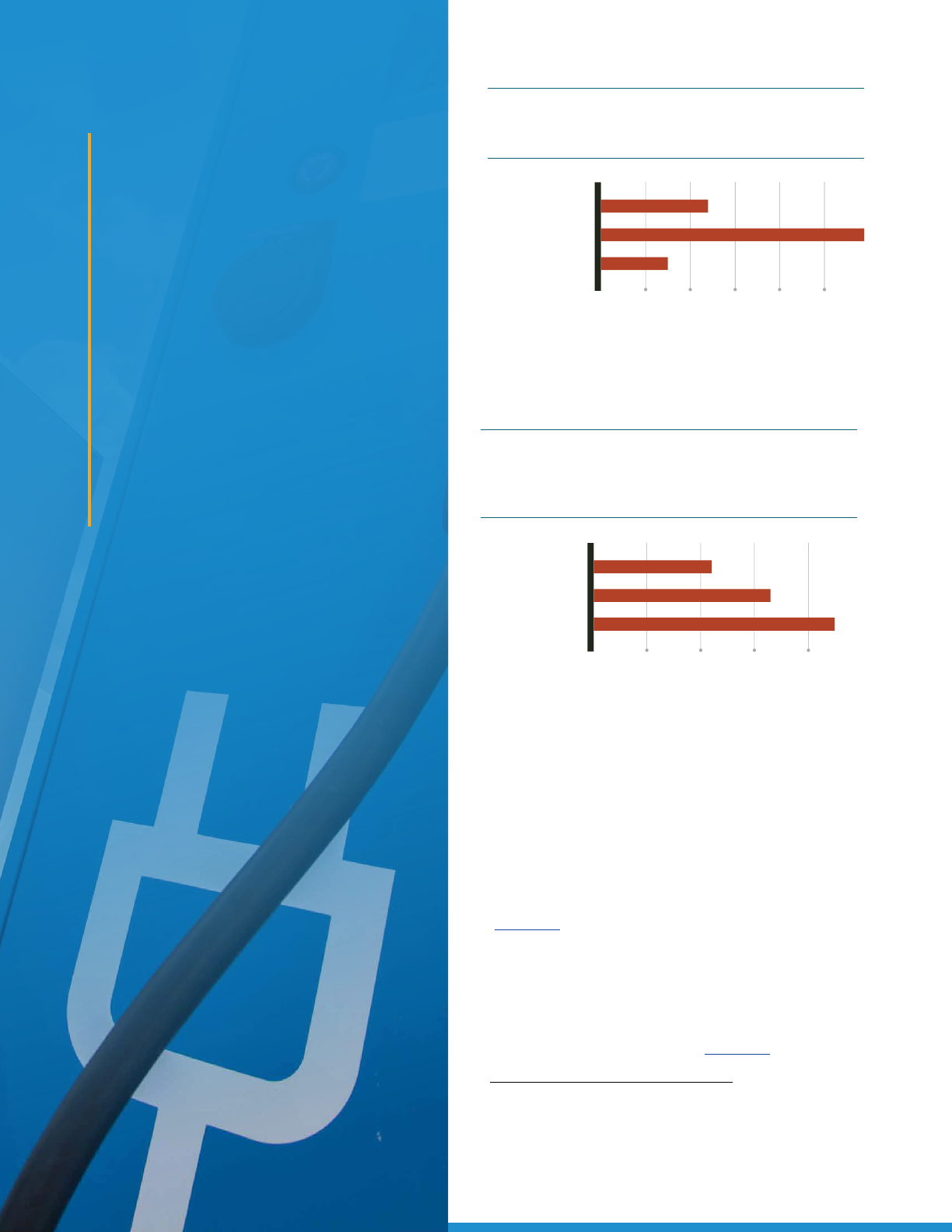
FUELS INSTITUTE | EVC | EV CONSUMER BEHAVIOR
33
United Sates
of America
Conventional
SUV
PHEV
BEV
Sedan
Trucks
Conventional Electric
New Car Buyers
Positive/negative
opinion about
electric vehicles
4000
24%
59%
15%
1.7%
99.0%
1.0%
99.7%
0.3%
99.7%
0.3%
99.6%
0.4%
99.6%
0.4%
99.4%
0.6%
99.7%
0.3%
99.2%
0.8%
99.6%
0.4%
21% 12% 10% 57%
20% 16% 4% 60%
31% 19% 10% 40%
39% 18% 9% 34%
37% 20% 10% 33%
Every chance
When convenient
Emergencies
2,677
5,461
10,560
11,242
29.2 32.8 35.8 39.4 41.4 39.9 41.2 41.3
2,677
United Sates
of America
Conventional
SUV
PHEV
BEV
Sedan
Trucks
Conventional Electric
New Car Buyers
Positive/negative
opinion about
electric vehicles
4000
22%
33%
45%
1.7%
99.0%
1.0%
99.7%
0.3%
99.7%
0.3%
99.6%
0.4%
99.6%
0.4%
99.4%
0.6%
99.7%
0.3%
99.2%
0.8%
99.6%
0.4%
21% 12% 10% 57%
20% 16% 4% 60%
31% 19% 10% 40%
39% 18% 9% 34%
37% 20% 10% 33%
Every chance
When convenient
Emergencies
2,677
5,461
10,560
11,242
29.2 32.8 35.8 39.4 41.4 39.9 41.2 41.3
2,677
FIGURE 33: FREQUENCY OF USAGE WHEN
RESPONDENTS ARE TOLD DCFC IS AVAILABLE
AT A PREMIUM (2020)
FIGURE 34: FREQUENCY OF USAGE WHEN
RESPONDENTS ARE TOLD DCFC IS AVAILABLE
AT A PREMIUM AND ABOUT THE POSSIBILITY
OF BATTERY DEGRADATION (2020)
FUELS INSTITUTE | EVC | EV CONSUMER BEHAVIOR
Fifty-seven percent
of respondents
are willing to pay a
premium to use
a DCFC.
Potential PEV owners,
on the other hand,
appear to be more
price sensitive — their
willingness to pay for
public charging peaks
at $1 per hour.
When participants were asked how frequently they
would use a DCFC if they had to pay a premium,
59% responded they would use it when convenient
and 24% said they would plug in at every chance
(Figure 33).
109
This response changed drastically
when informed about the possibility of battery
degradation with DCFC.
110
In that case, 45% said
they would only use a DCFC in an emergency (up
from 15%), and 33% said they would plug in when
convenient (down from 59%) (Figure 34).
111
109 Bill LeBlanc, “EV Charging and Pricing: What Are Consumers Willing To Pay?”
110 Idaho National Laboratory, DC Fast Charge Eects on Battery Life and
Performance Study – 50,000 Mile Update, April 15, 2014, https://www.energy.gov/
sites/prod/files/2015/01/f19/dcfc_study_fs_50k.pdf.
111 Bill LeBlanc, “EV Charging and Pricing: What Are Consumers Willing To Pay?”
Note: Data includes U.S. and Canada respondents who own or are
considering owning a PEV.
Source: Bill LeBlanc, “EV Charging and Pricing: What Are Consumers
Willing To Pay?”
Note: Data includes U.S. and Canada respondents who own or are
considering owning a PEV.
Source: Bill LeBlanc, “EV Charging and Pricing: What Are Consumers
Willing To Pay?”
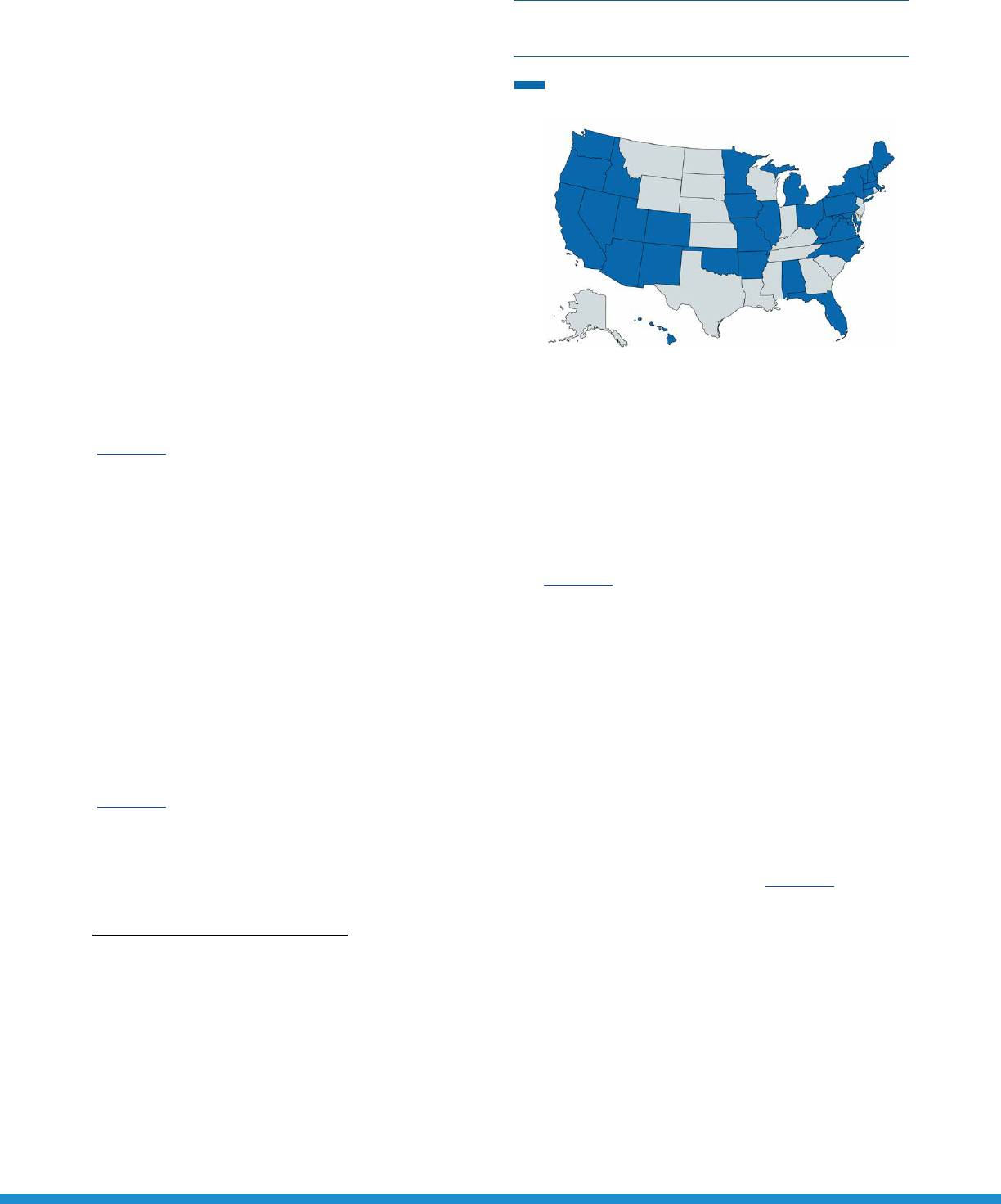
FUELS INSTITUTE | EVC | EV CONSUMER BEHAVIOR
34
EV CONSUMERS’ PERCEPTION OF
VARIOUS BILLING METHODS
In the 2013 PlugShare and PluginCars.com survey,
the large majority of respondents (73%) preferred
being charged by the energy used in recharging their
vehicles as opposed to being charged by time spent
recharging their vehicles.
112
The mindset of today’s
EV drivers is not very dierent from the findings of
that survey — being charged by the energy drawn is
very closely comparable to filling gas at a gas station
in a conventional vehicle where the driver pays for
the energy drawn and not by pumping time. Since
that time, more than 30 states have allowed pricing
per kWh instead of per minute. Both methods are
now used, with Tesla declaring that charging per
kWh to be most fair and simple. A shown by
(Figure 35),
113
charging providers ChargePoint, EVgo,
and Electrify America also oer this option.
114
The University of Michigan Transport Research
Institute conducted a study to assess respondents’
preferred payment method, including current
and prospective EV owners. The results showed
that “pay-per-use” setup was marginally preferred
over “automatic authorization,” where pay-per-use
involved providing an ID and billing information,
such as a credit card, RFID card, or cash, and
automatic authorization involved the vehicle
identifying itself and the customer being charged
on the payment method on file on their account
(Figure 36).
115
Respondents marginally preferred
a “pre-negotiated billing rate” as opposed to a
“variable billing rate;” for a pre-negotiated billing
rate, the driver would use pre-negotiated pricing
112 Brad Berman, “Comprehensive Study of EV Drivers Reveals Plug-in Attitudes”, plugincars.com, November 14, 2013, https://www.plugincars.com/comprehensive-study-
ev-drivers-reveals-plug-attitudes-128883.html.
113 ChargePoint, 25 States, DC, and Austin, Allow Third-Parties to Include per-kWh Fee in Pricing to Driver (aka, “Charge for Charging”), April 2019, https://assets.ctfassets.
net/ucu418cgcnau/fYtvhoCe1g93DtTrZO5gS/83c2e4c2581a39d30ac293ce33472b42/2019_States_with_exemption_for_charging_April_2019.pdf; Bengt Halvorson,
“Electrify America Reboots Pricing, Bills EV Charging by the kWh Where It’s Allowed,” Green Car Reports, September 16, 2020, https://www.greencarreports.com/
news/1129626_electrify-america-reboots-pricing-bills-ev-charging-by-the-kwh-where-its-allowed.
114 Charles Benoit, “30 States Allow kWh Pricing, But Non-Tesla EV Drivers Mostly Miss Benefits,” Electrek, August 12, 2019, https://electrek.co/2019/08/12/kwh-pricing-ev-
drivers-miss-benefits/; “Supercharging,” Support, Tesla, accessed October 18, 2020, https://www.tesla.com/support/supercharging.
115 Brandon Schoettle and Michael Sivak, Consumer Preferences for the Charging of Plug-in Electric Vehicles (Ann Arbor, MI: University of Michigan Sustainable Worldwide
Transportation, November 2016), http://umich.edu/~umtriswt/PDF/SWT-2016-13.pdf.
116 Brandon Schoettle and Michael Sivak, Consumer Preferences for the Charging of Plug-in Electric Vehicles
117 Brandon Schoettle and Michael Sivak, Consumer Preferences for the Charging of Plug-in Electric Vehicles
at any charging station, the vehicle would be
identified by the EVSE, and the driver would be
billed automatically to the payment method on
file (Figure 37).
116
Regarding cost and energy demand preference
when using a public charger, 73% of respondents
preferred “optimized charging” and 27% preferred
“on-demand charging.” Optimized charging in this
context means charging would be optimized based
on factors that aect cost, such as the vehicle’s
charging requirement and demand on the grid, with
a definite pre-set end time. On-demand charging,
on the other hand, means the vehicle is charged as
quickly as needed without regards to reducing costs
or electricity demand on the grid (Figure 38).
117
DRAFT
48
Note: Data gathered from ChargePoint (2019) and Electrify America (2020)
FIGURE 36: PAYMENT AUTHORIZATION TYPE PREFERENCE WHEN CHARGING IN PUBLIC
(2016)
120
FIGURE 37: PRICING TYPE PREFERENCE WHEN CHARGING IN PUBLIC (2016)
121
120
Brandon Schoettle and Michael Sivak, Consumer Preferences for the Charging of Plug-in Electric Vehicles (Ann
Arbor, MI: University of Michigan Sustainable Worldwide Transportation, November 2016)
http://umich.edu/~umtriswt/PDF/SWT-2016-13.pdf.
121
Brandon Schoettle and Michael Sivak, Consumer Preferences for the Charging of Plug-in Electric Vehicles
FIGURE 35: STATES PERMITTING KWH PRICING
FOR EV CHARGING (2019-2020)
States permitting kWh pricing
Source: ChargePoint, 25 States, DC, and Austin, Allow Third-Parties to
Include per-kWh Fee in Pricing to Driver (aka, “Charge for Charging”);
Bengt Halvorson, “Electrify America Reboots Pricing, Bills EV Charging
by the kWh Where It’s Allowed”
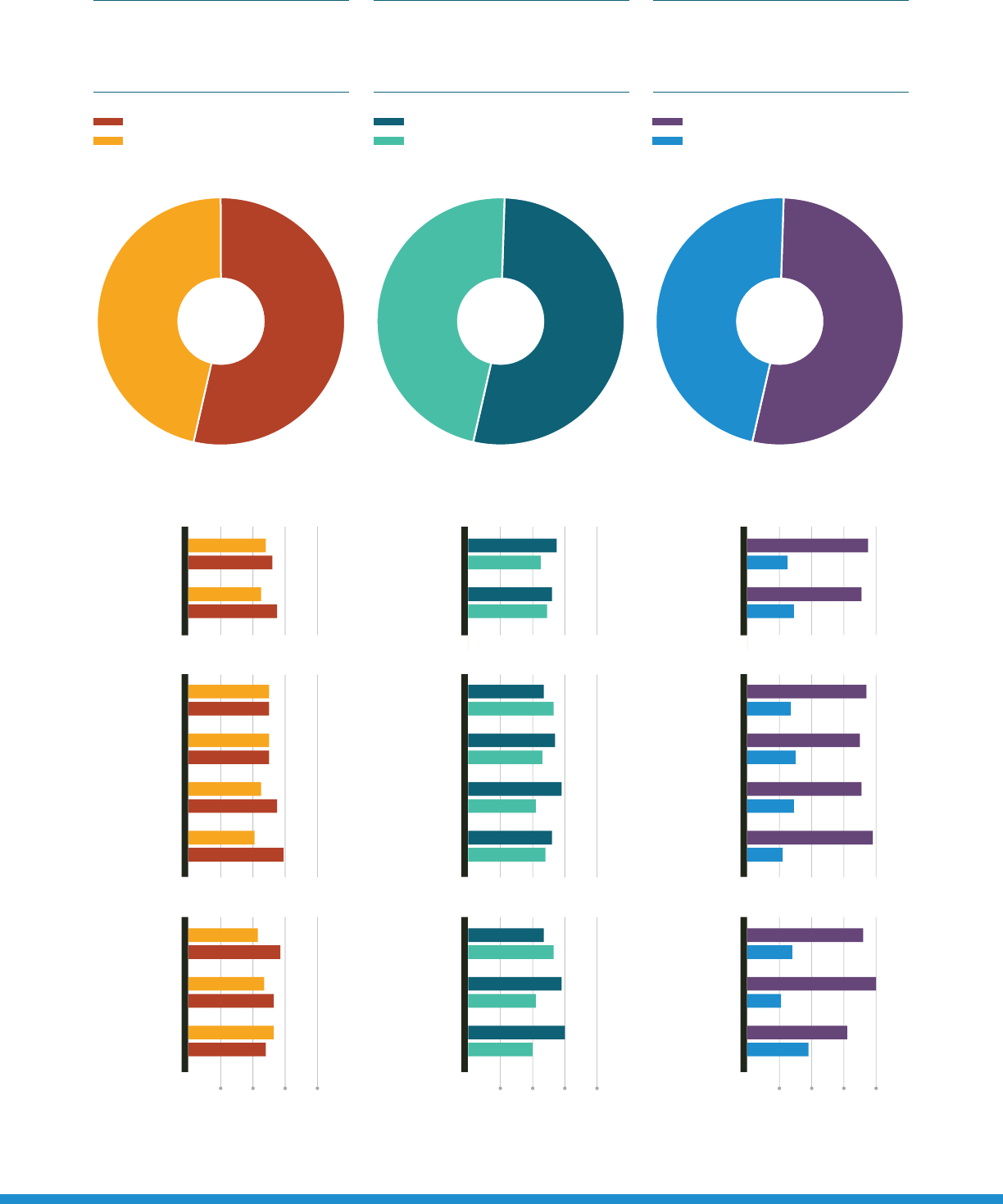
FUELS INSTITUTE | EVC | EV CONSUMER BEHAVIOR
35
FIGURE 36:
PAYMENT AUTHORIZATION TYPE
PREFERENCE WHEN CHARGING
IN PUBLIC (2016)
FIGURE 37:
PRICING TYPE PREFERENCE
WHEN CHARGING IN PUBLIC
(2016)
FIGURE 38:
COST AND ENERGY DEMAND
PREFERENCE WHEN CHARGING
IN PUBLIC (2016)
United Sates
of America
Conventional
Gender
Age group
Income bracket
Positive/negative
opinion about
electric vehicles
Payment Authorization Type
Split by demographic
Pricing Type Cost And Energy Demand
Gender
Age group
Income bracket
Split by demographic
Gender
Age group
Income bracket
Split by demographic
22%
99.0%
99.7%
99.7%
99.6%
99.6%
99.4%
99.7%
99.2%
99.6%
46.5%
Automatic
authorization
53.5%
Pay-per-use
Female
Male
18-29
30-44
45-59
60+
<$49k
$50k-$124k
>$125k
0 20% 40% 60% 80% 100%
48%
52%
45%
55%
50%
50%
50%
50%
45%
55%
41%
59%
43%
57%
47%
53%
53%
48%
22%
47%
Variable-
rate billing
53%
Pre-negotiated
billing rate
Female
Male
18-29
30-44
45-59
60+
<$49k
$50k-$124k
>$125k
0.0 20% 40% 60% 80% 1.0
55%
45%
52%
49%
47%
53%
54%
46%
58%
42%
52%
48%
47%
53%
58%
42%
60%
40%
22%
27%
On-demand
charging
73%
Optimized
charging
Female
Male
18-29
30-44
45-59
60+
<$49k
$50k-$124k
>$125k
0.0 20% 40% 60% 80% 1.0
75%
25%
71%
29%
74%
27%
70%
30%
71%
29%
78%
22%
72%
28%
80%
21%
62%
38%
Automatic authorization Variable-rate billing On-demand charging
Pay-per-use Pre-negotiated billing rate Optimized charging
Source (Figures 36-38): Brandon Schoettle and Michael Sivak, Consumer Preferences for the Charging of Plug-in Electric Vehicles
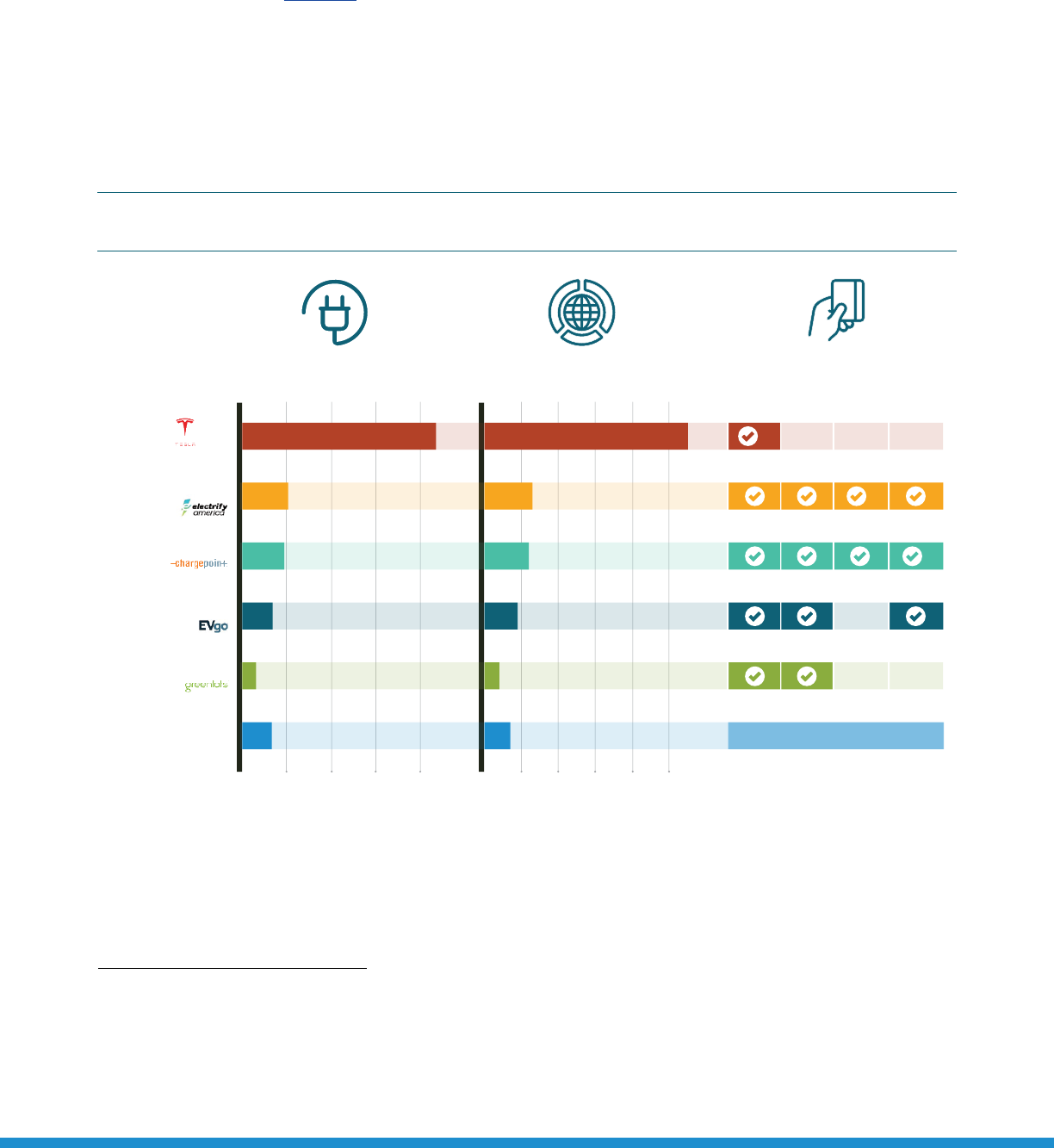
FUELS INSTITUTE | EVC | EV CONSUMER BEHAVIOR
36
FIGURE 39: INFOGRAPHIC OF TOP DCFC NETWORKS, NUMBER OF PLUGS, U.S. DCFC MARKET SHARE,
AND ACCEPTED PAYMENT TYPES (2020)
United Sates
of America
Conventional
SUV
PHEV
BEV
Sedan
Trucks
Conventional Electric
New Car Buyers
DCFC charging plugs DCFC market share Accepted payment
App
RFDI
card
Mbi
wallet
Bank
card
2,000 4,000 6,000 8,000
4000
8,725
620
1,325
2,064
99.0%
99.7%
99.7%
99.6%
99.6%
99.4%
99.7%
99.2%
99.6%
21% 12% 10% 57%
20% 16% 4% 60%
31% 19% 10% 40%
39% 18% 9% 34%
37% 20% 10% 33%
Tesla
Electrify America
ChargePoint Network
eVgo Network
Greenlots
Others
1,365
1,890
10% 20% 30% 40% 50%
55%
4%
7%
13%
9%
12%
8725
2064
1890
1365
620
1325
+
-
*
varies
2,677
5,461
10,560
11,242
29.2 32.8 35.8 39.4 41.4 39.9 41.2 41.3
2,677
+
Integrated into the interface, and funds are withdrawn automatically from linked source
– Since tap credit cards are accepted, mobile wallets like Apple Pay and Google Pay would work as well
*
Only RFID tap-enabled credit cards are accepted at the station
EV CONSUMERS’ COMFORT WITH THE VARIOUS PAYMENT OPTIONS
The top five networks make up approximately 93% of all DCFC chargers in the U.S. The payment methods
oered by these networks, when analyzed, appear to all support in-app payments, excluding Tesla’s
Supercharger network (Figure 39).
118
Tesla Superchargers identify the vehicle and charge the account on
file when a charging occasion is initiated. Tesla’s Supercharger network forms 55% of the DCFC network in
the U.S. but is not accessible to drivers of other vehicles.
119
Excluding the Tesla network, the other major
providers also accept RFID authentication via their membership card according to their respective websites.
Electrify America, ChargePoint, and EVgo also accept payments directly from a credit card at the charger, and
the former two also support mobile payment like Apple Pay and Samsung Pay.
120
118 “Alternative Fueling Station Locator,” Alternate Fuels Data Center; “Supercharging,” Support, Tesla, accessed October 18, 2020, https://www.tesla.com/support/
supercharging; “Pricing and Plans for EV Charging,” Electrify America, accessed October 18, 2020, https://www.electrifyamerica.com/pricing/; “EV Driver Support,”
ChargePoint, accessed October 18, 2020, https://www.chargepoint.com/en-ca/support/driver-faq/; “EVgo Charging 101,” EVgo, accessed October 18, 2020, https://www.
evgo.com/pricing/; “What You Can Do With Our Mobile App,” EV Drivers, Greenlots, accessed October 18, 2020, https://greenlots.com/ev-drivers/.
119 “Alternative Fueling Station Locator,” Alternate Fuels Data Center
120 “Pricing and Plans for EV Charging,” Electrify America; “EV Driver Support,” ChargePoint; “EVgo Charging 101,” EVgo
Source: “Alternative Fueling Station Locator,” Alternate Fuels Data Center
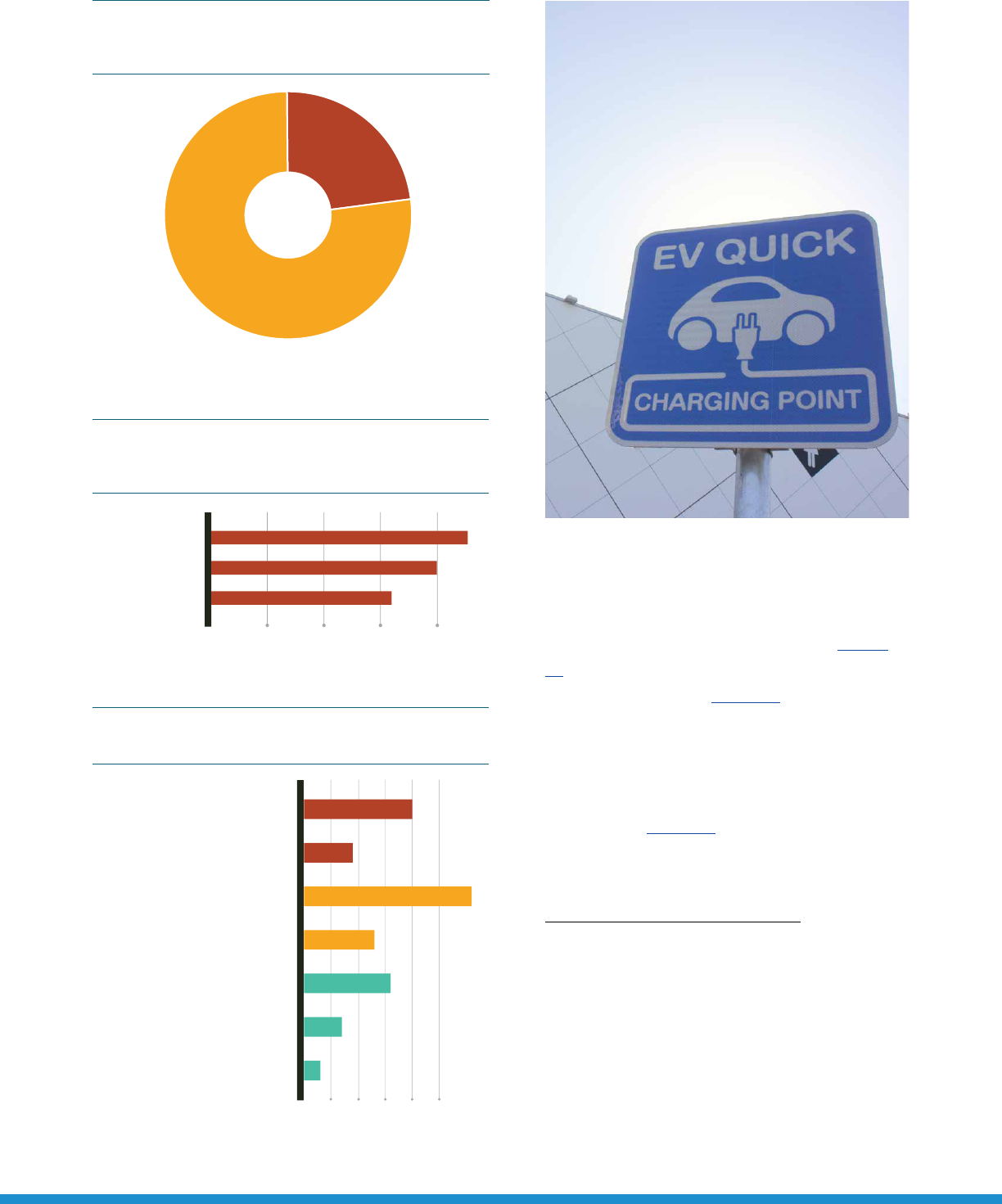
FUELS INSTITUTE | EVC | EV CONSUMER BEHAVIOR
37
In a survey conducted by McKinsey in the U.S.
between August 2018 and August 2019, 77% of
all respondents used mobile payment (Figure
40)
121
with 80% mobile payment users within
the ages of 35 and 50 (Figure 41).
122
The top EV
demographic of between the ages of 40 and
55 overlaps with this user base. A separate
2019 survey by Pymnts found that 73% of
respondents made mobile payments at least
once a week (Figure 42).
123
It may be safe to
assume that EV users are currently comfortable
with the available payment method choices.
124
121 Lindsay Anan, Deepa Mahajan, and Marie-Claude Nadeau, Are
Convenience and Rewards Leading to a Digital Flashpoint? Insights from
McKinsey’s 2019 Digital Payments Survey (San Francisco, CA: McKinsey and
Company, October 2019), https://www.mckinsey.com/~/media/mckinsey/
industries/financial%20services/banking%20blog/are%20convenience%20
and%20rewards%20leading%20to%20a%20digital%20flashpoint/
mckinsey-2019-digital-payments-survey.ashx.
122 Lindsay Anan et al., Are Convenience and Rewards Leading to a Digital
Flashpoint?
123 Jamie Gonzalez-Garcia and Kelly Dilworth, “Online and Mobile
Payment Statistics,” CreditCards.com, April 20, 2020, https://www.
creditcards.com/credit-card-news/online-payment-statistics-1276/.
124 Jamie Gonzalez-Garcia and Kelly Dilworth, “Online and Mobile
Payment Statistics”
United Sates
of America
Conventional
SUV
PHEV
BEV
Sedan
Trucks
Conventional Electric
New Car Buyers
Positive/negative
opinion about
electric vehicles
4000
91%
80%
64%
1.7%
99.0%
1.0%
99.7%
0.3%
99.7%
0.3%
99.6%
0.4%
99.6%
0.4%
99.4%
0.6%
99.7%
0.3%
99.2%
0.8%
99.6%
0.4%
21% 12% 10% 57%
20% 16% 4% 60%
31% 19% 10% 40%
39% 18% 9% 34%
37% 20% 10% 33%
18-34
35-50
51-69
2,677
5,461
10,560
11,242
29.2 32.8 35.8 39.4 41.4 39.9 41.2 41.3
2,677
FIGURE 40: PERCENTAGE OF RESPONDENTS
WHO HAVE USED MOBILE PAYMENT
(AUGUST 2018 TO AUGUST 2019)
FIGURE 41: PERCENTAGE BY AGE GROUP
OF RESPONDENTS WHO HAVE USED MOBILE
PAYMENT (AUGUST 2018 TO AUGUST 2019)
99.0%
99.7%
99.7%
99.6%
99.6%
99.4%
99.7%
99.2%
0.8%
99.6%
0.4%
20%
9%
31%
13%
16%
7%
3%
About once a day
Multiple times a day
Few times a week
Once a week
A few times a month
Once a month
Less than once a month
72%
50%
36%
United Sates
of America
Conventional
Positive/negative
opinion about
electric vehicles
Payment Authorization Type
99.0%
99.7%
99.7%
99.6%
99.6%
99.4%
99.7%
99.2%
99.6%
77%
Used mobile payment
23%
Did not use
mobile
payment
Source: Lindsay Anan et al., Are Convenience and Rewards Leading to a
Digital Flashpoint?
Source: Lindsay Anan et al., Are Convenience and Rewards Leading to a
Digital Flashpoint?
Source: Jamie Gonzalez-Garcia and Kelly Dilworth, “Online and Mobile
Payment Statistics”
FIGURE 42: PERCENTAGE OF U.S. CUSTOMERS
WHO MAKE MOBILE PAYMENTS (2019)

FUELS INSTITUTE | EVC | EV CONSUMER BEHAVIOR
38
WHAT DO CUSTOMERS DO AT FACILITIES WHILE
CHARGING?
DWELL TIME AT PUBLIC CHARGERS AND THE FEATURES
THAT COULD INFLUENCE THAT DWELL TIME
Potential EV consumers expect to spend between 30 minutes and
1 hour at a charging station.
125
The average fleet customer wants to
spend 36 minutes on average.
126
This is on par with the global average
of 31 and 36 minutes respectively (Figure 43).
127
A few trends emerge when analyzing the prevalent factors that
influence the dwell time at a public charger:
1)
EV drivers dwell 20 minutes longer than non-EV drivers: Kohls
found
that EV drivers, when provided on-premise car charging facility,
spend 20 minutes more in the store than non-EV drivers; Target
found EV drivers spend more than three times longer in the store.
128
2) Highway rest stops may have less incentive to purchase EV fast
chargers if not charging a fee: Business owners pay demand-based
electricity rates. Having a free on-premise DC charger and the
corresponding quick charge time translated to lesser dwell time and
thus lesser revenue but a high electricity bill for the business (see
following discussion on cost of installation for the business).
129
3) Shoppers are eager to leave when businesses charge drivers: When
charging is outsourced to third-party operators, charging becomes
five times the cost and thus shoppers become clock watchers and
are eager to leave as soon as they have enough power to do so.
130
4) When drivers are charged a session fee, the dwell time increases
by 20% on average: For Blink chargers, prior to the onset of charges,
an average session lasted 19.5 minutes. When a session fee was
levied, users tended to stay 20% longer, presumably to get more
value.
131
This billing structure is outdated, and customers are now
billed by the energy used.
125 Deloitte, 2020 Global Automotive Consumer Study: Tracking Key Changes in the Automotive Industry, 2019, available at https://www2.deloitte.com/us/en/pages/
manufacturing/articles/automotive-trends-millennials-consumer-study.html; Castrol, Accelerating the EVolution
126 Castrol, Accelerating the EVolution
127 Jim Burness, “Don’t Let Someone Else’s Profit Center Ruin Your Amenity,” National Car Charging, July 12, 2015, https://www.nationalcarcharging.com/blogs/
news/48795587-dont-let-someone-elses-profit-center-ruin-your-amenity; David Thill, “The Need For Charging Stations Is Clear, But Who Should Own Them Is Not,” Energy
News Network, February 15, 2019, https://energynews.us/2019/02/15/midwest/the-need-for-charging-stations-is-clear-but-who-should-own-them-is-not/; John Galloway
Smart and Shawn Douglas Salisbury, Plugged In: How Americans Charge Their Electric Vehicles
128 Jim Burness, “Don’t Let Someone Else’s Profit Center Ruin Your Amenity”; ChargePoint, “Leading Retailer Partners with ChargePoint to Attract and Retain Loyal
Customers,” news release, 2015, https://www.chargepoint.com/files/casestudies/cs-retail.pdf.
129 David Thill, “The Need for Charging Stations Is Clear, But Who Should Own Them Is Not”
130 Jim Burness, “Don’t Let Someone Else’s Profit Center Ruin Your Amenity”
131 John Galloway Smart and Shawn Douglas Salisbury, Plugged In: How Americans Charge Their Electric Vehicles
EV drivers spend 20 minutes more
than non-EV drivers in department
stores while charging
Highway rest stops may have
less incentive to purchase EV fast
chargers if not charging a fee
Shoppers are eager to leave
when businesses charge drivers
When drivers are charged a
session fee, dwell time
increases by 20% on average
CHARGER
AVAILABILITY
EV drivers spend 20 minutes
more than non-EV drivers
in department stores
while charging
Highway rest stops may
have less incentive to
purchase EV fast chargers
if not charging a fee
Shoppers are eager to
leave when businesses
charge drivers
When drivers are charged a
session fee, dwell time
increases by 20% on average
+20
+20
FIGURE 43: FACTORS AND
FEATURES THAT INFLUENCE
OVERALL EXPECTED DWELL TIME
AT PUBLIC CHARGERS
Source: Jim Burness, “Don’t Let Someone
Else’s Prot Center Ruin Your Amenity”

FUELS INSTITUTE | EVC | EV CONSUMER BEHAVIOR
39
Target, in its pilot program in collaboration with
ChargePoint, noted that with the introduction of EV
charging stations on-site, the average dwell time
was 72 minutes per session, which was 50 minutes
greater than the average dwell time of 22 minutes
without EV charging stations. Drivers also spent
approximately $1 per minute more on average at
the store, and the gross additional revenue was
estimated to be around $56,000 while the cost of
electricity for the charger was estimated to be $430
during the test period.
132
According to the Bureau of Labor Statistics, on
average, the time spent by customers making
consumer goods purchases was approximately
52 minutes (including transit time),
133
and Atlas
Public Policy’s study for the New York State Energy
Research and Development Authority found that
the average charging duration per session, at retail
132 ChargePoint, “Leading Retailer Partners with ChargePoint to Attract and Retain Loyal Customers”
133 Bureau of Labor and Statistics, U.S. Department of Labor, “American Time Use Survey — 2019 Results,” news release, June 25, 2020, https://www.bls.gov/news.release/
pdf/atus.pdf.
134 New York State Energy Research and Development Authority, Assessing the Business Case for Hosting Electric Vehicle Charging Stations in New York State, June 2019,
https://atlaspolicy.com/wp-content/uploads/2019/09/19-31-Business-Case-for-Hosting-Charging-Stations.pdf.
135 Melissa Fulenwider, “The Rising Influence of the ‘Slow Shopping Theory,’” Business Today Online Journal, February 14, 2016, https://journal.businesstoday.org/bt-
online/2017/the-rising-influence-of-the-slow-shopping-theory.
136 Margaret-Ann Leavitt, “Do EV Charging Stations Make for More Loyal Customers? Survey Says: They Certainly Do.,” National Car Charging (article published on
LinkedIn), June 17, 2019, https://www.linkedin.com/pulse/do-ev-charging-stations-make-more-loyal-customers-survey-leavitt/.
137 Brian W. Blaesser and Sorrell E. Negro, “Electric Vehicle Charging Stations — Retail Primer Update,” International Council of Shopping Centers, accessed October 23,
2020, available at https://www.icsc.com/newsletters/article/electric-vehicle-charging-stationsretail-primer-update.
locations in New York City, recorded an average of
2 hours and 36 minutes of dwell time despite an
average charging duration lasting only two hours
during the session.
134
Similarly, Origins, a cosmetics
retailer, while using a new business model that
included methods to increase customer dwell
time, found a 20%-40% boost in their revenue from
increased customer dwell time.
135
This data could
help support the conclusion that EV drivers tend to
spend more time at facilities and in turn spend more
money at the host.
In National Car Charging’s 2019 survey of PEV
drivers, 81% of respondents said that availability
of a charging station at businesses makes them
more loyal to the business.
136
EV charging stations
can boost business by building the retailer’s “green”
image and in turn attracting new customers while
building customer loyalty.
137
This data could help support
the conclusion that EV drivers
tend to spend more time at
facilities and in turn spend
more money at the host.
FUELS INSTITUTE | EVC | EV CONSUMER BEHAVIOR

FUELS INSTITUTE | EVC | EV CONSUMER BEHAVIOR
40
However, for the business, the cost of installing a
public Level 2 charging station could be between
$2,500 and $4,900, depending on the location
of installation, and a DCFC can cost between
$20,000 and $150,000 per station.
138
The average
cost of commercial electricity in 2019 was 10.68¢
per kWh.
139
Power draw on a Level 2 charger can
range from 7.7 to 16.8 kW,
140
and DCFC can range
between 50 kW to 350 kW. Table 1 summarizes the
expense per hour to host at various charging levels.
Amortization and depreciation are calculated with
an assumption of eight hours use every day of the
year. Salvage value is calculated at 20% of
overall cost.
138 Chris Nelder and Emily Rogers, “Reducing EV Charging Infrastructure Costs,” Rocky Mountain Institute, 2019, https://rmi.org/ev-charging-costs.
139 “Average Retail Price of Electricity, United States, Annual,” Electricity Data Browser
140 “Guide on Charging Your Electric Vehicle at Home,” ChargeHub, accessed October 23, 2020, https://chargehub.com/en/home-charging-guide-electric-vehicles.html.
141 “Convenience Stores,” “Food and Beverage Stores,” “Benchmarks,” The Retail Owners Institute, accessed October 27, 2020, https://retailowner.com/Benchmarks/Food-
and-Beverage-Stores/Convenience-Stores.
142 Brandon Logsdon, “A 2020 Outlook on Convenience Store Retail Trends,” Convenience Store News, January 29, 2020, https://csnews.com/2020-outlook-convenience-
store-retail-trends.
Given the charge time to get an EV to 80% at a fast
charger is around 20 to 30 minutes, the cost of
operation of a 150-kWh charger is approximately
$7-$12 (Table 1). Highway rest stop businesses are
typically convenience stores. The average pre-tax
profit margin of a convenience store is 3.2%,
141
which
means that the driver should spend at least $312
(assuming $10 operation cost) for the convenience
store to break even and far more for it make a profit.
To put this in perspective, the average driver spends
between $8 and $11 per visit.
142
TABLE 1: COST OF OPERATION PER HOUR AT VARIOUS CHARGING LEVELS (DIRECTIONAL ESTIMATES)
CHARGER
TYPE AND
ENERGY
CAPITAL
COST
Electricity cost
[A]
Amortization
of capital
[B]
Depreciation
[C]
First 5 years
[A]+[B]+[C]
Next 5 years
[A]+[C]
Level 2
(7.7 kW)
$2,500 $0.82 $0.17 $0.07 $1.06 $0.89
Level 2
(12.25 kW)
$3,700 $1.31 $0.25 $0.10 $1.66 $1.41
Level 2
(16.8 kW)
$4,900 $1.79 $0.34 $0.13 $2.27 $1.93
Level 3
(50 kW)
$27,900 $5.34 $1.92 $0.77 $8.02 $6.11
Level 3
(150 kW)
$87,800 $16.02 $6.03 $2.41 $24.46 $18.43
Level 3
(350 kW)
$139,000 $37.38 $9.55 $3.82 $50.75 $41.20
Note: Assumption of charging use for amortization and depreciation is eight hours per day every day through the year. Higher and lower costs are
assigned to higher and lower powered chargers and the mid-value is the average of the two in terms of power and cost. Costs and prices are directional
estimates. Cost of charger does notinclude “make-ready costs” (e.g., transformers) and service/maintenance costs. Costs assumed are average cost.
Level 2 12.25 kWh charger cost is estimated as average cost of Level 2 charger based on upper and lower limits.
CAPITAL COST
COST INCURRED BY HOST
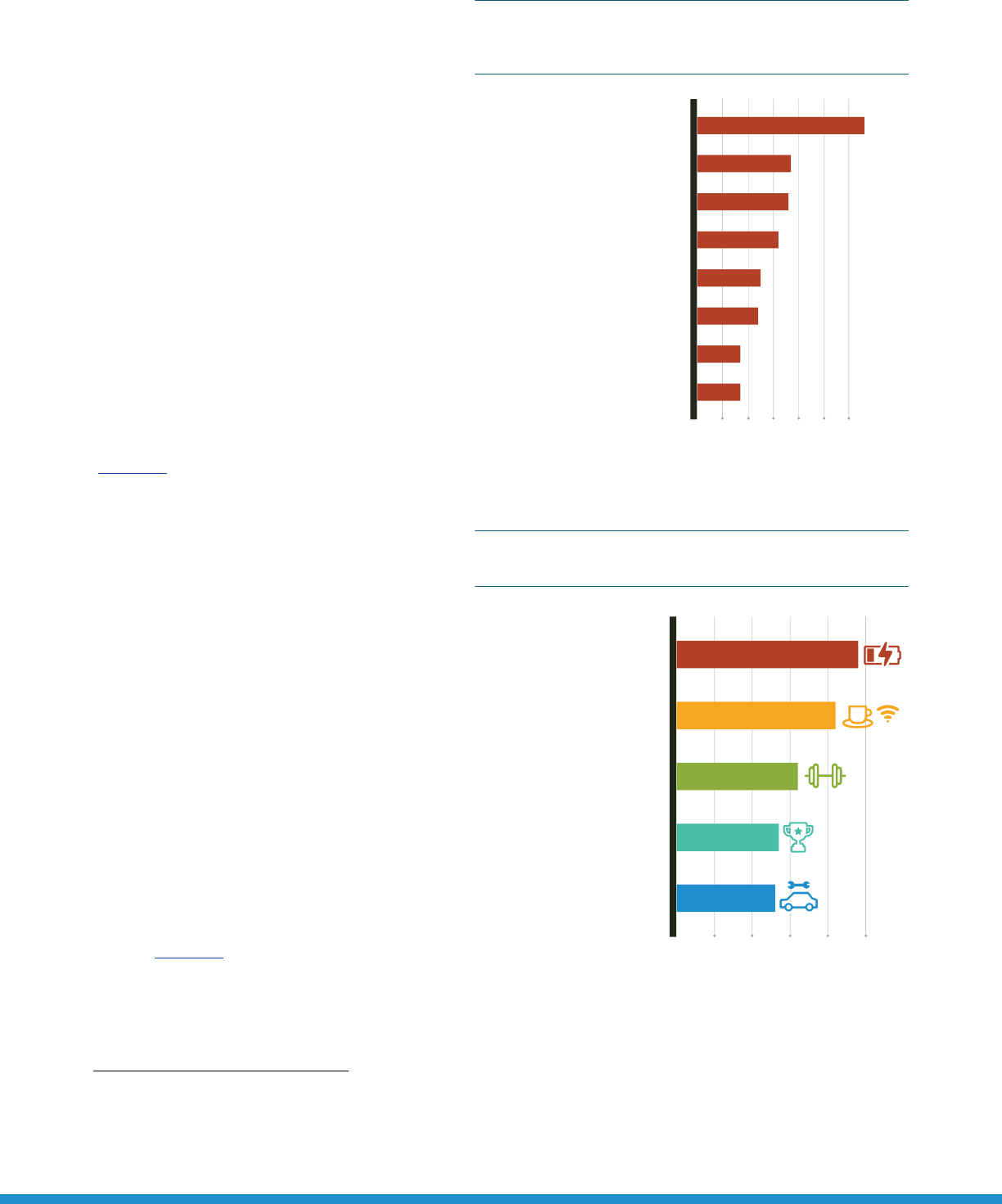
FUELS INSTITUTE | EVC | EV CONSUMER BEHAVIOR
41
FEATURES AND AMENITIES THAT ARE
MOST DESIRED BY EV DRIVERS, USED
DURING A CHARGING SESSION, AND
COULD INFLUENCE DRIVERS TO USE
CHARGING STATIONS FREQUENTLY
Consumer Reports and UCS found that 66% of
the participants in their 2019 survey viewed
grocery stores to be most convenient to have
a charging station.
143
The broad majority
seemed to support having a charging station
where they would spend longer periods of
time anyway. This was also the finding in the
study conducted by INL and the DOE in which
shopping malls, airports, commuter lots, and
downtown parking lots with easy access to
a variety of venues were amongst the most
used public charger locations. As shown in
(Figure 44),
144
INL and the DOE further found
that Level 2 charging sites at retail stores,
shopping malls, parking lots, and garages
demonstrated the potential to support seven
to 11 charges a day.
145
Volvo, in their 2018 study, found that among
the most desired charging station features,
the option to quickly charge a vehicle in half
the time topped the list. Having a coee shop
with Wi-Fi to increase productivity during the
downtime was the second preferred option,
and having a gym to work out was number
three on the list. An interesting observation
was that 27% of the respondents felt that
“gamification of rewards” would encourage
them to use the chargers more oen.
A quarter of the participants also felt the
need for maintenance services to be provided
on-site (Figure 45).
146
143 Union of Concerned Scientists and Consumer Reports, Electric Vehicle Survey Findings and Methodology
144 Union of Concerned Scientists and Consumer Reports, Electric Vehicle Survey Findings and Methodology
145 John Galloway Smart and Shawn Douglas Salisbury, Plugged In: How Americans Charge Their Electric Vehicles
146 Volvo Car USA, The State of Electric Vehicles in America
FIGURE 44: EV CHARGING LOCATIONS PERCEIVED TO
BE MOST CONVENIENT BY POTENTIAL EV CUSTOMERS
(2019)
FIGURE 45: FEATURES MOST DESIRED AT EXISTING
EV CHARGING LOCATIONS (2019)
99.0%
99.7%
99.7%
99.6%
99.6%
99.4%
99.7%
99.2%
0.8%
99.6%
0.4%
66%
37%
36%
32%
25%
24%
17%
17%
20%
9%
31%
13%
16%
7%
3%
Grocery stores
Restaurants
Shopping malls
Recretion areas (e.g., parks)
Major warehouse clubs
Entertainment locations
Pharmacy
Others
72%
50%
36%
United Sates
of America
Conventional
SUV
PHEV
BEV
Sedan
Trucks
Conventional Electric
New Car Buyers
Positive/negative
opinion about
electric vehicles
4000
48%
42%
32%
27%
26%
1.7%
99.0%
1.0%
99.7%
0.3%
99.7%
0.3%
99.6%
0.4%
99.6%
0.4%
99.4%
0.6%
99.7%
0.3%
99.2%
0.8%
99.6%
0.4%
21% 12% 10% 57%
20% 16% 4% 60%
31% 19% 10% 40%
39% 18% 9% 34%
37% 20% 10% 33%
Quick charge option
to reduce charge time by half
Quick charge option
to reduce charge time by half
Coffee shop or café
with Wi-Fi
Gym
or fitness facility
Gamification of rewards
to incentivize drivers to return
Maintenance
vehicle maintenance services
Coffee shop or café
with Wi-Fi
Gym
or fitness facility
Maintenance
services for vehicles
Gamification of rewards
to incentivize drivers to return
2,677
5,461
10,560
11,242
29.2 32.8 35.8 39.4 41.4 39.9 41.2 41.3
2,677
Note: Participants chose more than one option
Source: Volvo Car USA, The State of Electric Vehicles in America
Source: Union of Concerned Scientists and Consumer Reports, Electric Vehicle
Survey Findings and Methodology
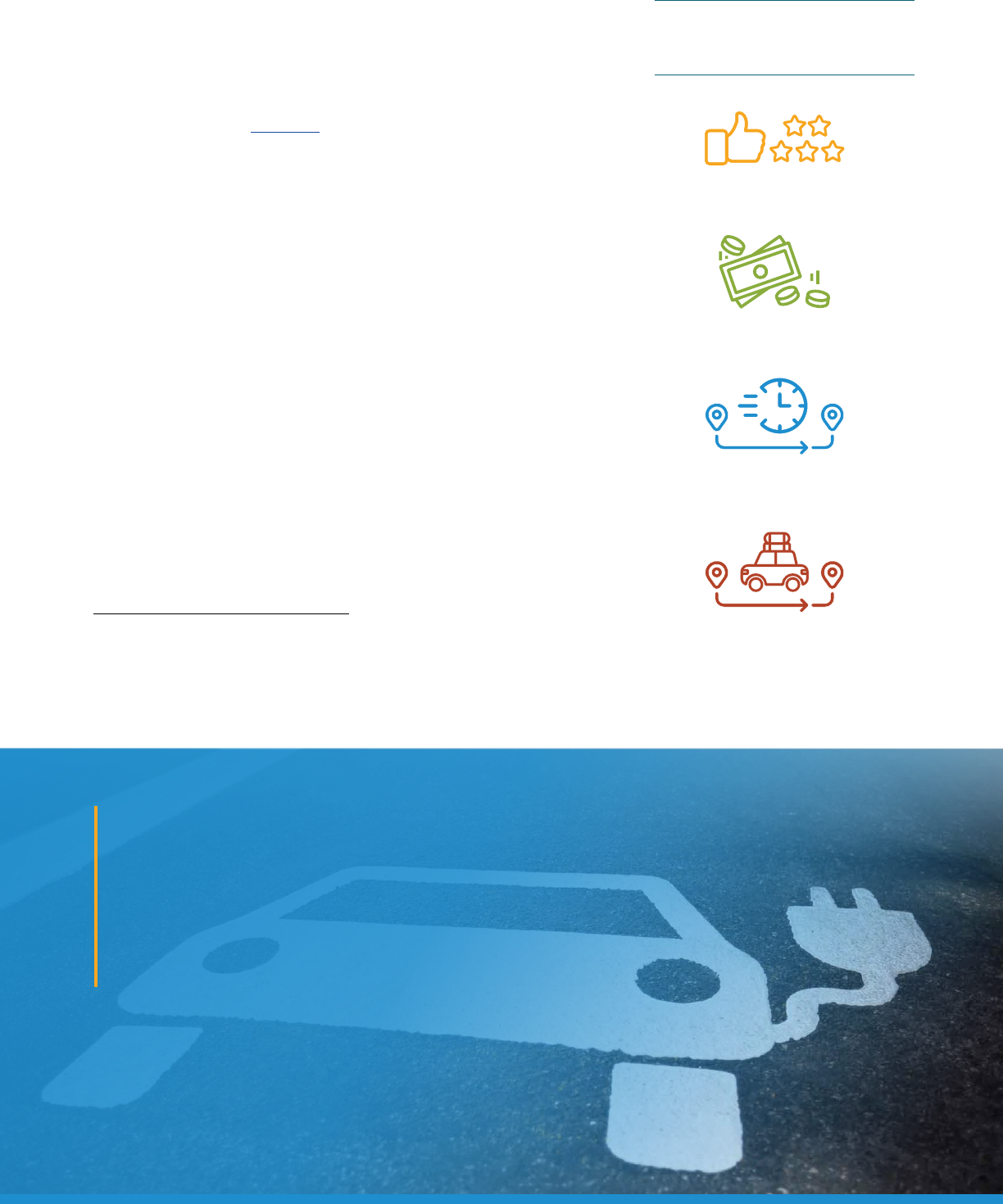
FUELS INSTITUTE | EVC | EV CONSUMER BEHAVIOR
42
EV drivers spend 20 minutes
more than non-EV drivers
in department stores
while charging
Highway rest stops may
have less incentive to
purchase EV fast chargers
if not charging a fee
Shoppers are eager to
leave when businesses
charge drivers
When drivers are charged a
session fee, dwell time
increases by 20% on average
+20
NON-
AVAILABILITY
OF AT-HOME
CHARGER
RUNNING
OUT OF
BATTERY
RANGE
ACCESSIBILITY VALUE CONVENIENCE FORGETTING
TO RECHARGE
AT HOME
DEPENDABILITY
COST OF USE
CONVENIENCE
NEED FOR TRAVEL
AFFORDABILITY TIME SAVING
CHARGER
AVAILABILITY
FAMILIARITY OPTIONS
Lower purchase
price
Long range
between charges
Ability to charge
at home
Renting a plug-in
vehicle
Plug-in crossovers/
SUV/pickup
FEATURES AND AMENITIES THAT YIELD THE GREATEST
INFLUENCE OVER AN EV DRIVER’S DECISION
REGARDING WHERE TO CHARGE
A few key factors that influence a driver’s decision in choosing
where to charge are (Figure 46):
1) Dependability: Some networks appear to be more dependable
than others. Chargers at newer stations have been found to be
out of service.
147
2) Convenience: Drivers are less likely to plug in at work if they
have to pay to charge or if they have to move the vehicle aer
charging (and the rule was enforced).
148
3) Cost of use: Most Blink public units started charging a fee aer
September 2012 while ChargePoint units were free through the
end of the DOE’s EV Project. Usage of ChargePoint units had
been increasing at a faster rate than Blink.
149
4) Need for travel: Drivers who plugged in away from home
generally traveled more, logging 72% more daily miles on
electricity compared to drivers who didn’t charge at home. Most
used chargers that tended to be closer to highway exits.
150
147 Je Plungis, “How the Electric Car Charging Network Is Expanding”
148 Eric Schmidt, “The Key to Increasing EV Adoption Is Hidden in EV Driving and Charging Data”
149 Eric Schmidt, “The Key to Increasing EV Adoption Is Hidden in EV Driving and Charging Data”
150 Eric Schmidt, “The Key to Increasing EV Adoption Is Hidden in EV Driving and Charging Data”
FIGURE 46: KEY FEATURES AND
AMENITIES THAT INFLUENCE EV
DRIVERS’ CHOICE OF CHARGER
Consumer Reports and
UCS found that 66% of the
participants in their 2019
survey viewed grocery stores
to be most convenient to
have a charging station.
42
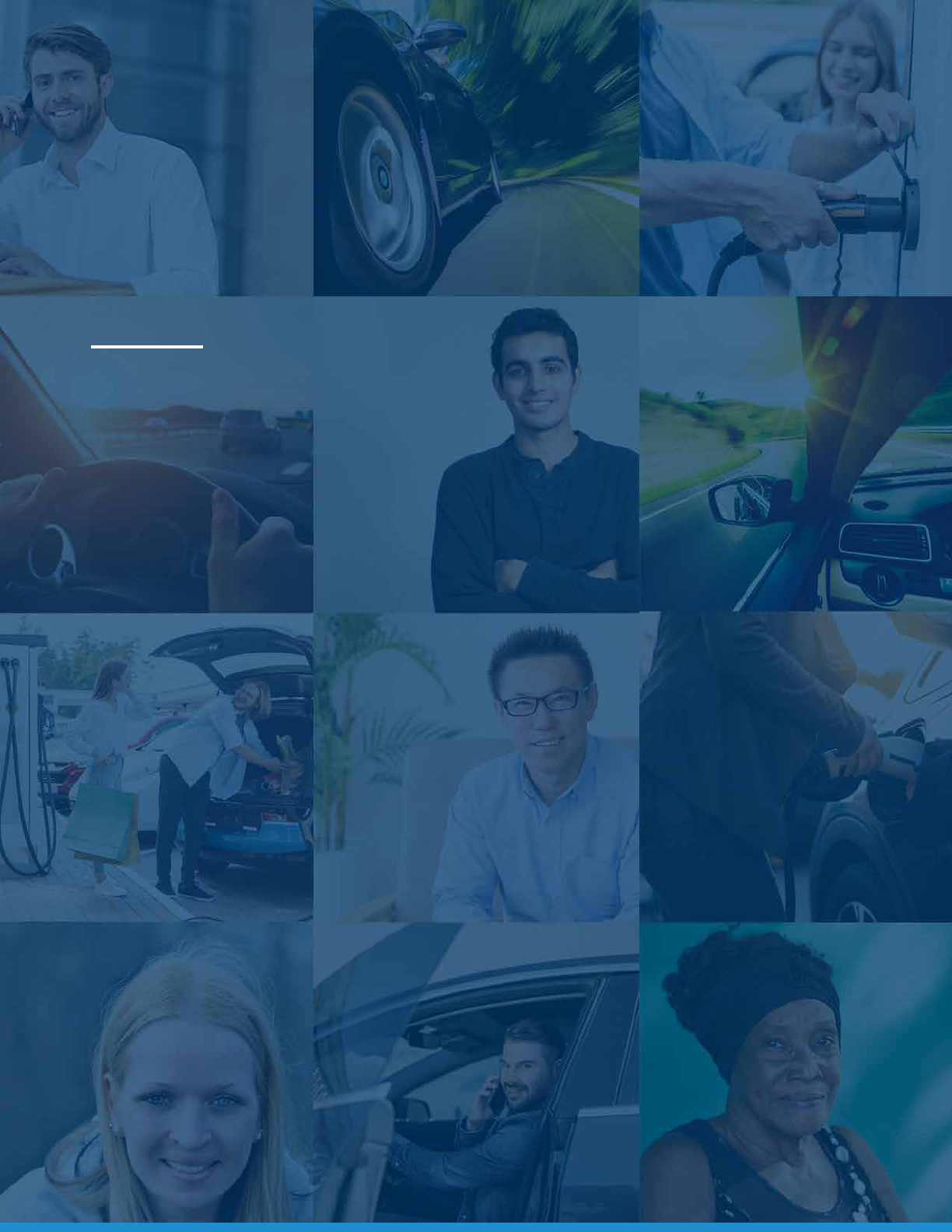
FUELS INSTITUTE | EVC | EV CONSUMER BEHAVIOR
43
FUELS INSTITUTE | EVC | EV CONSUMER BEHAVIOR
PERSONA FINDINGS
These five personas exemplify predicted
individual preferences. They were chosen to
represent various demographics, their use
cases, and perceptions of EV ownership and
charging. More details, including their daily
habits, are outlined in the following pages.

FUELS INSTITUTE | EVC | EV CONSUMER BEHAVIOR
44
FUELS INSTITUTE | EVC | EV CONSUMER BEHAVIOR
Aluent Middle-Aged White Male
With BEV As Secondary Vehicle Living
in the California Bay Area With Access
to At-Home Charging
Michael is an aluent middle-aged white man
who owns more than one vehicle. He fits the most
common EV owner demographic and exemplifies
their typical EV-related behavior. He lives in the ZEV-
populous Bay Area region of California, considers
driving a Tesla to be a status symbol, and likes being
associated with cutting-edge technology.
Michael generally charges at home and uses free
charging at his workplace parking lot. He uses public
chargers when they are free and when the charge
time fits his schedule. Michael only recharges with
a DCFC when unavoidable and prefers the Tesla
network since the ecosystem is integrated within
the vehicle and the smartphone app. He also limits
himself to using Level 2 chargers because of the
potential battery degradation from frequently using
a DCFC. This could be another aspect to consider
when designing EV charging infrastructure — this is
in line with the current projection of 96% of public
chargers being Level 2 (Figure 25). Michael does not
choose a particular gym based on the availability of
charger, exemplifying that people may not switch
loyalty to a business solely based on the availability
of a public charger.
For long trips, Michael chooses to fly as opposed
to road-trip, or he and his family use the gasoline-
powered SUV. Michael might consider an electric
SUV if the DCFC network along highways was denser
and the charging time was much lower.
• 37-year-old male
• Owns Tesla Model 3, second
car ($60,000); first car is a
premium SUV
• Lives in the Bay Area,
California
• Married, two kids (below age 6)
• Director at a technology
company
• $400,000 household income
• Owns a house with garage
and usually charges at home
at night
• One-and-a-half hour commute
to and from work everyday
• Occasional road travel out
of the city
• Workplace has free charging
• Nanny comes in on the
weekend for four hours once
a month so that Michael and
his wife can step out for dinner
and shopping using the Tesla
PERSONA DESCRIPTION
OVERVIEW
PERSONA FINDINGS
Michael

FUELS INSTITUTE | EVC | EV CONSUMER BEHAVIOR
45
TYPE OF CUSTOMER
• Considers driving a Tesla to
be a status symbol
• Is undergoing a mid-life crisis
and taking time for self-care
and family care
• Values the green credential
that comes with owning an EV
• Likes being on the cutting-
edge of technology
• Identifies as an early tech
adopter
• Likes “cool” things
• Identifies as a beta tester of
new tech
• Prefers flying to road travel for
long trips
RECHARGE HABITS
• Recharges at home every or
every other night
• Recharges at public parking
that provides free parking and
free electricity
• Plugs in when parking is closer
to the building
• Recharges primarily at home
and work (free charging) and
at hotels when on trips
• Does not wait until the battery
is nearly empty and always
keeps it topped up
• Would use a public charger
if there happens to be a
saturation in the residential
energy market or if urban
housing has the facility
to plug in
CHOOSING A PARTICULAR
CHARGING FACILITY
• Only recharges using a
Level 2 DCFC when almost
empty and unavoidable
• Would prefer to charge within
the Tesla network that is
integrated in the vehicle’s
interface
• Charges for free at the high-
end shopping mall or an
upscale restaurant when he
goes out with his wife on a
weekend (monthly)
INTERACTION WITH A
PUBLIC CHARGING STATION
• Primarily recharges at home
or work and has limited
opportunity to use public
chargers
• Would plug in if free of charge
and if he plans to spend some
time at that location
• Prefers using the Tesla
Supercharger network if
necessary but limits himself
to Level 2
TIME SPENT AT A PUBLIC
CHARGING STATION
• Would prefer to have a
charging station at a gym
or somewhere he is likely to
spend time
• Would not choose a gym
because of the availability of a
charger, but having one would
be good
• Would pay to charge at a
public charger if it means
he can park closer in a
crowded lot
• Would use a public charger
if there aren’t other parking
lots nearby
• Uses the gasoline SUV for road
trips with family
TRAITS
FUELS INSTITUTE | EVC | EV CONSUMER BEHAVIOR
PERSONA FINDINGS: MICHAEL

FUELS INSTITUTE | EVC | EV CONSUMER BEHAVIOR
46
FUELS INSTITUTE | EVC | EV CONSUMER BEHAVIOR
Aluent, Middle-Aged Asian American
Male With BEV As Secondary Vehicle
Living With At-Home Charger Who
Frequents a Metropolitan City
Shou represents a slightly dierent demographic
where the vehicle is oen driven locally and
occasionally to a metropolitan city. Shou, like
Michael, primarily charges his car at home, but since
he runs a business from home, his travel needs are
lighter than Michael’s.
Shou enjoys having an environmentally conscious
image and appreciates the hassle-free ownership
experience involved in driving an EV. Switching to
an EV has not greatly impacted his travel habits
because most of his trips are running errands around
town. He prefers to take the bus or train instead of
driving whenever convenient. When he does travel
longer distances, he plans his trips around chargers
and chooses to stay at hotels with a Level 2 charger
to charge overnight. Shou’s example of charging
at the hotel where he stays overnight is in line with
the observations that 1) the most used chargers are
those at locations where people tend to park for long
periods of time and 2) customers are attracted to
businesses that provide an on-premise charger (see
“Dwell Time at Public Chargers and the Features That
Could Influence That Dwell Time” for an analysis of
the profitability of this use case).
Shou’s charging behavior is influenced by factors
discussed in “EV Drivers’ Preferred Recharge
Location” although the majority of his charging is
done at home, he tends to plug in when a charger
is available, free, and convenient and if it helps
secure a good parking spot. Shou’s EV purchase
included a ChargePoint card and he has received
good customer service from the charge company, so
he is loyal to that particular charger brand. Shou is
also loyal to ChargePoint because he doesn’t want
to sign up for several charging apps. However, he
uses the PlugShare app to scout for free chargers. He
would prefer to be in a coee shop with free Wi-Fi to
increase his productivity during the downtime while
charging, but during the current pandemic, he sits in
the car.
OVERVIEW
PERSONA FINDINGS
Shou

FUELS INSTITUTE | EVC | EV CONSUMER BEHAVIOR
47
• 49-year-old male
• Owns Chevy Bolt as a second
car; the first car is a minivan
(primarily driven by his wife)
• Lives in New Jersey within the
New York City metro area
• Married, two kids (in college)
• Owns a home-based
financial firm
• $200,000 household income
• Owns a house with garage and
usually charges at home
• Drives the Bolt in the evenings
and over the weekend
• Frequently travels to
Manhattan
• Prefers public transport
when convenient
PERSONA DESCRIPTION
TYPE OF CUSTOMER
• Grown children no longer live
at home, so he downsized the
second car
• Environment-conscious image
• Appreciates the lower fuel cost
with an EV
• Enjoys hassle-free ownership
and prefers a low-maintenance
vehicle
• Does not drive enough to
justify having two cars and
is considering selling the
minivan
• Travel has not changed since
switching to an EV — primarily
uses it to travel around town
and to the train station
RECHARGE HABITS
• Mostly recharges at home
unless traveling
• Plans trips around chargers,
and for work-related road trips,
prefers to stay overnight in
hotels oering Level 2 charging
• Would make long trips if the
one-way distance is well within
the car’s range
• Prefers to use public chargers
if charging is free and he has
the time; otherwise he will
only use a public charger if the
car is running out of range
• Will charge while grocery
shopping if it’s free and he can
get a good parking spot
• Very low tolerance to wait for a
public charger because he can
charge at home
CHOOSING A PARTICULAR
CHARGING FACILITY
• Only recharges at Level 2
charger because DCFC on
the Bolt is an optional extra
($700-$1,000)
• Prefers ChargePoint since the
vehicle came with their charge
card and they have good
customer service
• Finds it a hassle to sign up
for multiple apps
• Checks for free chargers
on PlugShare
INTERACTION WITH A
PUBLIC CHARGING STATION
• Prefers free charging unless
out of range
• Finds signing up for new
apps annoying
• Would prefer to pay through
the app
TIME SPENT AT A PUBLIC
CHARGING STATION
• Tries to get work done when
waiting — prefers a café with
Wi-Fi and outlets to plug in
• Needs a place to sit down and
eat, a clean bathroom, and a
convenience store
• Chooses to stay in the car
while charging during the
pandemic
• Would shop at a grocery store
or a gas station’s convenience
store if there were available
chargers
TRAITS
FUELS INSTITUTE | EVC | EV CONSUMER BEHAVIOR
PERSONA FINDINGS: SHOU

FUELS INSTITUTE | EVC | EV CONSUMER BEHAVIOR
48
Middle-Class Young Male of Indian Heritage
With BEV As Primary Vehicle for a 20-Mile
Commute Who Lives in an Apartment
Building with Shared Chargers
Raj is a little shy of the $100,000 annual household
income bracket that makes up the dominant
demographic. Being younger than the average
age group of today’s EV drivers and living in an
apartment without access to a private charger makes
Raj stand out among EV buyers. However, living in a
major city with a 20-mile commute in stop-and-go
traic makes him an ideal candidate to own an EV.
Raj typically charges at his workplace every day
because a charger isn’t always available at home.
He plans his trips around chargers when traveling
between cities. Raj, like Michael and Shou, enjoys
the green image that comes with driving an EV.
Although Raj would switch grocery stores for free
charging, he would not consider switching his
tennis club for another one with a free charger.
This accentuates the possibility that while a free
charger can promote business at some places, at
others it would only remain a nicety. This could,
however, become a necessity as the EV adoption
rate increases in the future. Raj is well educated and
mindful of the fact that frequent use of DCFC could
accelerate battery wear. He ensures his recharging
habits maintain the battery’s optimum charge level
to extend battery life. This behavior could become
commonplace amongst the more enthusiastic
owners and eventually could pressure the
infrastructure market to address this requirement
by incorporating a means to monitor and control
charging level and speed. Raj is, in general, unwilling
to pay for charging. When unavoidable, he expects
payments to be seamless.
• 28-year-old male
• Owns Tesla Model 3
• Lives in Chicago, Illinois
• Single
• Electrical/electronics engineer
• $90,000 household income
• Lives in a rental apartment
complex with two
charging plugs
• Commutes 20 miles daily
• Occasionally road-trips
with friends
• Relatives live in Ann Arbor,
Michigan, and he visits once
every three months; there is
no charger at his destination
• Plays tennis three times a
week
PERSONA DESCRIPTION
OVERVIEW
PERSONA FINDINGS
Raj
FUELS INSTITUTE | EVC | EV CONSUMER BEHAVIOR

FUELS INSTITUTE | EVC | EV CONSUMER BEHAVIOR
49
TYPE OF CUSTOMER
• Charges at work every day
• Plans road trips based on
Superchargers
• On trips to Ann Arbor, charges
for 20 to 30 minutes in both
directions
• Supports the “green” theme
• Appreciates getting “fuel” for
free
• Enjoys status symbol of driving
a Tesla
RECHARGE HABITS
• Mostly charges at work
because the charger at home is
not always available
• Would plug in whenever
possible but is mindful to not
charge above the “safe” range
of the battery
• A battery level of less than
35% is his trigger point to plug
in, and he calculates the way
back to his regular locations or
plugs in as soon as he can
• Plugs in even at a Level 1
charger for free “fuel”
• Would switch grocery stores
for a priority spot and free
charging
• Would not switch tennis clubs
for a free charger
• Plugs in when there is an EV-
only parking structure that’s
closer to where he wants to be
CHOOSING A PARTICULAR
CHARGING FACILITY
• On the highway, would prefer
a DCFC but wouldn’t complain
about having a Level 2
elsewhere
• Around town, does not
plug in to a DCFC unless he
must because of battery
degradation
• Safety of the vehicle is more
important than the identity of
the charger or the host
• Prefers to use the car’s
interface, but uses EVgo and
ChargePoint when not using
Tesla EVSE
INTERACTION WITH A
PUBLIC CHARGING STATION
• Reluctant to pay for charging,
which should be as seamless
as possible if he must pay
• Would pay a premium to use
renewable energy
TIME SPENT AT A PUBLIC
CHARGING STATION
• Aims to spend 20 to 30 minutes
at a charger and call friends
and family when charging
• Needs facilities similar to those
at a conventional gas station —
bathroom, coee, and snacks
• Would like nearby services
such as free Wi-Fi (streaming
level), charging ports, gym,
and games (similar to Dave
and Busters)
• Would extend his stay at a
public charger if there were a
treadmill, shower, and food
TRAITS
FUELS INSTITUTE | EVC | EV CONSUMER BEHAVIOR
PERSONA FINDINGS: RAJ

FUELS INSTITUTE | EVC | EV CONSUMER BEHAVIOR
50
FUELS INSTITUTE | EVC | EV CONSUMER BEHAVIOR
Retired Environmentally Conscious
African American Female on a Fixed
Income With a BEV As a Primary Vehicle
With an At-Home Charger
Millicent, who is on a fixed income and has
predictable traveling patterns, prefers to take the
train when going downtown but travels in her EV
to promote environmentally conscious behavior
among her circle of influence. She considers
her EV to be more of a political statement than a
transportation choice.
Millicent has limited daily traveling needs and
charges mostly at home on a Level 1 charger. She
uses public chargers to promote awareness of EVs.
She enjoys conversations with like-minded people
whom she oen meets at these public chargers.
Although she does not need to use a public charger
very oen, she expects to see a lot more chargers in
her community for the people who would need to
use them. She is not very tech-savvy and does not
use apps to find chargers. She only uses chargers
that she’s seen or are at places that she frequently
visits. She treats her car like a gasoline-engine
powered car, which reflects the anticipation that as
EV adoption becomes more widespread, EVs will be
treated like today’s conventional vehicles. Facilities
and amenities oered at public chargers do not
aect Millicent’s frequency or duration of usage of
those public chargers.
• 68-year-old female
• Drives used Chevy Bolt
• Lives in Orlando, Florida
• Living alone; her adult children
live in the Chicago metro area
• Retired elementary school
teacher
• $60,000 fixed pension
• Owns a house with garage
• Leaves house only a few times
a week
• Takes the train when traveling
downtown
• Involved in both the civil rights
and environmental justice
movements in her youth and
wants to make purchasing
choices that are aligned with
her values
PERSONA DESCRIPTION
OVERVIEW
PERSONA FINDINGS
Millicent

FUELS INSTITUTE | EVC | EV CONSUMER BEHAVIOR
51
TYPE OF CUSTOMER
• Involved with community and
church and volunteers at the
local library
• Environmentally conscious
• Owning an EV is more of a
political than a transportation
choice; she cares about how air
pollution is disproportionally
aecting her community and
feels that she is making a
dierence through her choice
of transportation
• Only person in her social
circle to own an EV
• Travel has not changed
since switching to an EV
and remains minimal
RECHARGE HABITS
• Mostly charges at home (Level
1 charger)
• Uses free public chargers at
the library and around town
to bring awareness to
onlookers; identifies as
an advocate for EVs
• Plugs in at readily available
chargers for conversations
with like-minded people
• Is proud of not using a gas
station in years
• Would like to see more
chargers in the community
so that they are accessible to
people who drive more than
she does
CHOOSING A PARTICULAR
CHARGING FACILITY
• Does not know the dierence
between Level 1, Level 2, and
DCFC and doesn’t see a need
to know
• Does not use an app to find
chargers but plugs in when
she finds one or already knows
where one is; not tech-savvy
and treats EV similar to a
gas car
INTERACTION WITH A
PUBLIC CHARGING STATION
• Is not willing to pay for
charging
• If needed, she would prefer
paying with a credit card rather
than an app due to privacy
sensitivity
TIME SPENT AT A PUBLIC
CHARGING STATION
• Charging is not a top priority
and plugs in if the charger is
free and available at a location
she is visiting anyway
• Facilities and amenities at
public chargers do not aect
her perception
TRAITS
FUELS INSTITUTE | EVC | EV CONSUMER BEHAVIOR
PERSONA FINDINGS: MILLICENT

FUELS INSTITUTE | EVC | EV CONSUMER BEHAVIOR
52
FUELS INSTITUTE | EVC | EV CONSUMER BEHAVIOR
White Businesswoman Who
Drives a Work Truck and Could
Potentially Buy an Electric Truck
Amy is an example of what a prospective EV owner
would expect and need beyond the current EV
infrastructure and systems. Current EV drivers tend
to adapt to the infrastructure and systems that
are available to them, and their expectations are
constrained by the current situation. Amy, who uses
a work truck as her primary vehicle and is a potential
EV buyer, demonstrates how the market can prepare
for the requirements of a commercial small
business’ EV.
Amy currently drives a Ford F-150. She views
having an electric pickup truck as being a potential
advertisement for industry of solar panel installation.
Unlike bigger commercial establishments that tend
to charge exclusively at their work bases, Amy would
charge her truck at home and at public chargers as
needed. Amy’s requirement is for the battery range
to last the entire workday, which appears plausible
given the current trajectory of EV battery range.
She expects the truck to be reliable and cannot
change her driving patterns based on the availability
of chargers. She expects to be part of the EV360
program in Austin because the program’s fixed low
monthly subscription costs would make her fuel
expenses not only predictable but also significantly
lower than her current fuel cost. This in turn would
help reduce the overall cost of EV ownership, a
significant factor in Amy’s EV adoption decision.
Austin’s EV360 program could act as a role model for
other cities and states in encouraging EV adoption.
Amy would plan to charge at home at the end of the
workday, but if she needed to charge up before that,
she would need to use a DCFC every time because
any downtime during the day could result in lesser
revenue earned. This would be in spite of fully
understanding the implications of frequent use of
DCFCs. She would prefer to have Wi-Fi at charging
stations to improve productivity but would not want
to wait any longer than she has to for charging
the vehicle.
OVERVIEW
PERSONA FINDINGS
Amy

FUELS INSTITUTE | EVC | EV CONSUMER BEHAVIOR
53
• 43-year-old female
• Drives a Ford F-150
• Lives in Austin, Texas
• Single
• General electrician/solar
installer
• $150,000 business income
• Open to buying an EV, but
nonavailability and her
lifestyle don’t currently
support EV ownership
• Views EV ownership as an
advertising element in line
with her business
• Needs ability to plug in and
use tools on-site
• Dreams of having a mini
workshop in the truck
bed, avoiding the need to
travel back and forth to her
workshop
PERSONA DESCRIPTION
FUELS INSTITUTE | EVC | EV CONSUMER BEHAVIOR
PERSONA FINDINGS: AMY
TYPE OF CUSTOMER
• Views EV to be a potential
advertisement element to her
business
• Would need battery range to
last the entire workday
• Is extremely range anxious
because the truck is her
livelihood and she depends on
100% uptime
• Travel habits are not expected
to change in order to
accommodate charging habits
when owning an EV
• Goes on road trips with friends
RECHARGE HABITS
• Would charge overnight at
home (Austin’s EV360 program
promotes free home charging)
• During the workday, would not
have much downtime to use a
public charger unless running
out of range, and would always
need a DCFC
• Would plug in while running
errands as an advertisement
for her business and would pay
a reasonable cost to plug in
even if she doesn’t need to
• Fuel-cost conscious and would
make use of subsidized/free
home charging
CHOOSING A PARTICULAR
CHARGING FACILITY
• Would only plug in if it’s a long
workday and she is running
out of charge
• Would prefer a DCFC and
would be willing to pay a
reasonable premium to avoid
downtime
• Would prefer to use the
network for the card supplied
with the truck upon purchase,
but would switch providers if
the network is unreliable
• Would prefer using a network
with which she has an existing
relationship, such as the
company that installs her
home charger
INTERACTION WITH A
PUBLIC CHARGING STATION
• Would prefer being charged
per kWh
• Prefers to use a seamless
system to pay, such as charge
cards, so that her receipts stay
in one place for easy business
expensing
TIME SPENT AT A PUBLIC
CHARGING STATION
• Would prefer to be at a station
that oers Wi-Fi and outlets to
catch up on work
• Would like a drive-in with Wi-Fi
while charging
• Would prefer not to wait any
longer than she must for
charging
TRAITS

FUELS INSTITUTE | EVC | EV CONSUMER BEHAVIOR
54
CONCLUSIONS
This report discusses the behavior of
today’s EV drivers and their evolution
over the past 10 years and into the next
10 years. Although best eorts were
made to incorporate the latest and
most accurate data in this study, the
EV landscape has been changing
rapidly and is continuing to do so.
Battery range has tripled since 2010,
vehicle nameplates have increased
from three to more than 20, and
Level 2 charging locations have
grown from approximately 1,000
to more than 70,000. This rapid
development renders conducted
research outdated very quickly.
Technology has evolved, and the mindset of
consumers has evolved to now view their EVs as a
gadget that is not very dierent from their cellphone.
The vast majority however are still concerned
about the limitation of battery range, the need to
plan ahead to charge their vehicle (unlike gasoline
vehicles), and that battery degradation over time
can limit their mobility. There is yet another group
of the population that is not served by the current
lineup of vehicles: People who want to buy a pickup
truck or a minivan have very limited electric
options, if any.
Travel habits of EV drivers today perhaps hide the
deficiencies in the charging infrastructure amenities
since they choose to purchase an EV knowing
the infrastructure in place. This will change once
EVs become more aordable, as more choice is
available, as the charging infrastructure grows to
instill confidence in range-anxious minds, and, most
importantly, as the average driver’s mindset changes
to understand and embrace EV technology.
Understanding the mindset of today’s drivers by
means of studies helps make better, more informed
choices in planning out infrastructure requirement
for the future. Although many factors have a
predictable trend, such as falling battery prices,
improved range, and denser charging infrastructure,
nuanced factors such as comfort of available
infrastructure, features, and amenities that could
influence a driver’s decision to spend time at a
charging station, recharging habits, and selection of
chargers would continually be applicable for buyers
who are not considering an EV purchase today but
are likely to do so over the next few years.
Targeted surveys and interviews to capture near-
term, mid-term, and long-term EV buyers’ opinions
with regards to the questions outlined in this report
are necessary to ensure a robust view of how the
charging infrastructure and surrounding amenities
should involve. Additionally, direct feedback from
EV manufacturers, charging station providers, fleet
managers, and business entities such as grocery
stores, shopping malls, highway stops, restaurant
owners, park-and-rides, and other would be
necessary to understand their plans to evolve
the EV charging and consumer experience
ecosystem. These items should be addressed in
subsequent research.

55
APPENDIX

FUELS INSTITUTE | EVC | EV CONSUMER BEHAVIOR
56
BEV battery electric vehicle
DCFC direct current fast charger/charging
DOE Department of Energy
EV electric vehicle
EVSE electric vehicle supply equipment
ICE internal combustion engine
INL Idaho National Laboratory
kWh kilowatt-hour
NREL National Renewable Energy Laboratory
OEM original equipment manufacturer
PEV plug-in electric vehicle
PHEV plug-in hybrid electric vehicle
RFID radio-frequency identification
SUV sport utility vehicle
TCO total cost of ownership
UCS Union of Concerned Scientists
ZEV zero-emission vehicle
Abbreviations

FUELS INSTITUTE | EVC | EV CONSUMER BEHAVIOR
57
“2019: ACS 1-Year Estimates Detailed Tables” (Table ID C02003, Universe: Total Population, Survey/Program: American
Community Survey), United States Census Bureau, accessed October 29, 2020, available at https://data.census.gov/cedsci/
table?q=race&g=0100000US.04000.001&tid=ACSDT1Y2019.C02003&moe=false&tp=true&hidePreview=true.
“Alternative Fueling Station Locator,” Alternate Fuels Data Center, Oice of Energy Eiciency and Renewable Energy, U.S. Department
of Energy, accessed October 29, 2020, https://afdc.energy.gov/stations/#/analyze.
American Public Power Association, A Public Power Guide to Understanding the U.S. Plug-in Electric Vehicle Market, 2017, available at
https://www.amea.com/wp-content/uploads/2018/08/understanding_the_us_plug-in_electric_vehicle_market_2017_digital_
final.pdf.
Annie Palmer, “Amazon Debuts Electric Delivery Vans Created with Rivian,” CNBC, October 8, 2020, updated October 8, 2020, https://
www.cnbc.com/2020/10/08/amazon-new-electric-delivery-vans-created-with-rivian-unveiled.html.
“Average Annual Miles per Driver by Age Group,” Federal Highway Administration, U.S. Department of Transportation, March 29, 2018,
accessed October 15, 2020, available at https://www.fhwa.dot.gov/ohim/onh00/bar8.htm.
“Average Retail Price of Electricity, United States, Annual,” Electricity Data Browser, U.S. Energy Information Administration, available
at https://www.eia.gov/electricity/data/browser/#/topic/7?agg=2,0,1&geo=g&freq=A&start=2001&end=2019&ctype=l
inechart<ype=pin&rtype=s&pin=&rse=0&maptype=0 (data accessed for year 2019).
“AVTA: The EV Project,” Oice of Energy Eiciency and Renewable Energy, U.S. Department of Energy, https://www.energy.gov/eere/
vehicles/avta-ev-project.
Bengt Halvorson, “Electrify America Reboots Pricing, Bills EV Charging by the kWh Where It’s Allowed,” Green Car Reports, September
16, 2020, https://www.greencarreports.com/news/1129626_electrify-america-reboots-pricing-bills-ev-charging-by-the-kwh-
where-its-allowed.
Bill LeBlanc, “EV Charging and Pricing: What Are Consumers Willing To Pay?,” ESource, September 1, 2020, https://www.esource.
com/429201ebtf/ev-charging-and-pricing-what-are-consumers-willing-pay.
Brad Berman, “Comprehensive Study of EV Drivers Reveals Plug-in Attitudes,” plugincars.com, November 14, 2013, https://www.
plugincars.com/comprehensive-studyev-drivers-reveals-plug-attitudes-128883.html.
Brandon Logsdon, “A 2020 Outlook on Convenience Store Retail Trends,” Convenience Store News, January 29, 2020, https://csnews.
com/2020-outlook-convenience-store-retail-trends.
Brandon Schoettle and Michael Sivak, Consumer Preferences for the Charging of Plug-in Electric Vehicles (Ann Arbor, MI: University of
Michigan Sustainable Worldwide Transportation, November 2016), http://umich.edu/~umtriswt/PDF/SWT-2016-13.pdf.
Brian W. Blaesser and Sorrell E. Negro, “Electric Vehicle Charging Stations — Retail Primer Update,” International Council of
Shopping Centers, accessed October 23, 2020, available at https://www.icsc.com/newsletters/article/electric-vehicle-charging-
stationsretail-primer-update.
Bureau of Labor and Statistics, U.S. Department of Labor, “American Time Use Survey — 2019 Results,” news release, June 25, 2020,
https://www.bls.gov/news.release/pdf/atus.pdf.
Castrol, Accelerating the EVolution: The Tipping Points to Mainstream Electric Vehicle Adoption, 2020, https://www.castrol.com/content/
dam/castrol/master-site/en/global/home/technology-and-innovation/electric-vehicle-adoption/accelerating_the_evolution_
study.pdf.
ChargePoint, 25 States, DC, and Austin, Allow Third-Parties to Include per-kWh Fee in Pricing to Driver (aka, “Charge for Charging”), April
2019, https://assets.ctfassets.net/ucu418cgcnau/fYtvhoCe1g93DtTrZO5gS/83c2e4c2581a39d30ac293ce33472b42/2019_States_
with_exemption_for_charging_April_2019.pdf.
ChargePoint, “Leading Retailer Partners with ChargePoint to Attract and Retain Loyal Customers,” news release, 2015, https://www.
chargepoint.com/files/casestudies/cs-retail.pdf.
Bibliography

FUELS INSTITUTE | EVC | EV CONSUMER BEHAVIOR
58
“Charging at Home,” Oice of Energy Eiciency and Renewable Energy, U.S. Department of Energy, accessed on October 20, 2020,
available at https://www.energy.gov/eere/electricvehicles/charging-home.
Charles Benoit, “30 States Allow kWh Pricing, But Non-Tesla EV Drivers Mostly Miss Benefits,” Electrek, August 12, 2019, https://
electrek.co/2019/08/12/kwh-pricing-ev-drivers-miss-benefits/.
Chris Nelder and Emily Rogers, “Reducing EV Charging Infrastructure Costs,” Rocky Mountain Institute, 2019, https://rmi.org/ev-
charging-costs.
Christopher Butler, “Electric Vehicle Prices Finally in Reach of Millennial, Gen Z Car Buyers,” CNBC, October 20, 2019, updated October
21, 2019, https://www.cnbc.com/2019/10/20/electric-car-prices-finally-in-reach-of-millennial-gen-z-buyers.html.
Chris Woodyard, “Study: Electric Car Buyers Are Younger but Richer,” USA Today, May 4, 2015, updated May 7, 2015, https://www.
usatoday.com/story/money/cars/2015/05/04/truecar-study-electric-cars-richer/26884511/.
CleanTechnica, Electric Car Drivers: Desires, Demands, and Who They Are, 2016, available at https://cleantechnica.com/files/2017/05/
Electric-Car-Drivers-Report-Surveys-CleanTechnica-Free-Report.pdf.
CleanTechnica, Electric Cars: What Early Adopters and First Followers Want, 2015, available at https://future.cleantechnica.com/
reports/electric-cars-what-early-adopters-and-first-followers-want.
Colin McKerracher, Ali Izadi-Najafabadi, Aleksandra O’Donovan, Nick Albanese, Nikolas Soulopolous, David Doherty, Milo Boers, et al,
Electric Vehicle Outlook 2020 (Bloomberg New Energy Finance, 2020), https://about.bnef.com/electric-vehicle-outlook/.
“Convenience Stores,” “Food and Beverage Stores,” “Benchmarks,” The Retail Owners Institute, accessed October 27, 2020, https://
retailowner.com/Benchmarks/Food-and-Beverage-Stores/Convenience-Stores.
Daniel Boston and Alyssa Werthman, “Plug-in Vehicle Behaviors: An Analysis of Charging and Driving Behavior of Ford Plug-In Electric
Vehicles in the Real World,” World Electric Vehicle Journal 8 (2016): 926-935, https://doi.org/10.3390/wevj8040926.
Dave Vanderwerp, “EV Range: Everything You Need to Know,” Car and Driver, May 22, 2020, https://www.caranddriver.com/shopping-
advice/a32603216/ev-range-explained/.
David Thill, “The Need For Charging Stations Is Clear, But Who Should Own Them Is Not,” Energy News Network, February 15, 2019,
https://energynews.us/2019/02/15/midwest/the-need-for-charging-stations-is-clear-but-who-should-own-them-is-not/.
David Shepardson and Nichola Groom, “California Passes Landmark Mandate for Zero Emission Trucks,” Reuters, June 25, 2020,
https://ca.reuters.com/article/idUSKBN23W31N.
Deloitte, 2020 Global Automotive Consumer Study: Tracking Key Changes in the Automotive Industry, 2019, available at https://www2.
deloitte.com/us/en/pages/manufacturing/articles/automotive-trends-millennials-consumer-study.html.
Deloitte Consulting LLP, Gaining Traction: A Customer View of Electric Vehicle Mass Adoption in the U.S. Automotive Market, 2010,
https://www.yumpu.com/en/document/read/4198231/gaining-traction-a-customer-view-of-electric-vehicle-mass-adoption-in.
Electric Power Research Institute, Inc., Plug-In Electric Vehicle Multi-State Market and Charging Survey, February 26, 2016, available at
https://www.epri.com/research/products/000000003002007495.
“Electric Vehicle Laws and Incentives by State” (chart), “Maps and Data — Electric Vehicle Laws and Incentives by State” (webpage),
Alternative Fuels Data Center, Alternate Fuels Data Center, Oice of Energy Eiciency and Renewable Energy, U.S. Department of
Energy, accessed October 22, 2020, available at https://afdc.energy.gov/data/10373.
“Electric Vehicle Registrations by State,” National Renewable Energy Laboratory, printed March 7, 2020, updated August 2020,
accessed October 20, 2020, available at https://afdc.energy.gov/data/10962.
Ellen Edmonds, “AAA: Owning an Electric Vehicle is the Cure for Most Consumer Concerns,” AAA, January 22, 2020, https://newsroom.
aaa.com/2020/01/aaa-owning-an-electric-vehicle-is-the-cure-for-most-consumer-concerns/.
Erich Muehlegger and David Rapson, Impacts of Vehicle Policy: Who Buys New and Used Alternative Vehicles?, prepared by Morgan State
University (National Center for Sustainable Transportation, University of California Davis, February 2018), available at https://
escholarship.org/uc/item/0tn4m2tx.
Eric Schmidt, “The Key to Increasing EV Adoption Is Hidden in EV Driving and Charging Data,” FleetCarma, January 24, 2018, available
at https://www.fleetcarma.com/key-increasing-ev-adoption-hidden-ev-driving-charging-data/.

FUELS INSTITUTE | EVC | EV CONSUMER BEHAVIOR
59
Eric Wood, Clément Rames, Matteo Muratori, Sesha Raghavan, and Marc Melaina, National Plug-In Electric Vehicle Infrastructure
Analysis (U.S. Department of Energy Oice of Energy Eiciency and Renewable Energy, September 2017) https://www.nrel.gov/
docs/fy17osti/69031.pdf.
“EV Consumer Survey Dashboard,” California Clean Vehicle Rebate Project, accessed October 5, 2020, available at https://
cleanvehiclerebate.org/eng/survey-dashboard/ev.
“EV Driver Support,” ChargePoint, accessed October 18, 2020, https://www.chargepoint.com/en-ca/support/driver-faq/.
“EVgo Charging 101,” EVgo, accessed October 18, 2020, https://www.evgo.com/ev-drivers/customer-resources/.
“FOTW #1153, September 28, 2020: Cumulative Plug-In Vehicle Sales in the United States Reach 1.6 Million Units,” U.S. Department of
Energy Oice of Energy Eiciency and Renewable Energy, September 28, 2020, https://www.energy.gov/eere/vehicles/articles/
fotw-1153-september-28-2020-cumulative-plug-vehicle-sales-united-states-reach.
Gabe Shenhar and Je S. Bartlett, “How to Choose the Best Home Wall Charger for Your Electric Vehicle,” Consumer Reports,
September 30, 2020, https://www.consumerreports.org/hybrids-evs/how-to-choose-the-best-home-wall-charger-for-your-
electric-vehicle/.
“Gasoline and Diesel Fuel Update,” Petroleum & Other Liquids, U.S. Energy Information Administration, accessed October 23, 2020,
available at https://www.eia.gov/petroleum/gasdiesel/.
“Guide on Charging Your Electric Vehicle at Home,” ChargeHub, accessed October 23, 2020, https://chargehub.com/en/home-
charging-guide-electric-vehicles.html.
Hao Wu, Genevieve Alberts, James Hooper, and Bryn Walton, New Market. New Entrants. New Challenges. Battery Electric Vehicles
(London, UK: Deloitte LLP, 2019), https://www2.deloitte.com/content/dam/Deloitte/uk/Documents/manufacturing/deloitte-uk-
battery-electric-vehicles.pdf.
Hauke Engel, Russell Hensley, Stefan Knupfer, and Shivika Sahdev, “Charging Ahead: Electric-Vehicle Infrastructure Demand,”
McKinsey and Company, August 8, 2018, https://www.mckinsey.com/industries/automotive-and-assembly/our-insights/
charging-ahead-electric-vehicle-infrastructure-demand.
Idaho National Laboratory, DC Fast Charge Eects on Battery Life and Performance Study – 50,000 Mile Update, April 15, 2014, https://
www.energy.gov/sites/prod/files/2015/01/f19/dcfc_study_fs_50k.pdf.
IHS Markit, subscription-only database and forecast utility, accessed October 1, 2020, https://ihsmarkit.com/
Jamie Gonzalez-Garcia and Kelly Dilworth, “Online and Mobile Payment Statistics,” CreditCards.com, April 20, 2020, https://www.
creditcards.com/credit-card-news/online-payment-statistics-1276/.
Jason Deign, “Up to 40 Million EV Charging Points Forecast Worldwide by 2030,” Green Tech Media, August 9, 2018, https://www.
greentechmedia.com/articles/read/electric-vehicle-charging-points-40-million-gtm.
Jeannie Lam, “Everything You Need to Know About the Hyundai Ioniq Electric,” ChargePoint, February 20, 2017, https://www.
chargepoint.com/blog/everything-you-need-know-about-hyundai-ioniq-electric/.
Je Plungis, “How the Electric Car Charging Network Is Expanding,” Consumer Reports, November 12, 2019, https://www.
consumerreports.org/hybrids-evs/electric-car-charging-network-is-expanding/.
Jim Burness, “Don’t Let Someone Else’s Profit Center Ruin Your Amenity,” National Car Charging, July 12, 2015, https://www.
nationalcarcharging.com/blogs/news/48795587-dont-let-someone-elses-profit-center-ruin-your-amenity.
John Galloway Smart and Shawn Douglas Salisbury, Plugged In: How Americans Charge Their Electric Vehicles (Idaho Falls, ID: Idaho
National Laboratory on behalf of the U.S. Department of Energy Oice of Scientific and Technical Information, January 7, 2015),
https://doi.org/10.2172/1369632.
John Kiser and Mark Essery, Is There a Target Market for Electric Vehicles?, Ipsos, March 27, 2017, https://www.ipsos.com/sites/default/
files/2017-04/ipsos-marketing-target-market-electric-vehicles.PD__0.pdf.
John Smart, “EV Charging Infrastructure Usage in Large-scale Charging Infrastructure Demonstrations: Public Charging Station Case
Studies for ARB,” (presentation, Plug-in Electric Vehicle Infrastructure Information Gathering Meeting, July 15, 2014), available at
https://avt.inl.gov/sites/default/files/pdf/EVProj/EVInfrastructureUsageARBJul2014.pdf.

FUELS INSTITUTE | EVC | EV CONSUMER BEHAVIOR
60
John Voelcker, “GM to Fund Expansion of EVgo Fast-Charging Network For Electric Cars,” Charged Electric Vehicles Magazine, July 31,
2020, https://chargedevs.com/newswire/gm-to-fund-expansion-of-evgo-fast-charging-network-for-electric-cars/.
Karlie Kramer, “When Do You Fill Up Your Gas Tank?,” National Motorists Association, October 22, 2019, https://www.motorists.org/
blog/when-do-you-fill-up-your-gas-tank/.
Kristy Hartman and Emily Dowd, “State Eorts to Promote Hybrid and Electric Vehicles,” National Conference of State Legislatures,
September 26, 2017, https://www.ncsl.org/research/energy/state-electric-vehicle-incentives-state-chart.aspx.
Lindsay Anan, Deepa Mahajan, and Marie-Claude Nadeau, Are Convenience and Rewards Leading to a Digital Flashpoint? Insights from
McKinsey’s 2019 Digital Payments Survey (San Francisco, CA: McKinsey and Company, October 2019), https://www.mckinsey.
com/~/media/mckinsey/industries/financial%20services/banking%20blog/are%20convenience%20and%20rewards%20
leading%20to%20a%20digital%20flashpoint/mckinsey-2019-digital-payments-survey.ashx.
Mal Skowron, “Smart EV Charging Habits,” The Energy Consumer Bulletin, Green Energy Consumers Alliance, May 8, 2020, https://blog.
greenenergyconsumers.org/blog/smart-ev-charging-habits.
Margaret-Ann Leavitt, “Do EV Charging Stations Make for More Loyal Customers? Survey Says: They Certainly Do.,” National Car
Charging (blog article published on LinkedIn), June 17, 2019, https://www.linkedin.com/pulse/do-ev-charging-stations-make-
more-loyal-customers-survey-leavitt/.
Mark Kane, “ Annual Electric Miles Traveled Varies Widely For 8 Plug-In Electric Cars,” InsideEVs, May 16, 2015, https://insideevs.com/
news/325893/annual-electric-miles-traveled-varies-widely-for-8-plug-in-electric-cars/.
Mary Meisenzahl, “Amazon Just Revealed Its First Electric Delivery Van of a Planned 100,000-Strong EV Fleet — See How It Was
Designed,” Business Insider, February 3, 2021, https://www.businessinsider.com/amazon-creating-fleet-of-electric-delivery-
vehicles-rivian-2020-2.
Melissa Fulenwider, “The Rising Influence of the ‘Slow Shopping Theory,’” Business Today Online Journal, February 14, 2016, https://
journal.businesstoday.org/bt-online/2017/the-rising-influence-of-the-slow-shopping-theory.
NACS, Consumer Behavior at the Pump, Consumer Insights series, March 2019, https://www.convenience.org/Topics/Fuels/
Documents/How-Consumers-React-to-Gas-Prices.pdf.
“National Poll Results,” Climate Nexus, 2015, https://climatenexus.org/wp-content/uploads/2015/09/EV-Poll-Results.pdf.
Navigant Research, “408 High-Power DC Charging Stations Would Meet Long-Distance Travel Needs for Battery Electric Vehicles in
the Top 100 U.S. Metropolitan Areas,” Guidehouse Insights, June 21, 2016, https://guidehouseinsights.com/news-and-views/408-
highpower-dc-charging-stations-would-meet-longdistance-travel-needs-for-battery-electric-vehicle.
“New All-Electric Vehicles,” Oice of Energy Eiciency and Renewable Energy, U.S. Department of Energy, accessed October
16, 2020, https://www.fueleconomy.gov/feg/PowerSearch.do?action= noform&path=3&year1=2019&year2=2021&vtype=
Electric&srchtyp=newAfv&tabView=0&pageno=1&sortBy=Comb&rowLimit=10 (fuel eiciency of all current BEVs were averaged).
“New Car Buyer Demographics 2020 (Updated),” Hedges & Company, accessed October 5, 2020, https://hedgescompany.com/
blog/2019/01/new-car-buyer-demographics-2019/.
New York State Energy Research and Development Authority, Assessing the Business Case for Hosting Electric Vehicle Charging Stations
in New York State, June 2019, https://atlaspolicy.com/wp-content/uploads/2019/09/19-31-Business-Case-for-Hosting-Charging-
Stations.pdf.
New York State Energy Research and Development Authority and Transportation and Climate Initiative, Siting and Design Guidelines
for Electric Vehicle Supply Equipment, November 2012, https://www.transportationandclimate.org/sites/default/files/EV_Siting_
and_Design_Guidelines.pdf.
Nicolette Caperello, Jennifer TyreeHageman, and Ken Kurani, “Engendering the Future of Electric Vehicles: Conversations with Men
and Women” (presentation, Women’s Issues in Transportation 5th International Conference, Paris, France, April 14-16, 2014)
available at https://phev.ucdavis.edu/wp-content/uploads/2017/08/2014-UCD-ITS-RP-14-101.pdf.
Nissan North America, “Nissan Launches Programs to Make Leaf Charging Free and “EZ,” news release, ChargePoint, April 2014,
https://www.chargepoint.com/about/news/nissan-launches-programs-make-leaf-charging-free-and-ez/.

FUELS INSTITUTE | EVC | EV CONSUMER BEHAVIOR
61
N. McGuckin and A. Fucci, Summary of Travel Trends: 2017 National Household Travel Survey (Washington, DC: Federal Highway
Administration, July 2018), available at https://nhts.ornl.gov/assets/2017_nhts_summary_travel_trends.pdf.
“Pricing and Plans for EV Charging,” Electrify America, accessed October 18, 2020, https://www.electrifyamerica.com/pricing/.
Ricardo, “Ricardo awarded key heavy-duty zero-emissions vehicle project by CARB,” news release, October 24, 2021, https://ricardo.
com/news-and-media/news-andpress/ricardo-awarded-key-heavy-duty-zero-emissions-vehi.
“SOI Tax Stats — Individual Income Tax Statistics — 2018 ZIP Code Data (SOI),” Internal Revenue Service, 2018, accessed October 20,
2020, available at https://www.irs.gov/statistics/soi-tax-stats-individual-income-tax-statistics-2018-zip-code-data-soi.
Statista Research Department, Structure of New Vehicle Buyers in the United States, Distributed by Ethnicity Between January and May
of 2014 and 2015, May 2016, accessed October 20, 2020, https://www.statista.com/statistics/549852/structure-of-new-vehicle-
buyers-united-states-by-ethnicity/.
“Supercharging,” Support, Tesla, accessed October 18, 2020, https://www.tesla.com/support/supercharging.
“Table 4-23: Average Fuel Eiciency of U.S. Light Duty Vehicles,” Bureau of Transportation Statistics, https://www.bts.gov/content/
average-fuel-eiciency-us-light-duty-vehicles.
Thibaut Abergel, Till Bunsen, Marine Gorner, Pierre Leduc, Sarbojit Pal, Leonardo Paoli, Seshadri Raghavan, et al. Global EV Outlook
2020: Entering the Decade of Electric Drive? (International Energy Agency, June 2020) https://webstore.iea.org/download/
direct/3007.
Tim Levin, “All the Things Carmakers Say They’ll Accomplish with Their Future Electric Vehicles Between Now and 2030,” Business
Insider, January 28, 2020, https://www.businessinsider.com/promises-carmakers-have-made-about-their-future-electric-
vehicles-2020-1.
Union of Concerned Scientists and Consumer Reports, Electric Vehicle Survey Findings and Methodology, July 2019, https://advocacy.
consumerreports.org/wp-content/uploads/2019/07/ConsumerReports-UnionofConcernedScientists-2019-EV_Survey-7.17.19.
pdf.
“U.S. Automobile Registrations in 2018, by State,” Statista, March 2021, https://www.statista.com/statistics/196010/total-number-of-
registered-automobiles-in-the-us-by-state/.
U.S. Drive, Summary Report on EVs at Scale and the U.S. Electric Power System, November 2019, https://www.energy.gov/sites/prod/
files/2019/12/f69/GITT%20ISATT%20EVs%20at%20Scale%20Grid%20Summary%20Report%20FINAL%20Nov2019.pdf.
“U.S. Plug-in Electric Vehicle Sales by Model” (chart), “Maps and Data — U.S. Plug-in Electric Vehicle Sales by Model” (webpage),
Alternate Fuels Data Center, Oice of Energy Eiciency and Renewable Energy, U.S. Department of Energy, accessed October 10,
2020, https://afdc.energy.gov/data/10567.
Volvo Car USA, The State of Electric Vehicles in America, February 26, 2019, https://www.media.volvocars.com/us/en-us/media/
documentfile/249123/volvo-reports-the-state-of-electric-vehicles-in-america.
“What You Can Do with Our Mobile App,” EV Drivers, Greenlots, accessed October 18, 2020, https://greenlots.com/ev-drivers/.
Z. Andrew Farkas, Hyeon-Shic Shin, Seyedehsan Dadvar, and Jessica Molina, Electric Vehicle Ownership Factors, Preferred Safety
Technologies and Commuting Behavior in the United States, prepared by Morgan State University (Charlottesville, VA: Mid-
Atlantic Transportation Sustainability University Transportation Center, University of Virginia, February 2017), available at http://
www.matsutc.org/wp-content/uploads/2014/07/Environmental-and-Safety-Attributes-of-Electric-Vehicle-Ownership-and-
Commuting-Behavior-Public-Policy-and-Equity-Consideration.pdf.

About the Electric Vehicle Council
The Electric Vehicle Council is a non-advocacy organization whose mission is to coordinate the eorts of organizations actively
engaged in supporting the deployment of EV charging infrastructure. The EV Council works to distribute existing research
and education materials to amplify and enhance its value to the market, as well as conducts original research to fill gaps in
knowledge and further educate interested stakeholders concerning the opportunities, challenges, and successful strategies
associated with the installation and operation of EV charging stations.
For more information on the Electric Vehicle Council and a current list of members,
please visit: fuelsinstitute.org/Councils/Electric-Vehicle-Council
About the Fuels Institute
The Fuels Institute, founded by NACS in 2013, is a 501(c)(4) non-profit research-oriented think tank dedicated to evaluating the
market issues related to vehicles and the fuels that power them. By bringing together diverse stakeholders of the transportation
and fuels markets, the Institute helps to identify opportunities and challenges associated with new technologies and to
facilitate industry coordination to help ensure that consumers derive the greatest benefit.
The Fuels Institute commissions and publishes comprehensive, fact-based research projects that address the interests of the
aected stakeholders. Such publications will help to inform both business owners considering long-term investment decisions
and policymakers considering legislation and regulations aecting the market. Research is independent and unbiased,
designed to answer questions, not advocate a specific outcome. Participants in the Fuels Institute are dedicated to promoting
facts and providing decision makers with the most credible information possible so that the market can deliver the best in
vehicle and fueling options to the consumer.
For more about the Fuels Institute, visit fuelsinstitute.org.
FUELS INSTITUTE STAFF
John Eichberger
Executive Director
jeichberger@fuelsinstitute.org
Amanda Appelbaum
Director, Research
aappelbaum@fuelsinstitute.org
Jeff Hove
Vice President
jhove@fuelsinstitute.org
Donovan Woods
Director, Operations
dwoods@fuelsinstitute.org
For a list of current Fuels Institute Board members and financial supporters, please visit fuelsinstitute.org.
©2021 Fuels Institute
Disclaimer: The opinions and views expressed herein do not necessarily state or reflect those of the individuals on the Fuels
Institute Board of Directors and the Fuels Institute Board of Advisors, or any contributing organization to the Fuels Institute. The
Fuels Institute makes no warranty, express or implied, nor does it assume any legal liability or responsibility for the use of the
report or any product or process described in these materials.

